Kenwood USA 31251110 AMATEUR TRANSMITTER WITH SCANNING RECEIVER User Manual 00 Cover
Kenwood USA Corporation AMATEUR TRANSMITTER WITH SCANNING RECEIVER 00 Cover
MANUAL

© B62-1738-00 (K,E,M2)
09 08 07 06 05 04 03 02 01 00
INSTRUCTION MANUAL
144 MHz FM TRANSCEIVER
TM-271A/
TM-271E
TM-271
MENU

THANK YOU!
Thank you for choosing this KENWOOD transceiver.
KENWOOD always provides Amateur Radio products
which surprise and excite serious hobbyists. This
transceiver is no exception. As you learn how to use this
transceiver, you will find that KENWOOD is pursuing
“user friendliness”. For example, each time you change
the Menu No. in Menu mode, you will see a text
message on the display that lets you know what you are
configuring.
Though user friendly, this transceiver is technically
sophisticated and some features may be new to you.
Consider this manual to be a personal tutorial from the
designers. Allow the manual to guide you through the
learning process now, then act as a reference in the
coming years.
KENWOOD believes that this product will satisfy your
requirements on both voice and data communications.
MODELS COVERED BY THIS MANUAL
The models listed below are covered by this manual.
TM-271A: 144 MHz FM Transceiver
TM-271E: 144 MHz FM Transceiver
MARKET CODES
K: The Americas
E: Europe
Mn:General
(Where “n” represents a variation number.)
The market code is printed on the bar-code label of the
carton box.
Refer to the product specifications {pages 71 ~ 72} for
information on the available operating frequencies within
each model. For accessories supplied with the model,
refer to page 1.
FEATURES
•Weather Alert Radio function checks the 1050 Hz tone from
NOAA (U.S.A./ Canada only).
•Menu allows for easy control and selecting of various
functions.
•Up to 200 memory channels to program frequencies and
other various data. (Up to 100 memory channels if Memory
Channel Names are assigned to the channels.)
•Continuous Tone Coded Squelch System (CTCSS) or
Digital Code Squelch (DCS) rejects unwanted calls from
other stations.
•Equipped with an easy-to-read large LCD with
alphanumeric display capability.
•TNC (E market models only)
•Free PC software (Memory Control Program) is available to
program the frequency, signalling, and other settings of your
transceiver. The MCP can be downloaded at:
http://www.kenwood.com/i/products/info/amateur.html

i
PRECAUTIONS
Please observe the following precautions to prevent
fire, personal injury, and/or transceiver damage:
•Do not attempt to configure your transceiver while
driving; it is simply too dangerous.
•Be aware of local laws pertaining to the use of
headphones/headsets while driving on public
roads. If in doubt, do not wear headphones while
mobiling.
•Do not transmit with high output power for
extended periods; the transceiver may overheat.
•Do not modify the transceiver unless instructed by
this manual or other KENWOOD documentation.
•Do not expose the transceiver to long periods of
direct sunlight nor place it close to heating
appliances.
•Do not place the transceiver in excessively dusty,
humid or wet areas, nor on unstable surfaces.
•If an abnormal odor or smoke is detected coming
from the transceiver, turn OFF the power
immediately. Contact a KENWOOD service station
or your dealer.
•This transceiver is designed for a 13.8 V power
source. Never use a 24 V battery to power the
transceiver.
NOTICES TO THE USER
One or more of the following statements may be applicable:
FCC WARNING
This equipment generates or uses radio frequency energy. Changes
or modifications to this equipment may cause harmful interference
unless the modifications are expressly approved in the instruction
manual. The user could lose the authority to operate this equipment if
an unauthorized change or modification is made.
INFORMATION TO THE DIGITAL DEVICE USER REQUIRED BY
THE FCC
This equipment has been tested and found to comply with the limits
for a Class B digital device, pursuant to Part 15 of the FCC Rules.
These limits are designed to provide reasonable protection against
harmful interference in a residential installation.
This equipment generates, uses and can generate radio frequency
energy and, if not installed and used in accordance with the
instructions, may cause harmful interference to radio communications.
However, there is no guarantee that the interference will not occur in a
particular installation. If this equipment does cause harmful
interference to radio or television reception, which can be determined
by turning the equipment off and on, the user is encouraged to try to
correct the interference by one or more of the following measures:
•Reorient or relocate the receiving antenna.
•Increase the separation between the equipment and receiver.
•Connect the equipment to an outlet on a circuit different from that
to which the receiver is connected.
•Consult the dealer for technical assistance.
When condensation occurs inside the transceiver:
Condensation may occur inside the transceiver when the room is
warmed using a heater on a cold day or when the transceiver is
quickly moved from a cold location to a warm location. When
condensation occurs, the microcomputer and/or the transmit/receive
circuits may become unstable, resulting in transceiver malfunction. If
this happens, turn OFF the transceiver and wait for a while. When the
condensed droplets disappear, the transceiver will function normally.
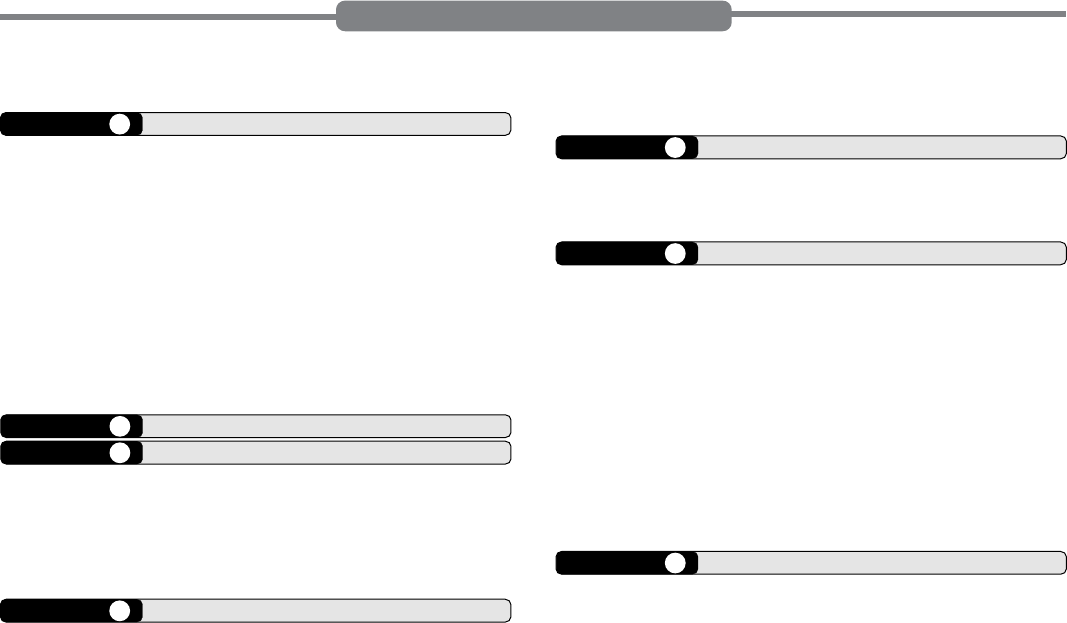
ii
CONTENTS
SELECTING A FREQUENCY .................................. 15
VFO MODE .......................................................... 15
MHz MODE .......................................................... 16
DIRECT FREQUENCY ENTRY ...................................... 16
CHAPTER 5MENU SETUP
WHAT IS A MENU? ................................................. 18
MENU ACCESS ...................................................... 18
MENU FUNCTION LIST .......................................... 19
CHAPTER 6OPERATING THROUGH REPEATERS
OFFSET PROGRAMMING FLOW ........................... 22
PROGRAMMING AN OFFSET ................................ 23
SELECTING AN OFFSET DIRECTION .............................. 23
SELECTING AN OFFSET FREQUENCY ............................ 23
ACTIVATING THE TONE FUNCTION ................................ 24
SELECTING A TONE FREQUENCY ................................. 24
AUTOMATIC REPEATER OFFSET .......................... 25
TRANSMITTING A 1750 Hz TONE .......................... 25
REVERSE FUNCTION ............................................ 26
AUTOMATIC SIMPLEX CHECK (ASC) .................... 26
TONE FREQUENCY ID SCAN ................................ 27
CHAPTER 7MEMORY CHANNELS
NUMBER OF MEMORY CHANNELS ...................... 28
SIMPLEX & REPEATER OR ODD-SPLIT
MEMORY CHANNEL? ............................................. 28
STORING SIMPLEX FREQUENCIES OR
STANDARD REPEATER FREQUENCIES ............... 29
STORING ODD-SPLIT REPEATER
FREQUENCIES ....................................................... 30
SUPPLIED ACCESSORIES ...................................... 1
WRITING CONVENTIONS FOLLOWED
IN THIS MANUAL ...................................................... 1
CHAPTER 1PREPARATION
MOBILE INSTALLATION ........................................... 2
DC POWER CABLE CONNECTION .......................... 3
Mobile Operation .................................................. 3
Fixed Station Operation ........................................ 4
Replacing Fuses ................................................... 5
ANTENNA CONNECTION ......................................... 5
ACCESSORY CONNECTIONS ................................. 6
External Speaker .................................................. 6
Microphone ........................................................... 6
PC Connection ..................................................... 6
CONNECTING TO A TNC (E MARKET MODELS ONLY).... 7
CHAPTER 2YOUR FIRST QSO
CHAPTER 3GETTING ACQUAINTED
FRONT PANEL .......................................................... 9
DISPLAY .................................................................. 10
REAR PANEL .......................................................... 12
MICROPHONE ........................................................ 12
MIC KEYPAD DIRECT ENTRY ...................................... 13
CHAPTER 4OPERATING BASICS
SWITCHING THE POWER ON/OFF ........................ 14
ADJUSTING THE VOLUME ..................................... 14
ADJUSTING THE SQUELCH .................................. 14
TRANSMITTING ...................................................... 15
SELECTING AN OUTPUT POWER ................................. 15
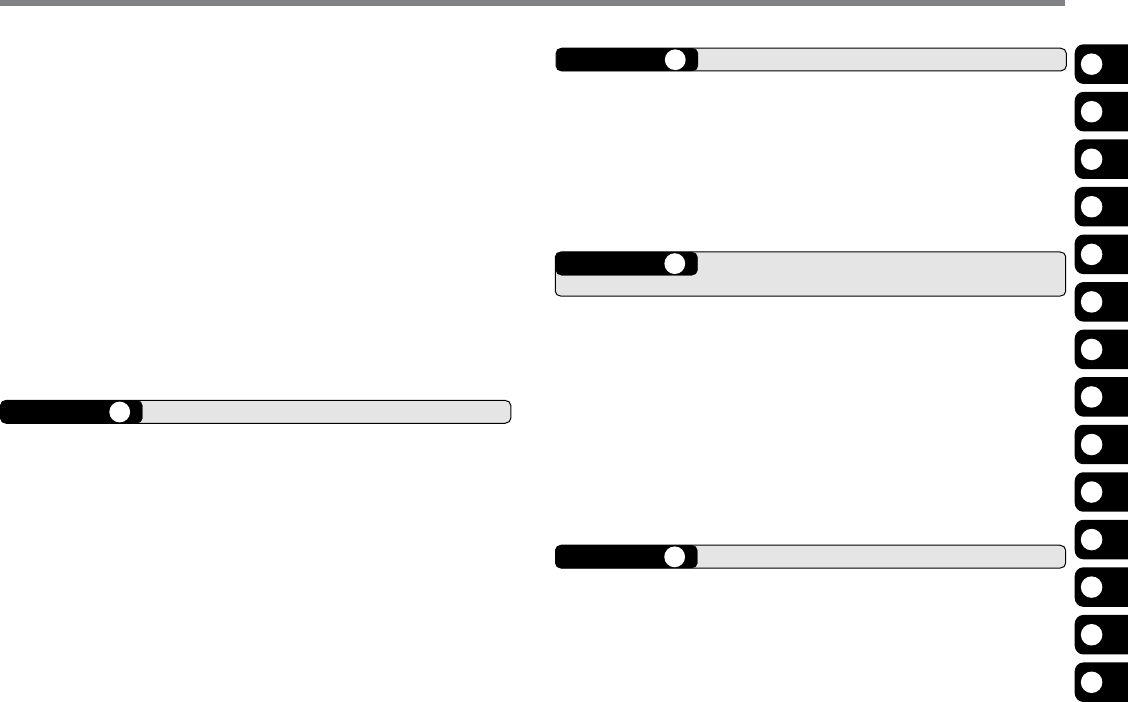
iii
1
2
3
4
5
6
7
8
9
10
11
12
13
14
SCAN RESUME METHOD ...................................... 45
CHAPTER 9SELECTIVE CALL
CTCSS AND DCS ................................................... 46
CTCSS .................................................................... 46
SELECTING A CTCSS FREQUENCY ............................ 47
CTCSS FREQUENCY ID SCAN ................................. 48
DCS ......................................................................... 48
SELECTING A DCS CODE ......................................... 48
DCS CODE ID SCAN .............................................. 49
CHAPTER 10 DUAL TONE MULTI-FREQUENCY
(DTMF) FUNCTIONS
MANUAL DIALING .................................................. 50
DTMF MONITOR .................................................... 50
DTMF TX HOLD ................................................... 51
AUTOMATIC DIALER .............................................. 51
STORING A DTMF NUMBER IN MEMORY ...................... 51
CONFIRMING STORED DTMF NUMBERS ...................... 52
TRANSMITTING A STORED DTMF NUMBER ................... 52
ADJUSTING THE DTMF TONE TRANSMISSION SPEED ...... 52
ADJUSTING THE PAUSE DURATION .............................. 53
DTMF LOCK ............................................................ 53
CHAPTER 11 AUXILIARY FUNCTIONS
APO (AUTO POWER OFF) ..................................... 54
BEAT SHIFT ............................................................ 54
S-METER SQUELCH .............................................. 54
SQUELCH HANG TIME .............................................. 55
BEEP FUNCTION .................................................... 55
BUSY CHANNEL LOCKOUT ................................... 56
RECALLING A MEMORY CHANNEL ....................... 30
USING THE TUNING CONTROL .................................... 30
USING THE MICROPHONE KEYPAD ............................... 31
CLEARING A MEMORY CHANNEL ......................... 31
NAMING A MEMORY CHANNEL ............................. 32
MEMORY CHANNEL TRANSFER ........................... 33
MEMORY \ VFO TRANSFER .................................... 33
CHANNEL \ CHANNEL TRANSFER .............................. 33
CALL CHANNEL ...................................................... 35
RECALLING THE CALL CHANNEL ................................. 35
REPROGRAMMING THE CALL CHANNEL ......................... 35
WEATHER ALERT (K MARKET MODELS ONLY)............. 36
PROGRAMMING THE WEATHER RADIO FREQUENCY ......... 36
ENABLING A WEATHER ALERT .................................... 36
CHANNEL DISPLAY ................................................ 37
CHAPTER 8SCAN
NORMAL SCAN ...................................................... 40
BAND SCAN ........................................................... 40
PROGRAM SCAN ..................................................... 40
MHz SCAN ........................................................... 41
MEMORY SCAN ...................................................... 42
ALL-CHANNEL SCAN ................................................ 42
GROUP SCAN ......................................................... 42
CALL SCAN ............................................................ 43
PRIORITY SCAN ..................................................... 43
PROGRAMMING A PRIORITY CHANNEL .......................... 43
USING PRIORITY SCAN ............................................. 44
MEMORY CHANNEL LOCKOUT ............................. 44
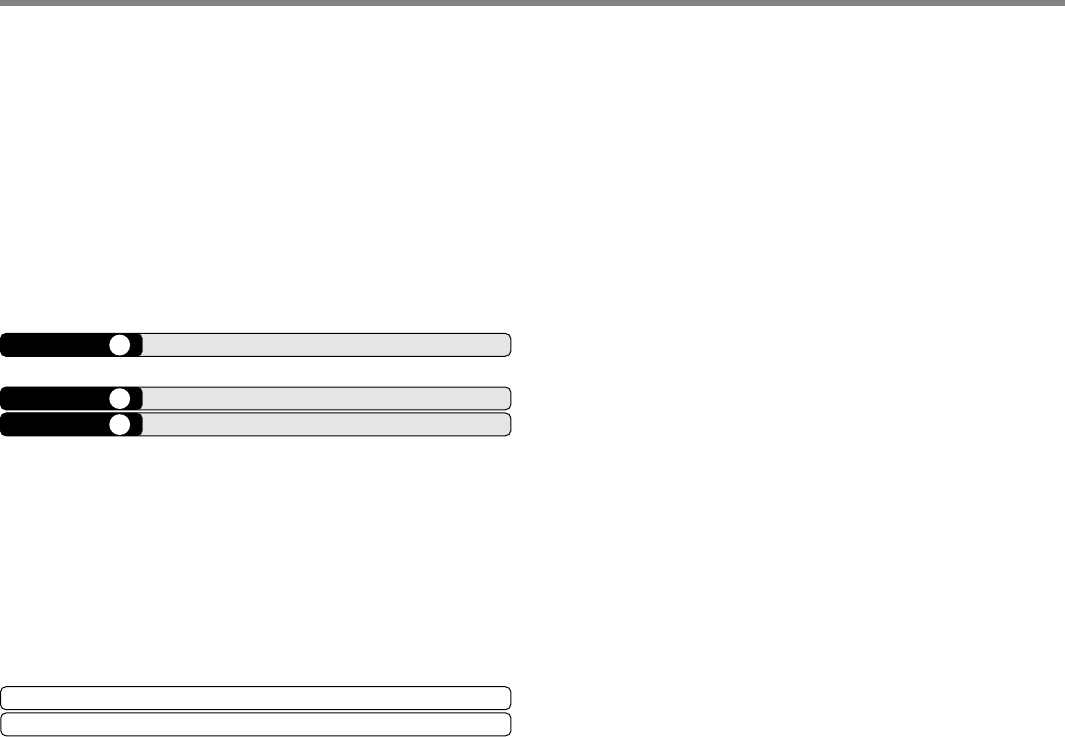
iv
FREQUENCY STEP SIZE ....................................... 56
DISPLAY BACKLIGHT ............................................. 57
PERMANENT BACKLIGHT ........................................... 57
AUTOMATIC BACKLIGHT ............................................. 57
LOCK FUNCTION ................................................... 58
DATA COMMUNICATION SPEED ........................... 58
TUNE ENABLE ........................................................ 58
MICROPHONE PF KEYS (KEYPAD MODELS ONLY)...... 59
NARROW BAND FM OPERATION .......................... 60
POWER-ON MESSAGE .......................................... 60
PROGRAMMABLE VFO .......................................... 60
TIME-OUT TIMER ................................................... 61
CHAPTER 12 MICROPHONE CONTROL
MIC LOCK ............................................................... 64
CHAPTER 13 OPTIONAL ACCESSORIES
CHAPTER 14 TROUBLESHOOTING
MAINTENANCE ...................................................... 66
GENERAL INFORMATION ............................................ 66
SERVICE ................................................................ 66
SERVICE NOTE ....................................................... 66
CLEANING .............................................................. 67
RESETTING THE TRANSCEIVER .......................... 67
INITIAL SETTINGS ..................................................... 67
FULL RESET ........................................................... 67
VFO RESET .......................................................... 68
TROUBLESHOOTING ............................................. 69
SPECIFICATIONS
INDEX

1
SUPPLIED ACCESSORIES
After carefully unpacking the transceiver, identify the
items listed in the table below. We recommend you keep
the box and packaging for shipping.
A market area code (K, E, or M2) can be found on the
label attached to the package box.
yrosseccA rebmuNtraP ytQ
enohporciM
tekram2M
)03-CMK( XX-4260-19T
1
tekramE,K
)23-CMK( XX-1460-19T
rewopCD
elbac
tekram2M,KXX-1112-03E 1
tekramEXX-2543-03E
esuF tekram2M,KXX-7100-15F 1
tekramEXX-4200-25F
tekcarbgnitnuoMXX-2660-92J1
regnahenohporciMXX-4851-91J1
teswercSXX-5930-99N1
)ylnotekramE,K(dracytnarraW—1
launamnoitcurtsnIXX-8371-26B1
WRITING CONVENTIONS FOLLOWED IN THIS MANUAL
The writing conventions described below have been
followed to simplify instructions and avoid unnecessary
repetition.
noitcurtsnI odottahW
sserP ]YEK[ .esaelerdnasserP YEK .
sserP
)s1(]YEK[ .
dlohdnasserP YEK rodnoces1rof
.regnol
sserP
]1YEK[ ,]2YEK[ .
sserP 1YEK esaeler,yliratnemom
1YEK sserpneht, 2YEK .
sserP
]2YEK[+]1YEK[ .
dlohdnasserP 1YEK sserpneht,
2YEK owtnahteromeraerehtfI.
niyekhcaedlohdnasserp,syek
neebsahyeklanifehtlitnunrut
.desserp
sserP
][+]YEK[ .
,FFOrewopreviecsnartehthtiW
dlohdnasserp YEK ehtnrutneht,
gnisserpybNOrewopreviecsnart
][ .)hctiwSrewoP(
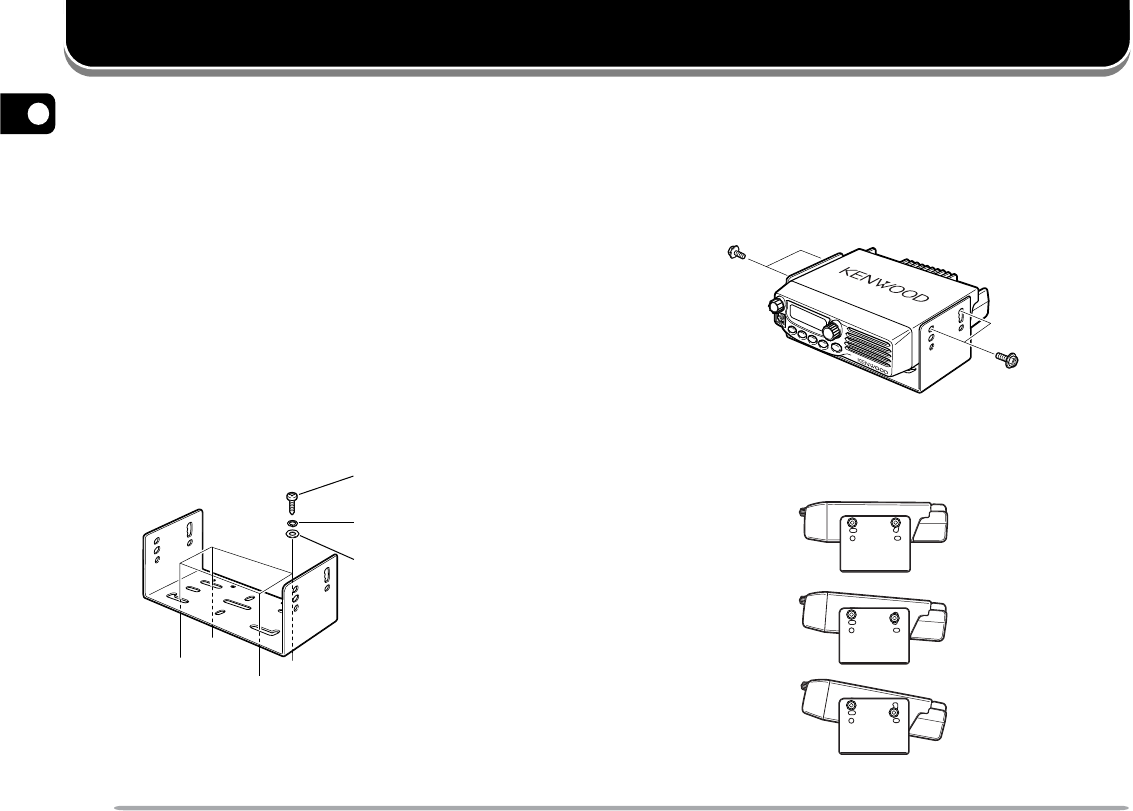
2
1
PREPARATION
2Position the transceiver, then insert and tighten
the supplied hexagon SEMS screws (4) and flat
washers (4).
•Double check that all hardware is tightened to prevent
vehicle vibration from loosening the bracket or
transceiver.
•Determine the appropriate angle of the transceiver,
using the 3 screw hole positions on the side of the
mounting bracket.
MOBILE INSTALLATION
To install the transceiver, select a safe, convenient
location inside your vehicle that minimizes danger to
your passengers and yourself while the vehicle is in
motion. Consider installing the unit at an appropriate
position so that knees or legs will not strike it during
sudden braking of your vehicle. Try to pick a well
ventilated location that is shielded from direct sunlight.
1Install the mounting bracket in the vehicle using the
supplied self-tapping screws (4), flat washers (4), and
spring washers (4).
•The bracket must be installed so that the 3 screw hole
positions on the side of the mounting bracket are
towards the rear of the bracket.
Self-tapping screw
(5 mm x 16 mm)
Flat washer
SEMS
screw
Spring washer
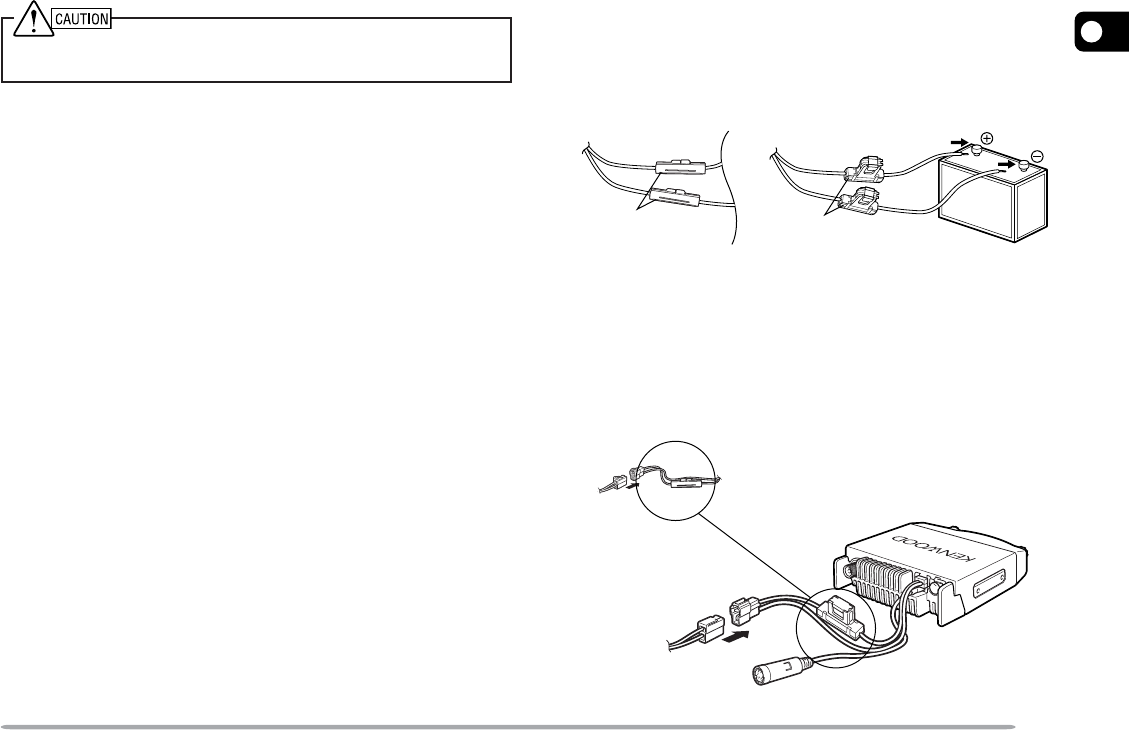
3
1
4Confirm the correct polarity of the connections, then
attach the power cable to the battery terminals; red
connects to the positive (+) terminal and black
connects to the negative (–) terminal.
•Use the full length of the cable without cutting off excess
even if the cable is longer than required. In particular,
never remove the fuse holders from the cable.
5Reconnect any wiring removed from the negative
terminal.
6Connect the DC power cable to the transceiver’s
power supply connector.
•Press the connectors firmly together until the locking tab
clicks.
DC POWER CABLE CONNECTION
Locate the power input connector as close to the transceiver as
possible.
MOBILE OPERATION
The vehicle battery must have a nominal rating of 12 V.
Never connect the transceiver to a 24 V battery. Be sure
to use a 12 V vehicle battery that has sufficient current
capacity. If the current to the transceiver is insufficient,
the display may darken during transmission, or transmit
output power may drop excessively.
1Route the DC power cable supplied with the
transceiver directly to the vehicle’s battery terminals
using the shortest path from the transceiver.
•If using a noise filter, it should be installed with an
insulator to prevent it from touching metal on the vehicle.
•We recommend you do not use the cigarette lighter
socket as some cigarette lighter sockets introduce an
unacceptable voltage drop.
•The entire length of the cable must be dressed so it is
isolated from heat, moisture, and the engine secondary
(high voltage) ignition system/ cables.
2After the cable is in place, wrap heat-resistant tape
around the fuse holder to protect it from moisture and
tie down the full run of cable.
3To prevent the risk of short circuits, disconnect other
wiring from the negative (–) battery terminal before
connecting the transceiver.
Red
Black
Fuse holder
Fuse holder
Fuse holder
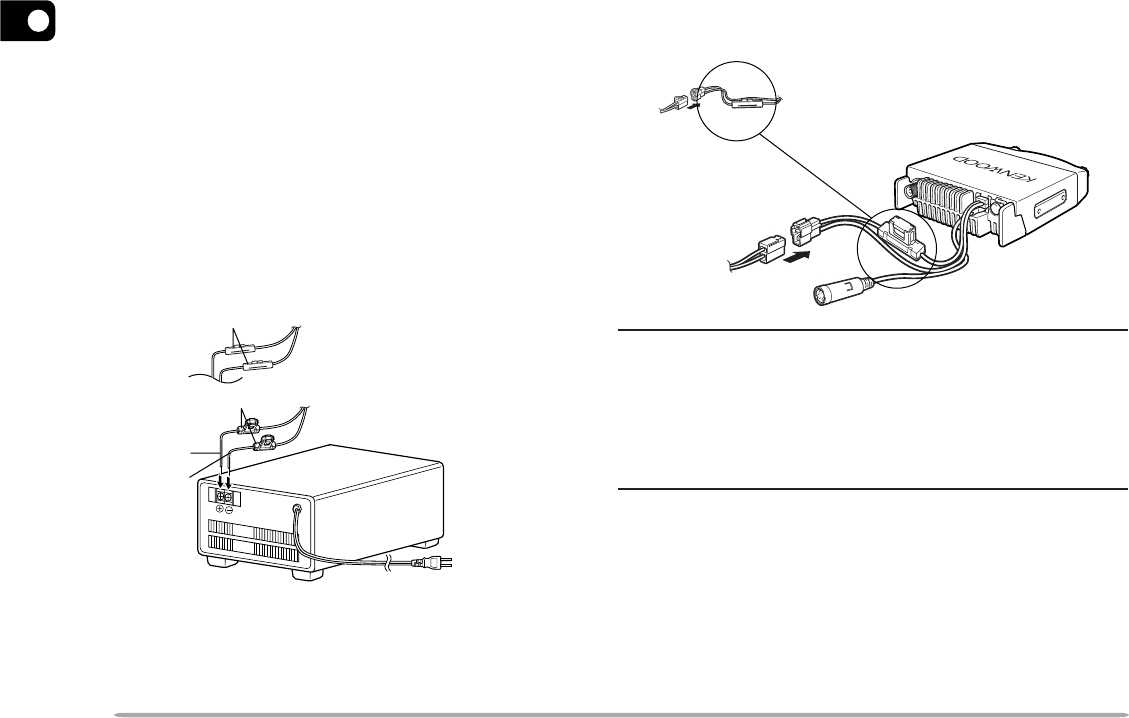
4
1
2Connect the transceiver’s DC power connector to the
connector on the DC power cable.
•Press the connectors firmly together until the locking tab
clicks.
Note:
◆For your transceiver to fully exhibit its performance capabilities,
we recommend using the optional PS-33 (20.5 A, 25% duty cycle)
power supply.
◆Before connecting the DC power supply to the transceiver, be
sure to switch the transceiver and the DC power supply OFF.
◆Do not plug the DC power supply into an AC outlet until you make
all connections.
FIXED STATION OPERATION
In order to use this transceiver for fixed station operation,
you will need a separate 13.8 V DC power supply (not
included). The recommended current capacity of your
power supply is 12 A.
1Connect the DC power cable to the regulated DC
power supply and ensure that the polarities are
correct (Red: positive, Black: negative).
•Do not directly connect the transceiver to an AC outlet.
•Use the supplied DC power cable to connect the
transceiver to a regulated power supply.
•Do not substitute a cable with smaller gauge wires.
To AC outlet
Regulated DC
power supply
Black (–)
Red (+)
Fuse holder
Fuse holder
Fuse holder
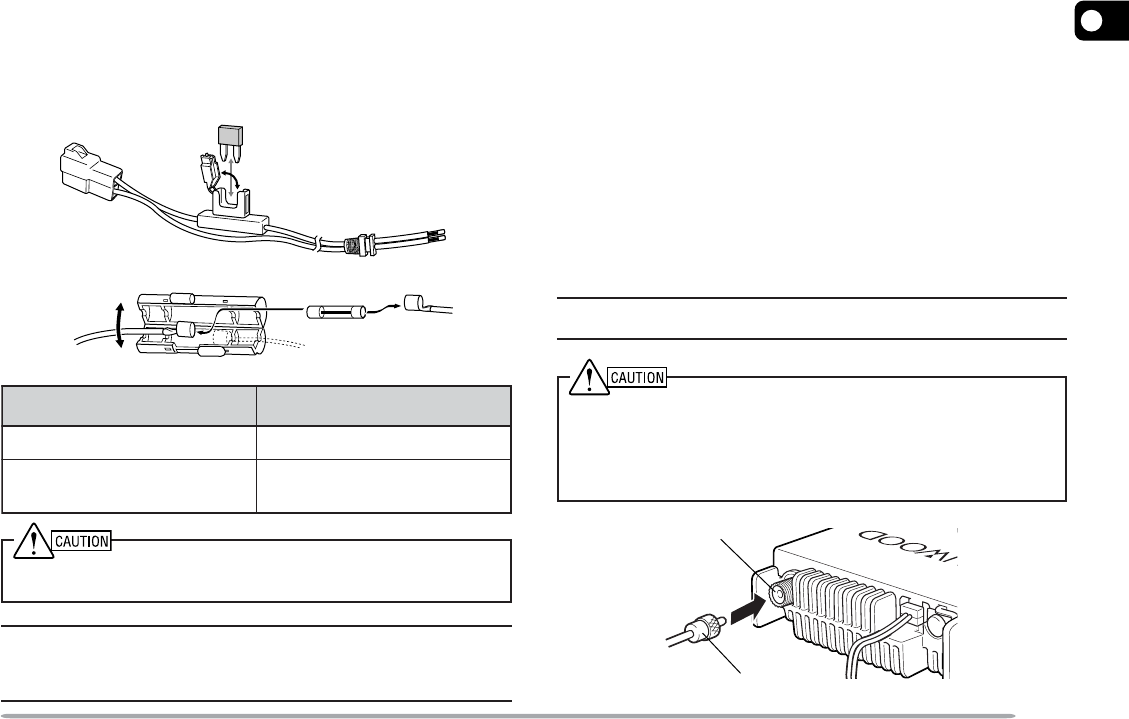
5
1
REPLACING FUSES
If the fuse blows, determine the cause, then correct the
problem. After the problem is resolved, replace the fuse.
If newly installed fuses continue to blow, disconnect the
power cable and contact your authorized KENWOOD
dealer or an authorized KENWOOD service center for
assistance.
noitacoLesuF gnitaRtnerruCesuF
reviecsnarTA51
yrosseccAdeilppuS
elbaCrewoPCD A02
Only use fuses of the specified type and rating; otherwise the
transceiver could be damaged.
Note: If you use the transceiver for a long period when the vehicle
battery is not fully charged, or when the engine is OFF, the battery
may become discharged, and will not have sufficient reserves to start
the vehicle. Avoid using the transceiver under these conditions.
ANTENNA CONNECTION
Before operating, install an efficient, well-tuned antenna.
The success of your installation will depend largely on
the type of antenna and its correct installation. The
transceiver can give excellent results if the antenna
system and its installation are given careful attention.
Use a 50 Ω impedance antenna and low-loss coaxial
feed line that has a characteristic impedance of 50 Ω, to
match the transceiver input impedance. Coupling the
antenna to the transceiver via feed lines having an
impedance other than 50 Ω reduces the efficiency of the
antenna system and can cause interference to nearby
broadcast television receivers, radio receivers, and other
electronic equipment.
Note: E market models use an N-type antenna connector while other
models use an M-type (SO-239) connector.
◆Transmitting without first connecting an antenna or other matched
load may damage the transceiver. Always connect the antenna to
the transceiver before transmitting.
◆All fixed stations should be equipped with a lightning arrester to
reduce the risk of fire, electric shock, and transceiver damage.
Feed line connector
Antenna connector
To antenna
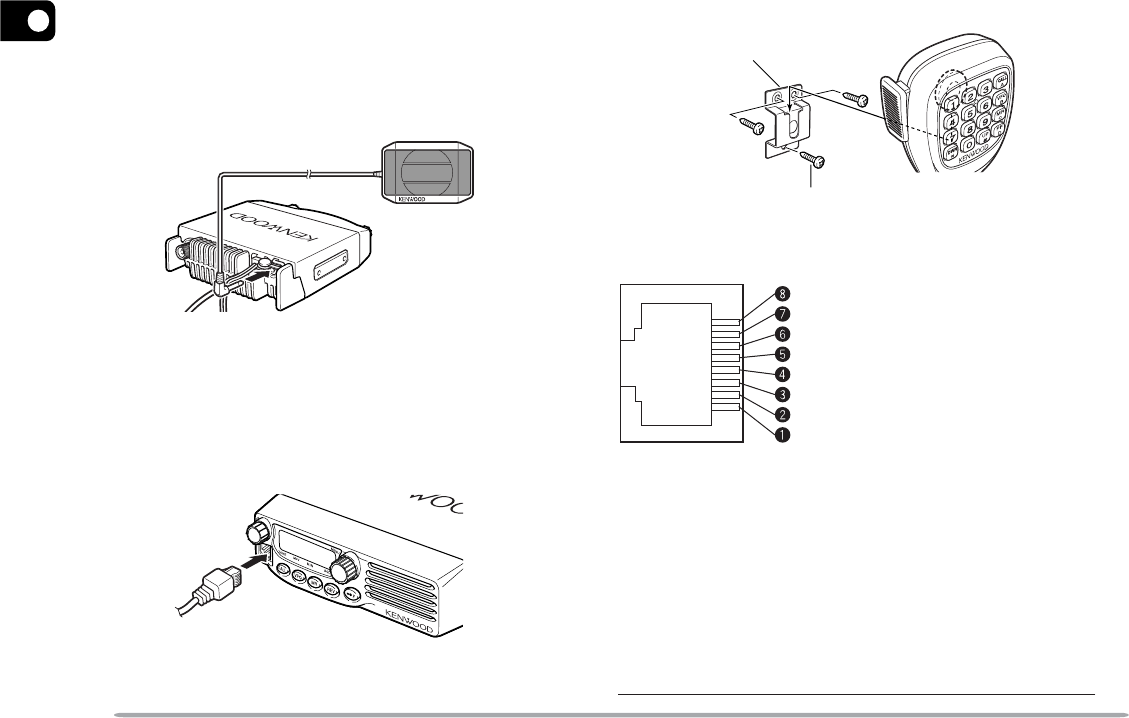
6
1
ACCESSORY CONNECTIONS
EXTERNAL SPEAKER
If you plan to use an external speaker, choose a speaker
with an impedance of 8 Ω. The external speaker jack
accepts a 3.5 mm (1/8") mono (2-conductor) plug. We
recommend using the SP-50B speaker.
MICROPHONE
For voice communications, connect a 600 Ω microphone
equipped with an 8-pin modular plug into the modular
socket on the front of the main unit. Press firmly on the
plug until the locking tab clicks.
Attach the supplied microphone hanger in an appropriate
location using the screws included in the screw set.
Microphone hanger
Microphone
hanger screw
(3 mm x 10 mm)
CM
HOOK
MIC
ME
PTT
E
PSB
BLC
PC CONNECTION
To utilize the optional MCP-1A software, you must first
connect the transceiver to your PC using the KPG-46
Programming Cable (via the microphone jack).
The MCP-1A is free downloadable software available
from KENWOOD at the following URL:
http://www.kenwood.com/i/products/info/amateur.html

7
1
CONNECTING TO A TNC (E MARKET MODELS ONLY)
To connect an external TNC to the transceiver, use an
optional PG-5A cable. The DATA connector on the rear
of the transceiver mates with the 6-pin mini-DIN plug on
this cable.
.oNniP emaNniP noitcnuF
1GKP tupniatadtekcaP
•reviecsnartotCNTmorfatadXT
2DNGGKProfdnuorG
3SKP
ybdnatstekcaP
•ehttibihniotnipsihtesunacCNT
tupnienohporcimreviecsnart
.slangistekcapgnittimsnartelihw
49RP
spb0069detcetedfotuptuO
Vm005(atad
P-P
k01, Ω)
•nipnommocasasnoitcnufoslA
atadspb0069dnaspb0021rof
.tuptuo
51RP spb0021detcetedfotuptuO
Vm005(atad
P-P
k01, Ω)
6CQS
tuptuolortnochcleuqS
•gnittimsnartatadCNTstibihnI
.neposihcleuqsreviecsnartelihw
•eciovotecnerefretnistneverP
emasehtnosnoitacinummoc
.seirterstneverposlA.ycneuqerf
•leveLtuptuO
)hgiH(V5+:hcleuqsnepO
)woL(V0:hcleuqsdesolC
Note:
◆If the external TNC has a common pin for 1200 bps and 9600 bps
data output, connect this pin to the DATA connector PR9 pin.
Shorting the PR9 and PR1 pins will cause the TNC to malfunction.
◆Adjust the transceiver data communication speed (1200 bps or
9600 bps) as necessary {page 58}.
◆If DC voltage is input to the PR1 pin, the external TNC may not
function. If this problem happens, add a 10 µF capacitor between
the PR1 pin and the TNC. Be careful with the polarity of the
capacitor.
GND
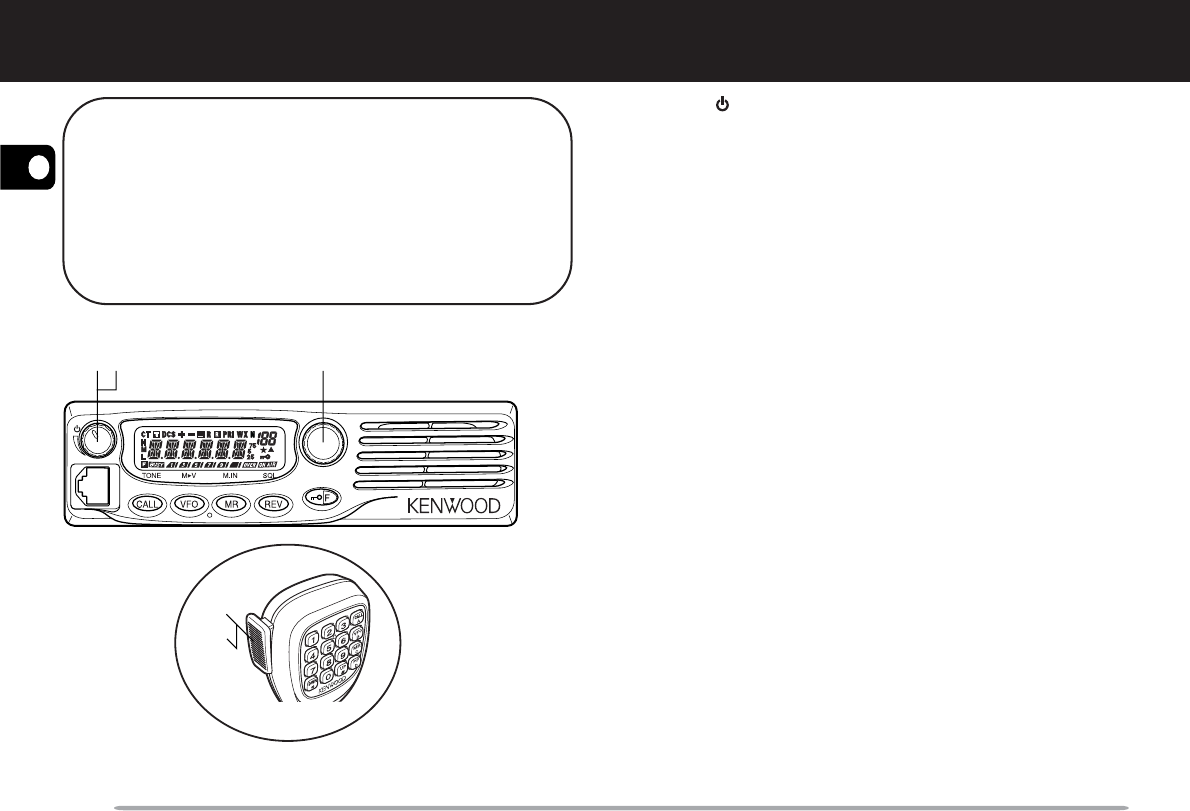
8
2
YOUR FIRST QSO
Are you ready to give your transceiver a quick try?
Reading this section should get your voice on the
air right away. The instructions below are intended
only as a quick guide. If you encounter problems
or there is something you would like to know more,
read the detailed explanations given later in this
manual.
YOUR FIRST QSO
qPress [ ] (Power) briefly to switch the transceiver
power ON.
•A high pitched double beep sounds and a Power-on
message appears momentarily. The various indicators
and the current operating frequency appear on the LCD.
•The transceiver stores the current parameters when it is
turned OFF and automatically recalls those parameters
the next time you turn the transceiver ON.
wTurn the Volume control clockwise, to the 9 o’clock
position.
eTurn the Tuning control to select a reception
frequency.
•You may further turn the Volume control to adjust the
volume level of the signal.
rTo transmit, hold the microphone approximately 5 cm
(2 inches) from your mouth.
tPress and hold Mic [PTT], then speak in your normal
tone of voice.
yRelease Mic [PTT] to receive.
uRepeat steps r, t, and y to continue
communication.
TM-271 MENU
qw e
t
y
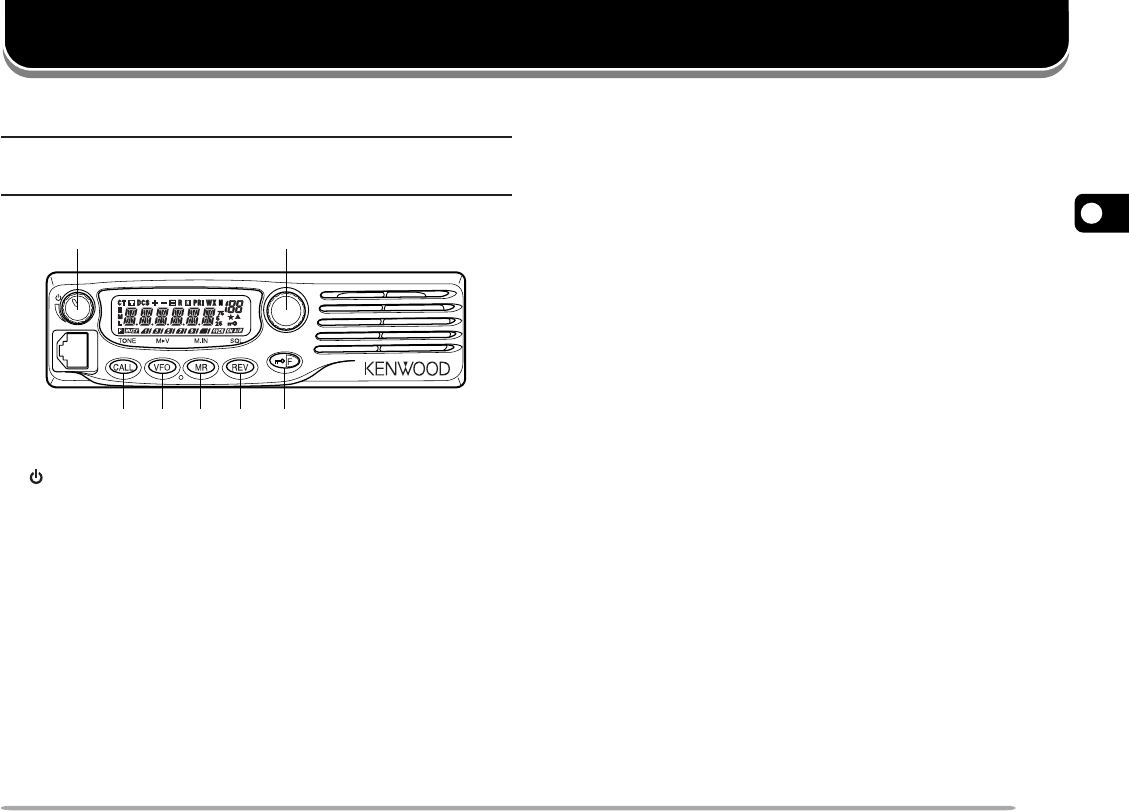
9
3
GETTING ACQUAINTED
FRONT PANEL
Note: This section describes only the main functions of the front
panel controls. Explanations for functions not described here are
provided in the appropriate sections of this instruction manual.
q w
e r t y u
TM-271
MENU
qq
qq
q (Power) switch/ Volume control
Press to switch the transceiver power ON or OFF
{page 14}.
Turn to adjust the level of the receive audio from the
speaker {page 14}.
ww
ww
wMENU button/ Tuning control
Press to enter MHz Mode {page 16}. In this mode,
you can change the operating frequency in 1 MHz
steps using the Tuning control or Mic [UP]/[DWN].
Press and hold for 1 second while in VFO Mode to
begin MHz Scan {page 41} or while in MR Mode to
begin Group Scan {page 42}.
Press [F] then press [MENU] to enter Menu Mode
{page 18}.
Turn to select:
•Operating frequencies when in VFO Mode {page 15}.
•Memory Channels when in Memory Recall Mode
{page 30}.
•Menu Nos. when in Menu Mode {page 18}.
•Scan direction while scanning {pages 27, 39, 47, 49}.
ee
ee
eCALL key
Press to recall the Call Channel {page 35}. Press
and hold for 1 second while in VFO Mode to begin
Call/VFO Scan {page 43}. Press and hold for
1 second while in Memory Recall Mode to begin Call/
Memory Scan {page 43}.
Press [F] then press [CALL] to activate the Tone
{page 24}, CTCSS {page 46}, or DCS {page 48}
function.
rr
rr
rVFO key
Press to enter VFO Mode {page 15}. In this mode,
you can change the operating frequency using the
Tuning control or Mic [UP]/[DWN]. Press and hold
for 1 second while in VFO Mode to begin Band Scan
{page 40}. Press and hold for 1 second while in VFO
Mode after programming a scan range to begin
Program Scan {page 40}.
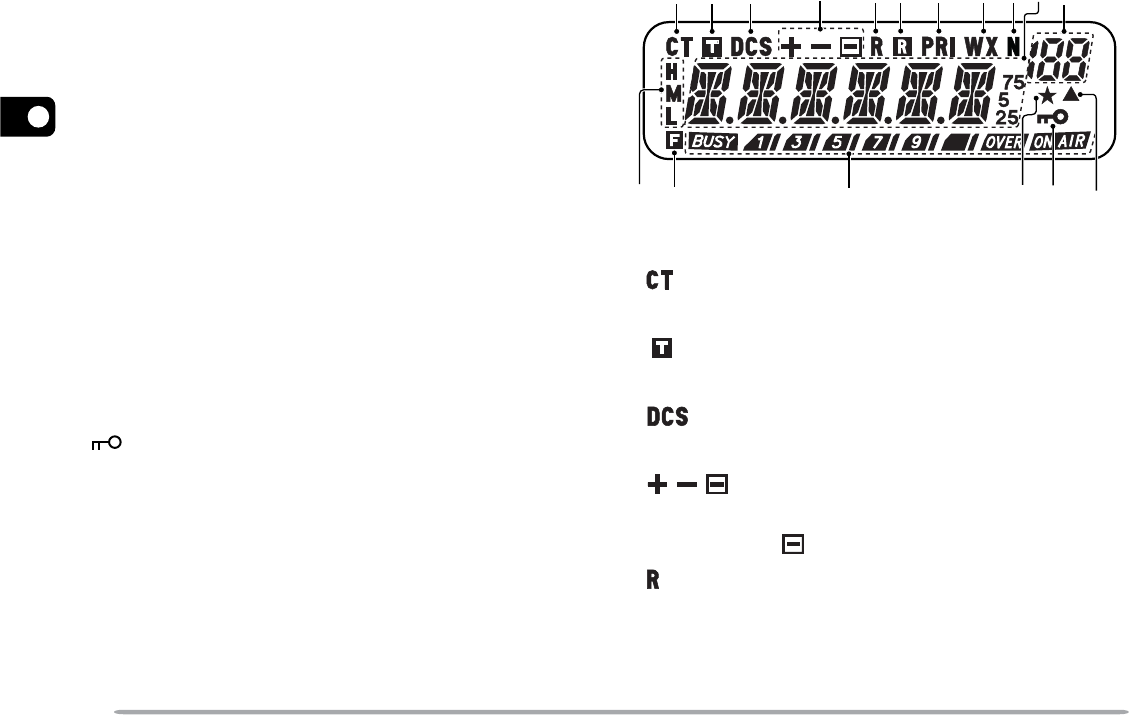
10
3
In MR Mode, press [F] then press [VFO] to transfer
the contents of the selected Memory Channel to the
VFO {page 33}.
tt
tt
tMR key
Press to enter Memory Recall Mode {page 30}. In
this mode, you can change memory channels using
the Tuning control or Mic [UP]/[DWN]. Press and
hold for 1 second while in Memory Recall Mode to
begin Memory Scan {page 42}.
Press [F] then press [MR] to reprogram the Call
Channel or a Memory Channel.
yy
yy
yREV key
Press to switch the transmit frequency and receive
frequency when operating with an offset {page 23} or
an odd-split Memory Channel {page 28}.
Press [F] then press [REV] and rotate the Tuning
control to increase or decrease the squelch level.
uu
uu
u/F key
Press and hold for 1 second to lock the transceiver
keys.
Press momentarily to access the second functions of
the transceiver keys.
DISPLAY
i
u
y
t
r
qwe!1
!2
!4 !3
o
!5
!6!7
!0
q
Appears when the CTCSS function is activated {page 46}.
w
Appears when the Tone function is activated {page 24}.
e
Appears when the DCS function is activated {page 48}.
r
Appears when the repeater shift function is activated
{pages 23, 30}. (“ ” is not used on this transceiver.)
t
Appears when the Reverse function is activated {page 26}.
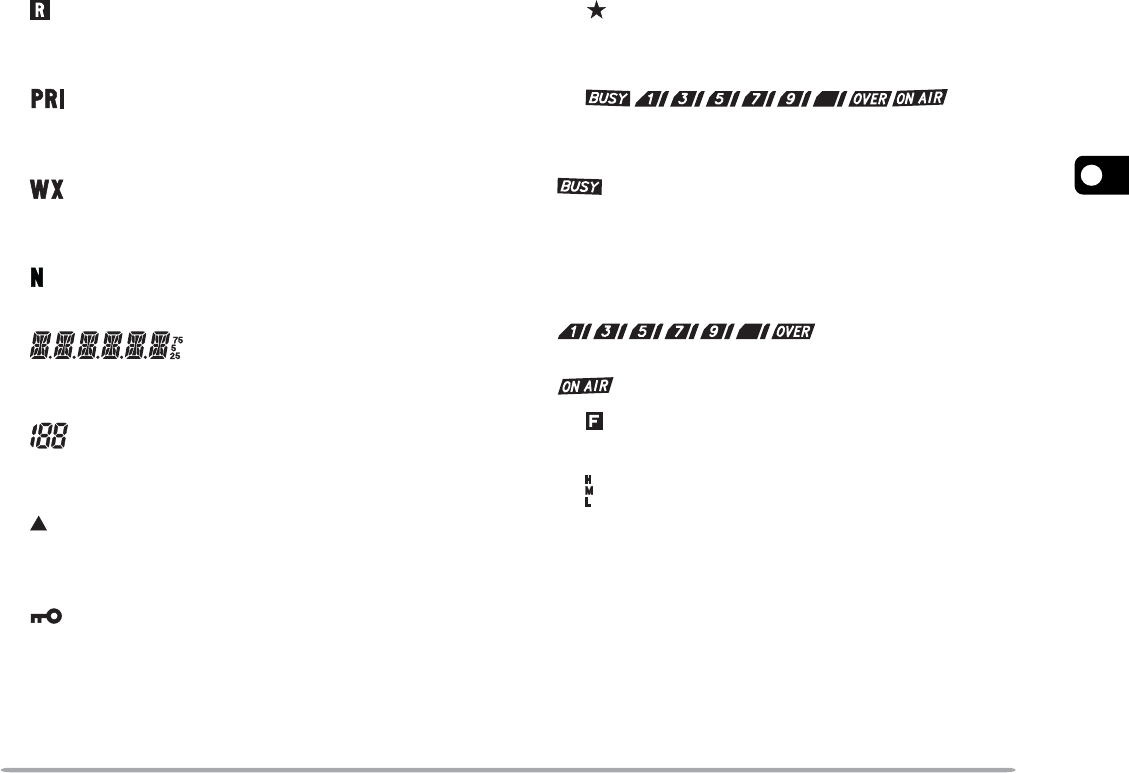
11
3
y
Appears when the Automatic Simplex Check (ASC)
function is activated {page 26}.
u
Appears when the Priority Scan function is activated
{page 43}.
i
Appears when the Weather Alert function is activated
{page 36}. (K market models only.)
o
Appears when narrow FM Mode is selected {page 60}.
!0
Displays the frequencies, Menu settings, Memory name
and other information.
!1
Displays the Menu No., Memory Channel number, and
status {pages 18, 29}.
!2
Appears when the displayed Memory Channel has data
{page 29}.
!3
Appears when the Key Lock function is ON {page 58}.
!4
Appears when the Memory Channel Lockout function is
ON {page 44}.
!5
Shows the strength of transmitted {page 15} and received
{page 54} signals.
indicates the squelch is open and the frequency is
“busy”. It also appears when the squelch is set to
minimum {page 14}. If using CTCSS or DCS, it indicates
the squelch is open due to a received signal that
contains the same CTCSS tone or DCS code that is set
in your transceiver.
acts as an S-meter while
receiving and an RF power meter while transmitting.
indicates the transceiver is transmitting.
!6
Appears when the function key is pressed.
!7
H appears when high power transmission is selected
and L appears when low power is selected {page 15}.
(“M” is not used on this transceiver.)
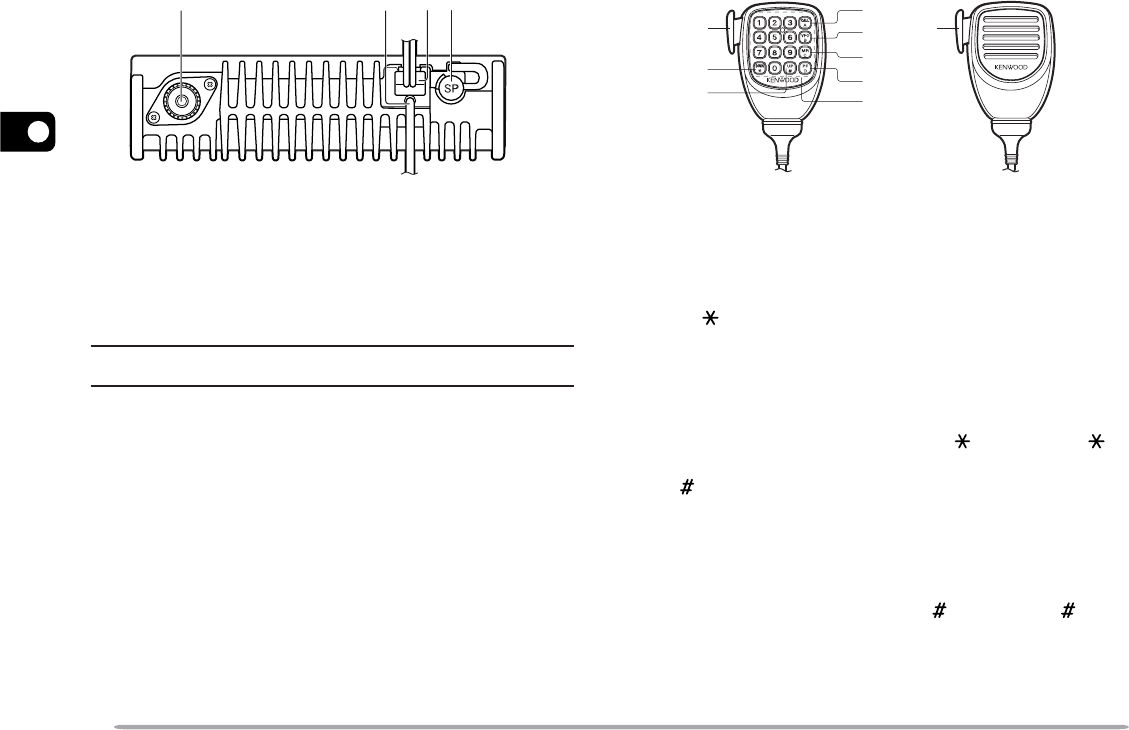
12
3
REAR PANEL
q w e r
qq
qq
qAntenna connector
Connect an external antenna {page 5} here. When
making test transmissions, connect a dummy load in
place of the antenna. The antenna system or load
should have an impedance of 50 Ω.
Note: E market models use an N-type antenna connector while
other models use an M-type (SO-239) connector.
ww
ww
wData cable (E market versions only)
Connect this cable to a TNC {page 7}.
ee
ee
ePower Input 13.8 V DC cable
Connect a 13.8 V DC power source here. Use the
supplied DC power cable {pages 3, 4}.
rr
rr
rSP (speaker) jack
If desired, connect an optional external speaker for
clearer audio. This jack accepts a 3.5 mm (1/8")
mono (2-conductor) plug. See page 6.
MICROPHONE
qq
r
t
y
u
i
w
e
qq
qq
qPTT (Push-to-Talk) switch
Press and hold to transmit. Release to receive.
ww
ww
wDWN/ key
Press to lower the operating frequency, Memory
Channel number, Menu Number, etc. Hold down to
repeat the action. Also press to switch between
values for functions with multiple choices. Press and
hold Mic [PTT], then press [DWN/ ] to transmit .
ee
ee
eUP/ key
Press to raise the operating frequency, Memory
Channel number, Menu Number, etc. Hold down to
repeat the action. Also press to switch between
values for functions with multiple choices. Press and
hold Mic [PTT], then press [UP/ ] to transmit .
KMC-32 KMC-30

13
3
rr
rr
rCALL/A key
Identical to the front panel CALL key. This key can
be reprogrammed if desired {page 59}. Press and
hold Mic [PTT], then press [CALL/A] to transmit A.
tt
tt
tVFO/B key
Identical to the front panel VFO key. This key can be
reprogrammed if desired {page 59}. Press and hold
Mic [PTT], then press [VFO/B] to transmit B.
yy
yy
yMR/C key
Identical to the front panel MR key. This key can be
reprogrammed if desired {page 59}. Press and hold
Mic [PTT], then press [MR/C] to transmit C.
uu
uu
uPF/D key
The default function of this key is 1 MHz step. This
key can be reprogrammed if desired {page 59}.
Press and hold Mic [PTT], then press [PF/D] to
transmit D.
ii
ii
iDTMF keypad
This 16-key keypad is used for DTMF functions
{page 50} or to directly enter an operating frequency
{page 16}, or a Memory Channel number {page 30}.
The keypad can also be used to program a Memory
Channel name, Power-on message, or other
character strings {page 63}.
MIC KEYPAD DIRECT ENTRY
The microphone keypad (keypad models only) allows
you to make various entries depending on which mode
the transceiver is in.
In VFO or Memory Recall mode, use the Mic keypad to
select a frequency {page 16} or Memory Channel
number {page 30}. First press the Mic PF key assigned
the ENTER function {page 59}.
To manually send a DTMF number, press and hold Mic
[PTT], then press the DTMF keys on the Mic keypad
{page 50} in sequence.
You can also use the Mic keypad to program a Memory
Channel name, Power-on message, or other character
strings {page 63}.
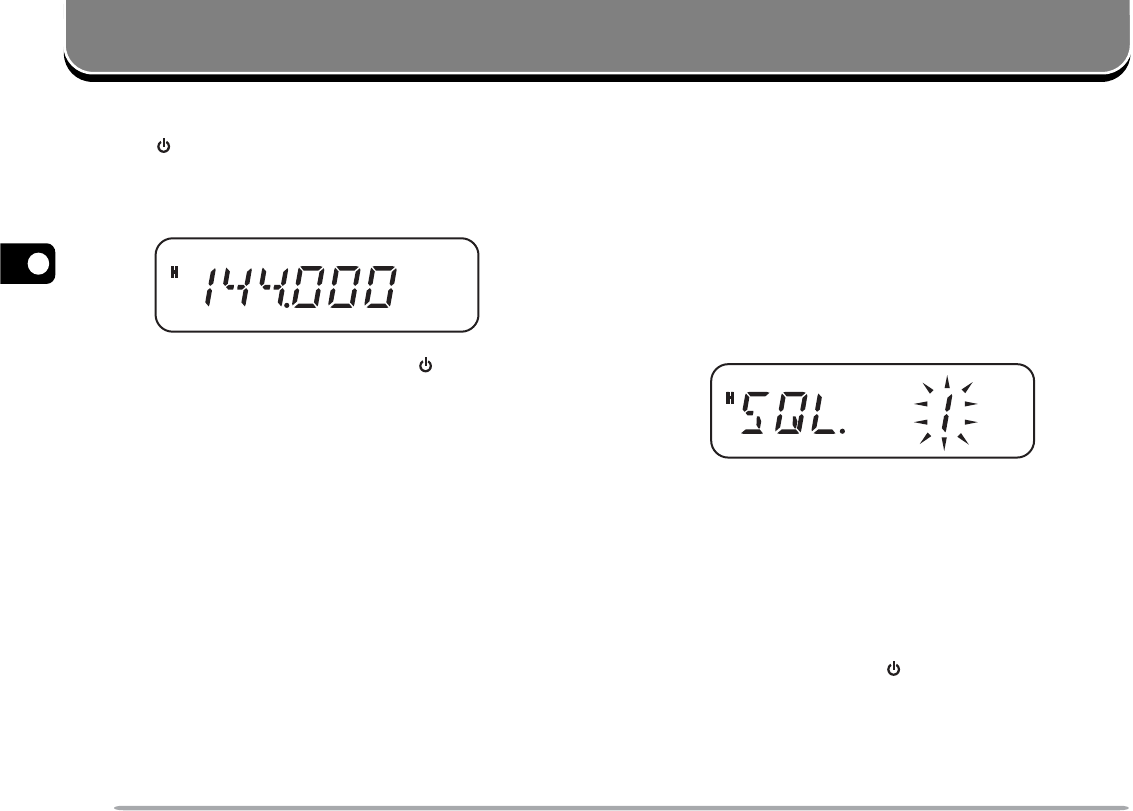
14
4
OPERATING BASICS
SWITCHING THE POWER ON/OFF
1Press [ ] (Power) to switch the transceiver power ON.
•A high pitched double beep sounds and a Power-on
message {page 60} appears briefly, followed by the
frequency and other indicators.
2To switch the transceiver OFF, press [ ] (Power) (1s).
•When you turn the transceiver OFF, a low pitched
double beep sounds.
•The transceiver stores the current frequency and
parameters when it is turned OFF and recalls these
parameters the next time you turn the transceiver ON.
ADJUSTING THE VOLUME
Turn the Volume control clockwise to increase the audio
output level and counterclockwise to decrease the output
level.
•If you are not receiving a signal, press the Mic PF key
assigned the MONI function {page 59}, then adjust the
Volume control to a comfortable audio output level. Press
the MONI key again to cancel the Monitor function.
ADJUSTING THE SQUELCH
The purpose of Squelch is to mute the speaker when no
signals are present. With the squelch level correctly set,
you will hear sound only while actually receiving signals.
The higher the selected squelch level, the stronger the
signals must be to receive.
The appropriate squelch level depends on the ambient
RF noise conditions.
1Press [F], [REV].
•The current squelch level appears.
2Turn the Tuning control to adjust the level.
•Select the level at which the background noise is just
eliminated when no signal is present.
•The higher the level, the stronger the signals must be to
receive.
•10 different levels can be set.
(0: Minimum ~ 9: Maximum; 1 is the default value)
3Press any key other than [ ] (Power) to store the
new setting and exit the squelch adjustment.
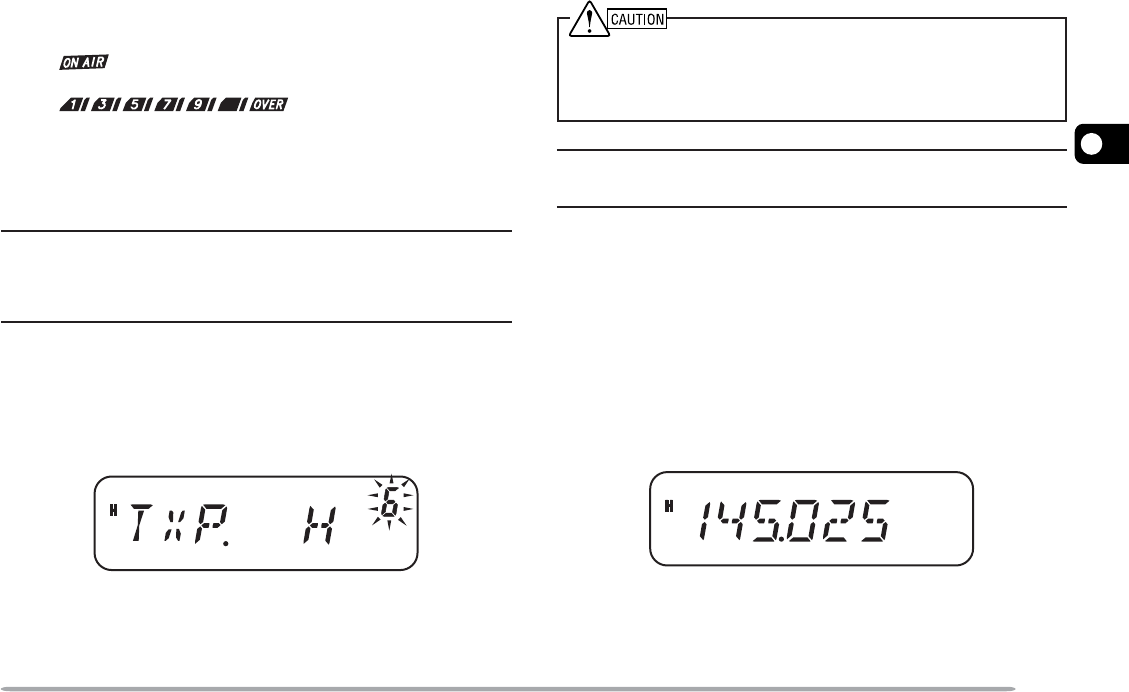
15
4
TRANSMITTING
1To transmit, hold the microphone approximately 5 cm
(2 inches) from your mouth, then press and hold Mic
[PTT] and speak into the microphone in your normal
tone of voice.
•“ ” and the RF Power meter appears. The RF
Power meter shows the relative transmit output power
().
•If you press Mic [PTT] while you are outside the
transmission coverage, a high pitched error beep
sounds.
2When you finish speaking, release Mic [PTT].
Note: If you continuously transmit for longer than the time specified in
Menu No. 21 (default is 10 minutes) {page 62}, the internal time-out
timer generates a warning beep and the transceiver stops transmitting.
In this case, release Mic [PTT] and let the transceiver cool down for a
while, then press Mic [PTT] again to resume transmission.
SELECTING AN OUTPUT POWER
You can configure different power levels for transmission.
1Press [F], [MENU] and turn the Tuning control to
select Menu No. 6 (TXP).
2Press [MENU] and turn the Tuning control to select
“H” (high; default) or “L” (low) power.
3Press [MENU] to store the setting or any other key to
cancel.
4Press any key other than [MENU] to exit Menu Mode.
◆Do not transmit at high output power for an extended period of
time. The transceiver could overheat and malfunction.
◆Continuous transmission causes the heat sink to overheat. Never
touch the heat sink when it may be hot.
Note: When the transceiver overheats because of ambient high
temperature or continuous transmission, the protective circuit may
function to lower transmit output power.
SELECTING A FREQUENCY
VFO MODE
This is the basic mode for changing the operating
frequency. To enter VFO Mode, press [VFO].
Turn the Tuning control clockwise to increase the
frequency and counterclockwise to decrease the
frequency, or use Mic [UP]/[DWN].

16
4
MHZ MODE
If the desired operating frequency is far away from the
current frequency, it is quicker to use the MHz Tuning
Mode.
To adjust the MHz digit:
1While in VFO or Call Mode, press [MENU].
•The MHz digit blinks.
2Turn the Tuning control to select the desired MHz
value.
3Press any key to set the selected frequency and
return to normal VFO Mode.
4Continue adjusting the frequency as necessary, using
the Tuning control or Mic [UP]/[DWN].
DIRECT FREQUENCY ENTRY
In addition to turning the Tuning control or pressing Mic
[UP]/[DWN], there is another way to select the
frequency. When the desired frequency is far away from
the current frequency, you can directly enter a frequency
using the Mic keypad (keypad models only).
1Press [VFO].
•You must be in VFO mode to make a direct frequency
entry.
2Press the Mic PF key assigned the ENTER function
{page 59}.
3Press the numeric keys ([0] to [9]) to enter your
desired frequency.
•Pressing Mic [Enter] fills all remaining digits (the digits
you did not enter) with 0 and completes the entry. For
example, to select 145.000 MHz, press [1], [4], [5] and
press Mic [Enter] to complete the entry.
•If you want to revise the MHz digits only, leaving the kHz
digits as they are, press Mic [VFO] in place of [Enter].

17
4
Example 1
To enter 145.750 MHz:
Key in Display
[Enter] – –– –––
[1], [4], [5] 1 4 5. – – –
[7], [5], [0] 1 4 5. 7 5 0
Example 2
To enter 145.000 MHz:
Key in Display
[Enter] – –– –––
[1], [4], [5] 1 4 5. – – –
[Enter] 1 4 5. 0 0 0
Example 3
To change 144.650 MHz to 145.650 MHz:
Key in Display
1 4 4. 6 5 0
[Enter] – –– –––
[1], [4], [5] 1 4 5. – – –
Mic [VFO] 1 4 5. 6 5 0
Note: If the entered frequency does not match the current frequency
step size, the frequency is automatically rounded down to the next
available frequency. When the desired frequency cannot be entered
exactly, confirm the frequency step size {page 56}.
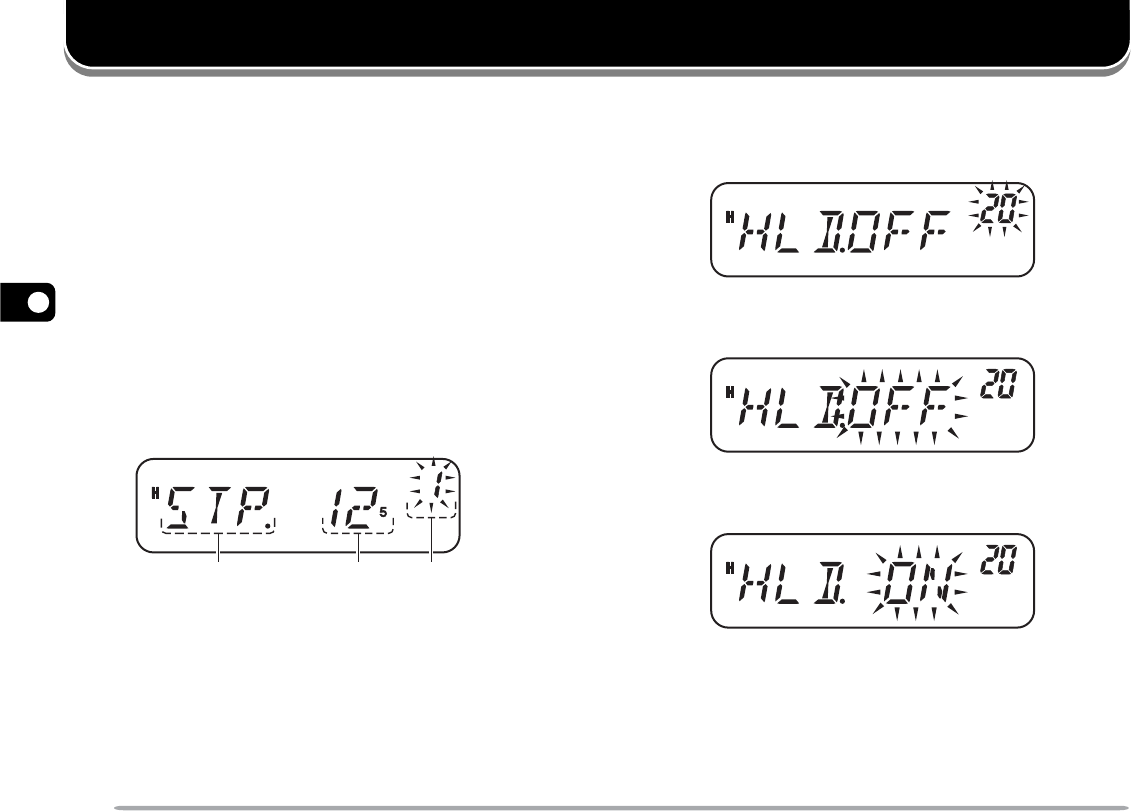
18
5
MENU SETUP
WHAT IS A MENU?
Many functions on this transceiver are selected or
configured via a software-controlled Menu rather than
through the physical controls of the transceiver. Once
you become familiar with the Menu system, you will
appreciate its versatility. You can customize the various
timings, settings, and programming functions on this
transceiver to meet your needs without using many
controls and switches.
MENU ACCESS
1Press [F], [MENU].
•A brief explanation of the menu, and the setting and
Menu No. appear on the display.
Menu Name Setting Menu Number
2Turn the Tuning control to select your desired Menu.
•As you change the Menu No., a brief explanation of
each menu appears along with its current parameter.
3Press [MENU] to configure the parameter of the
currently selected Menu No.
4Turn the Tuning control to select your desired
parameter.
5Press [MENU] to store the new setting or any other
key to cancel.
6Press any key other than [MENU] to exit Menu Mode.
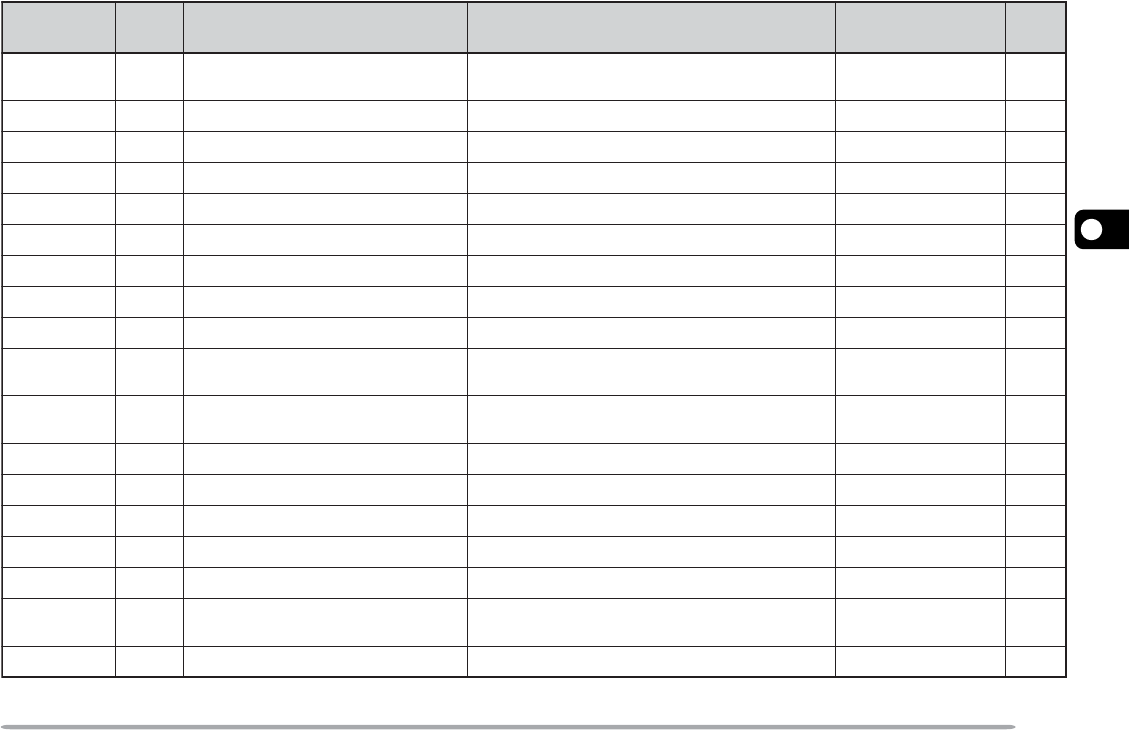
19
5
MENU FUNCTION LIST
ehtnO
yalpsid
uneM
.oN noitcnuF snoitceleS tluafeD .feR
egaP
PTS1 ezispetsycneuqerF /05/03/52/02/51/5.21/01/52.6/5/5.2
zHk001
ees(seiraV
)egapecnerefer 65
T2 ycneuqerfenoTzH1.452~0.765.8842
TC3 ycneuqerfSSCTCzH1.452~0.765.8874
SCD4edocSCD457~32032084
TFS5 noitceridtfihS–/+/FFOFFO32
PXT6 rewopnoissimsnarTwoL/hgiHhgiH51
OFV.P7 OFVelbammargorPzHM371~631zHM371~63116
QSS8 hcleuqsreteM-SFFO/NOFFO45
HQS9 emitgnahhcleuqSsm005/052/521/FFOFFO55
TESFFO01ycneuqerftesfforetaepeRzHM59.96~0 ees(seiraV
)egapecnerefer 32
ORA11tesffOretaepeRcitamotuAFFO/NO ees(seiraV
)egapecnerefer 52
IRP21nacSytiroirPFFO/NOFFO34
NACS31dohtememuseRnacSES/OC/OTOT54
TUO.L41tuokcoLlennahCyromeMFFO/NOFFO44
HC.M51yticapaclennahCyromeM002/00100182
EMAN.M61emaNyromeMsretcarahc6–23
FDM71ycneuqerF/emaNyromeM
yalpsid QRF/NMNM23
OPA81ffo-rewoPcitamotuA.nim081/021/09/06/03/FFOFFO45
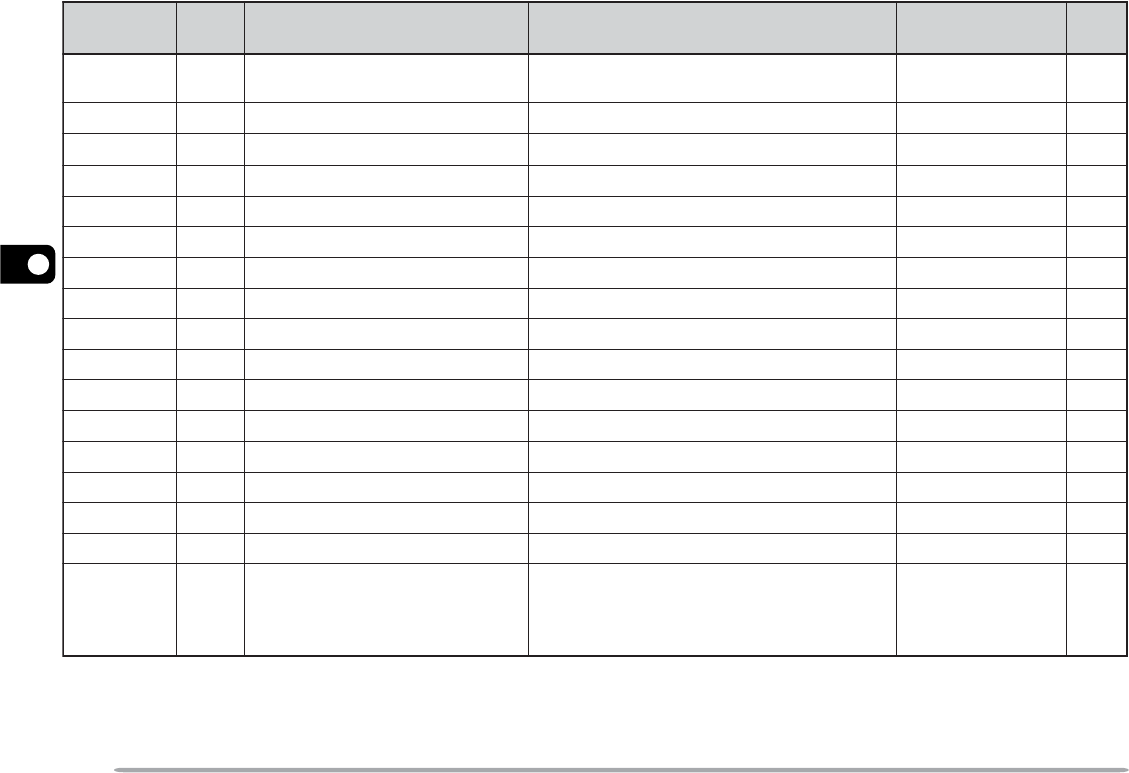
20
5
ehtnO
yalpsid
uneM
.oN noitcnuF snoitceleS tluafeD .feR
egaP
KC91yekLLAC0571/LLAC ees(seiraV
)egapecnerefer 53,52
DLH02dlohXTenotzH0571FFO/NOFFO52
TOT12remiTtuo-emiT.nim01/5/30126
LCB22tuokcoLlennahCysuBFFO/NOFFO65
GSM.NO.P32egassemno-rewoPsretcarahc6–06
PB42peeBFFO/NONO55
SB52tfihStaeBFFO/NOFFO45
NMF62MFworraNFFO/NOFFO06
CNE72kcollortnocgninuTFFO/NOFFO85
RM.FMTD82relaidcitamotuAstigid61otpU–15
DPS92deepsXTFMTDLS/AFAF25
H.TD03dlohXTFMTDFFO/NOFFO15
AP13doirepesuapFMTDsm0002/0051/0001/057/005/052/00100535
L.TD23kcolyekFMTDFFO/NOFFO35
M.TD33rotinomFMTDFFO/NOFFO05
L.CM43kcolyekenohporciMFFO/NOFFO46
1FP53elbammargorpenohporciM
yeknoitcnuf
/LLAC/RM/OFV/0571/RETNE/INOM
/NI.C/NI.M/V--M/LQS/VER/ZHM
/KCOL/THGIRB/WOL/TFIHS/UNEM
PETS/ENOT
ZHM95
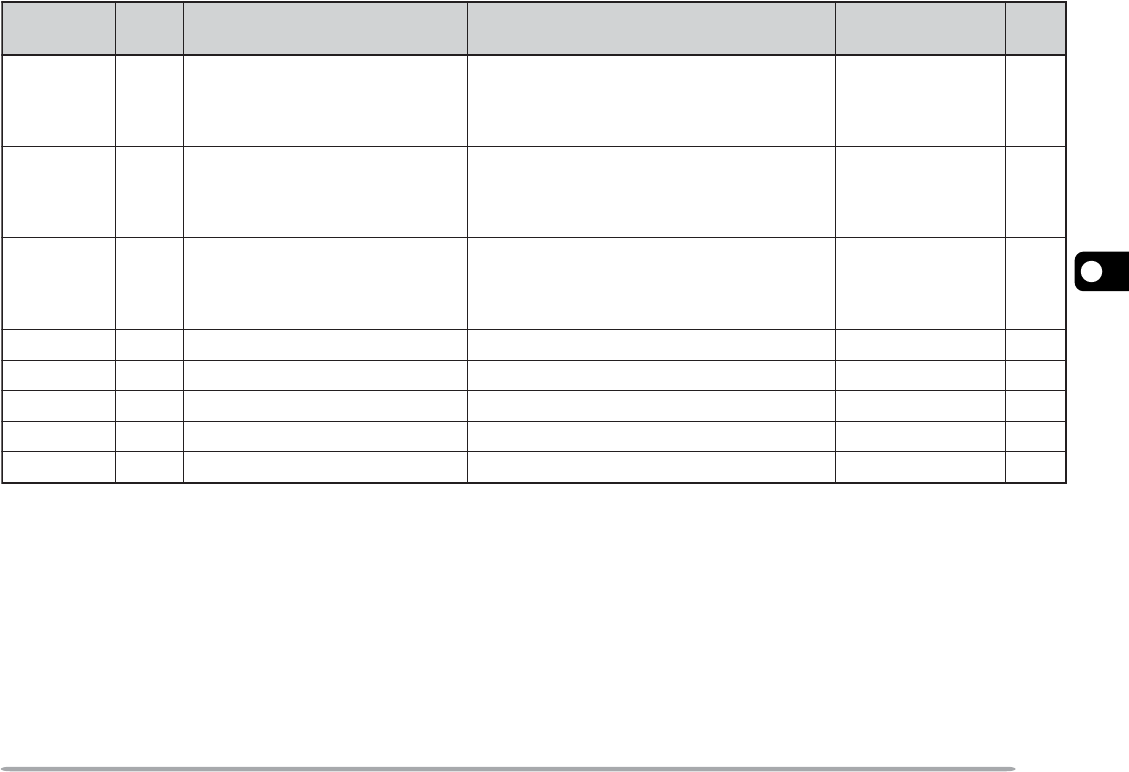
21
5
ehtnO
yalpsid
uneM
.oN noitcnuF snoitceleS tluafeD .feR
egaP
2FP63elbammargorpenohporciM
yeknoitcnuf
/LLAC/RM/OFV/0571/RETNE/INOM
/NI.C/NI.M/V--M/LQS/VER/ZHM
/KCOL/THGIRB/WOL/TFIHS/UNEM
PETS/ENOT
RM95
3FP73elbammargorpenohporciM
yeknoitcnuf
/LLAC/RM/OFV/0571/RETNE/INOM
/NI.C/NI.M/V--M/LQS/VER/ZHM
/KCOL/THGIRB/WOL/TFIHS/UNEM
PETS/ENOT
OFV95
4FP83elbammargorpenohporciM
yeknoitcnuf
/LLAC/RM/OFV/0571/RETNE/INOM
/NI.C/NI.M/V--M/LQS/VER/ZHM
/KCOL/THGIRB/WOL/TFIHS/UNEM
PETS/ENOT
LLAC95
TD93deepsXTataDspb0069/0021002185
THGIRB04ssenthgirbyalpsiD— levelmumixaM75
RBA14ssenthgirbyalpsidcitamotuAFFO/NOFFO75
AXW
1
24trelArehtaeWFFO/NOFFO63
TESER99noitcelesteseRLLUF/OFVOFV76
1 WXA (Weather Alert) is available only for K market models.
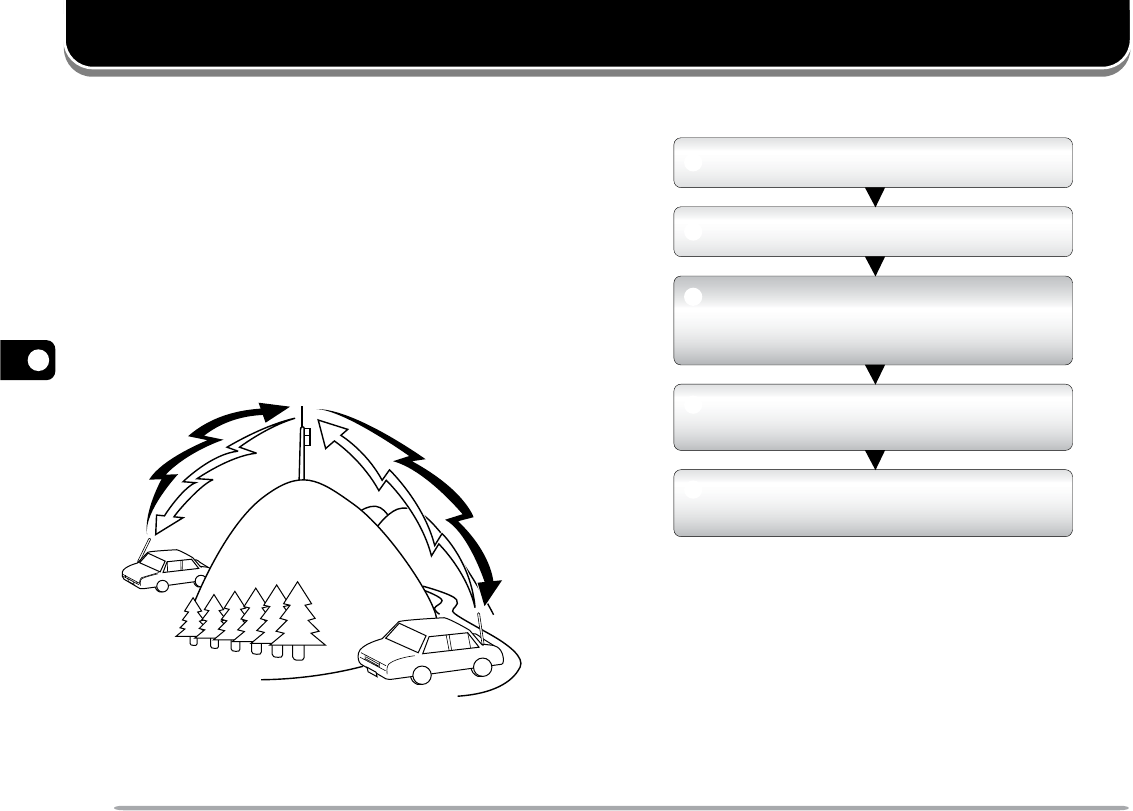
22
6
OPERATING THROUGH REPEATERS
Repeaters, which are often installed and maintained by
radio clubs, are usually located on mountain tops or
other elevated locations. They generally operate at
higher ERP (Effective Radiated Power) than a typical
station. This combination of elevation and high ERP
allows communications over much greater distances
than communicating without using repeaters.
Most repeaters use a receive and transmit frequency
pair with a standard or non-standard offset (odd-split).
In addition, some repeaters must receive a tone from the
transceiver to be accessed. For details, consult your
local repeater reference.
TX: 144.725 MHz
TX tone: 88.5 Hz
RX: 145.325 MHz
TX: 144.725 MHz
TX tone: 88.5 Hz
RX: 145.325 MHz
OFFSET PROGRAMMING FLOW
q
w
e
r
t
Select a receive frequency.
Select an offset direction.
Select an offset frequency
(only when programming odd-split
repeater frequencies).
Activate the Tone function
(if necessary).
Select a tone frequency
(if necessary).
If you store all the above data in a Memory Channel, you
will not need to reprogram the parameters every time.
Refer to “MEMORY CHANNELS” {page 28}.

23
6
PROGRAMMING AN OFFSET
You must first select an amateur radio repeater downlink
frequency as described in “SELECTING AN OFFSET
FREQUENCY”.
SELECTING AN OFFSET DIRECTION
Select whether the transmit frequency will be higher (+)
or lower (–) than the receive frequency.
1Press [F], [MENU] and turn the Tuning control to
select Menu No. 5 (SFT).
2Press [MENU] and turn the Tuning control to select
“+” or “–”.
3Press [MENU] to store the setting or any other key to
cancel.
4Press any key other than [MENU] to exit Menu Mode.
•“+” or “–” appears above the frequency, indicating which
offset direction is selected.
If the offset transmit frequency falls outside the allowable
range, transmission is inhibited. In this case, adjust the
reception frequency so that the transmit frequency is
within the band limits or change the offset direction.
Note: While using an odd-split memory channel or transmitting, you
cannot change the offset direction.
SELECTING AN OFFSET FREQUENCY
To access a repeater which requires an odd-split
frequency pair, change the offset frequency from the
default which is used by most repeaters. The default
offset frequency is 600 kHz.
1Press [F], [MENU] and turn the Tuning control to
select Menu No. 10 (OFFSET).
2Press [MENU] and turn the Tuning control to select
the appropriate offset frequency.
•The selectable range is from 0.00 MHz to 69.95 MHz in
steps of 50 kHz.
3Press [MENU] to store the setting or any other key to
cancel.
4Press any key other than [MENU] to exit Menu Mode.
Note: After changing the offset frequency, the new offset frequency
will also be used by Automatic Repeater Offset.
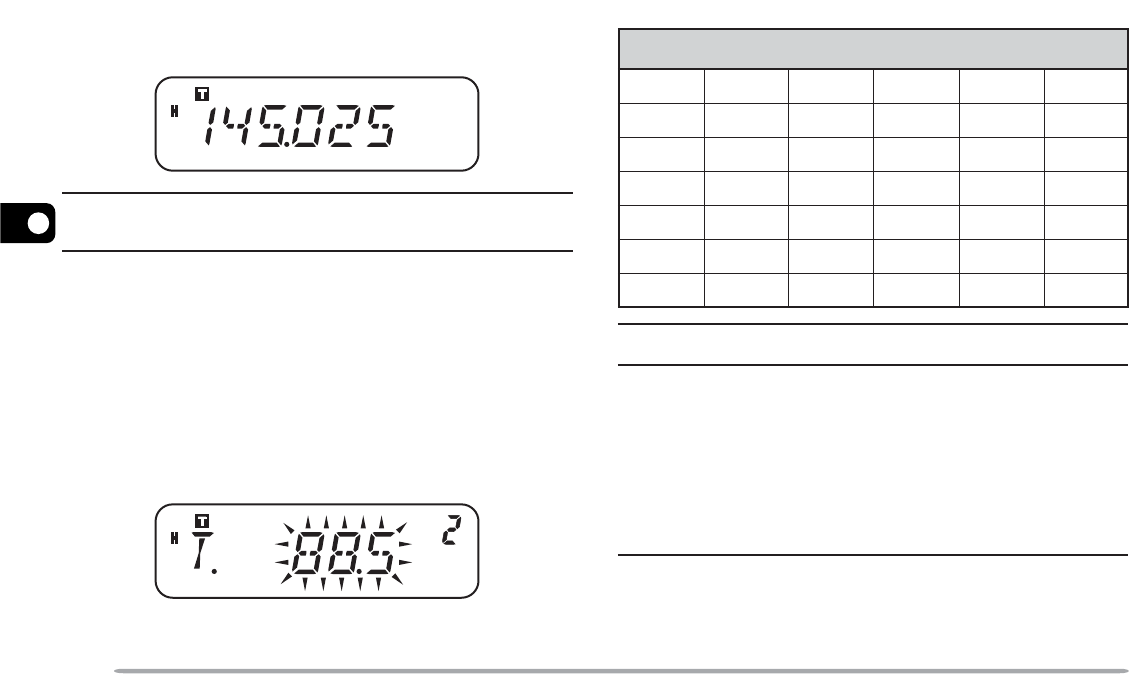
24
6
ACTIVATING THE TONE FUNCTION
To activate Tone, press [F], [CALL].
•As you press [F], [CALL], the selection cycles as follows:
“OFF” ➞ “TONE” ➞ “CTCSS” ➞ “DCS” ➞ “OFF”.
•“T” appears on the upper part of display, indicating that the
Tone function is activated.
Note: You cannot use the Tone function and CTCSS/ DCS functions
simultaneously. Switching the Tone function ON after having activated
the CTCSS/ DCS functions deactivates the CTCSS/ DCS functions.
E market version only: When you access repeaters that require a
1750 Hz tone, you do not need to activate the Tone function. Simply
press [CALL] without pressing Mic [PTT] to transmit a 1750 Hz tone
(default setting).
SELECTING A TONE FREQUENCY
1Press [F], [MENU] and turn the Tuning control to
select Menu No. 2 (T).
2Press [MENU] and turn the Tuning control to select
the desired tone frequency (default is 88.5 Hz).
3Press [MENU] to store the setting or any other key to
cancel.
4Press any key other than [MENU] to exit Menu Mode.
Available Tone Frequencies
)zH(seicneuqerFenoT24
0.764.582.7015.6318.3711.812
3.965.889.0113.1419.9717.522
9.175.198.4112.6412.6811.922
4.478.498.8114.1518.2916.332
0.774.790.3217.6515.3028.142
7.970.0013.7212.2615.6023.052
5.285.3018.1319.7617.0121.452
Note: 42 different tones are available for the transceiver. These
42 tones includes 37 EIA standard tones and 5 non-standard tones.
E market version only:
◆To transmit a 1750 Hz tone, simply press [CALL] without pressing
Mic [PTT] (default setting). Release [CALL] to quit transmitting.
You can also make the transceiver remain in the transmit mode for
2 seconds after releasing [CALL]; a 1750 Hz tone is not
continuously transmitted. Access Menu No. 20 (HLD) and select
“ON”.
◆To use [CALL] for recalling the Call Channel in place of
transmitting a 1750 Hz tone, access Menu No. 19 (CK) and select
“CALL”.

25
6
AUTOMATIC REPEATER OFFSET
This function automatically selects an offset direction,
according to the frequency on the VHF band. The
transceiver is programmed for an offset direction as
shown below. To obtain an up-to-date band plan for
repeater offset direction, contact your national Amateur
Radio association.
K market version only
+–
–– +S
S
SS
144.0 145.5 146.4 147.0 147.6
145.1 146.0 146.6 147.4 148.0 MHz
S: Simplex
This complies with the standard ARRL band plan.
E market version only
S
S
S: Simplex
–
144.0 146.0 MHz145.8145.6
Note: Automatic Repeater Offset does not function when the Reverse
function is ON. However, pressing [REV] after Automatic Repeater
Offset has selected an offset (split) status, exchanges the receive and
transmit frequencies.
1Press [F], [MENU] and turn the Tuning control to
select Menu No. 11 (ARO).
2Press [MENU] and turn the Tuning control to switch
the function “ON” (default) or “OFF”.
3Press [MENU] to store the setting or any other key to
cancel.
4Press any key other than [MENU] to exit Menu Mode.
TRANSMITTING A 1750 Hz TONE
Most of the repeaters in Europe require the transceiver
to transmit a 1750 Hz tone. On E market versions,
simply pressing [CALL] causes the transceiver to
transmit a 1750 Hz tone. (On other market versions,
pressing [CALL] changes the transceiver to the Call
Channel {page 35}.)
To change the setting of the CALL key:
1Press [F], [MENU] and turn the Tuning control to
select Menu No. 19 (CK).
2Press [MENU] and turn the Tuning control to select
“CALL” or “1750”.
3Press [MENU] to store the setting or any other key to
cancel.
4Press any key other than [MENU] to exit Menu Mode.
Some repeaters in Europe must receive continuous
signals for a certain period of time, following a 1750 Hz
tone. This transceiver is also capable of remaining in the
transmit mode for 2 seconds after transmitting the tone.
1Press [F], [MENU] and turn the Tuning control to
select Menu No. 20 (HLD).
2Press [MENU] and turn the Tuning control to select
“ON”.
3Press [MENU] to store the setting or any other key to
cancel.
4Press any key other than [MENU] to exit Menu Mode.
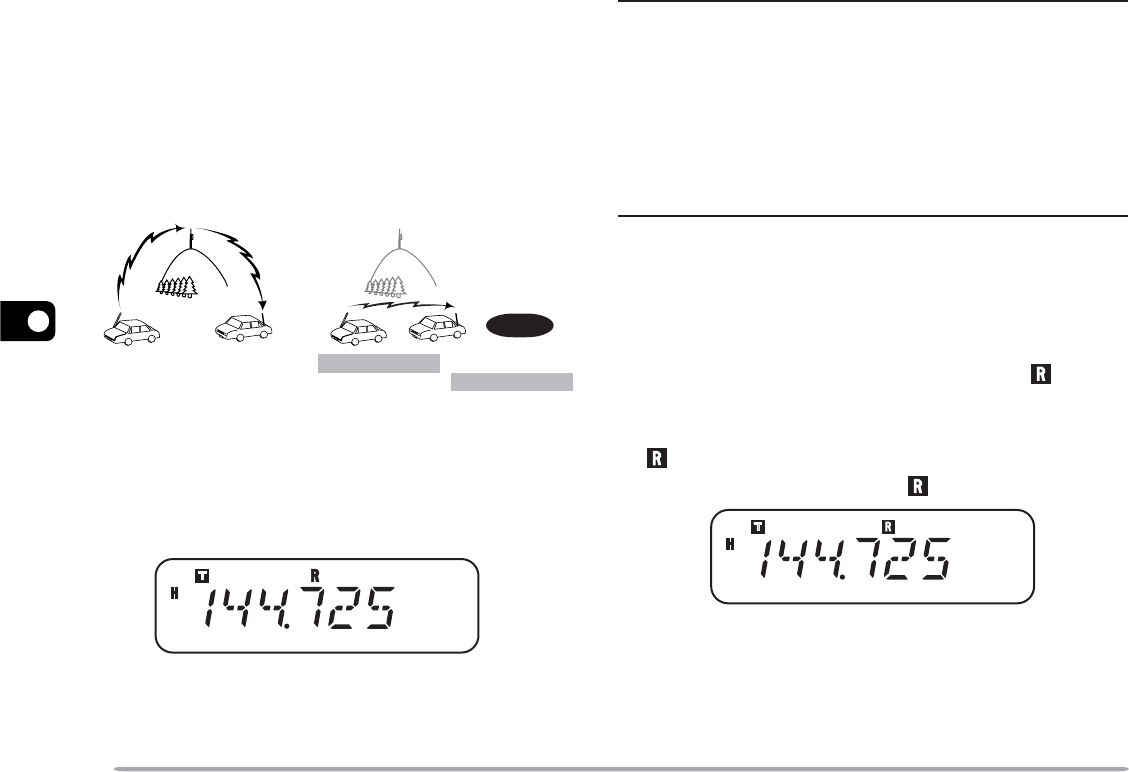
26
6
REVERSE FUNCTION
The reverse function exchanges a separate receive and
transmission frequency. So, while using a repeater, you
can manually check the strength of a signal that you
receive directly from the other station. If the station’s
signal is strong, both stations should move to a simplex
frequency and free up the repeater.
To swap the transmit and receive frequencies:
Press [REV] to switch the Reverse function ON (or
OFF).
• “R” appears when the function is ON.
Note:
◆You can turn the Reverse function ON when you are operating in
Simplex Mode. However, it does not change the Transmission/
Reception frequencies.
◆If pressing [REV] places the reception frequency outside the
allowable range, an error tone sounds and the function does not
operate.
◆If pressing [REV] places the transmission frequency outside the
allowable range, pressing Mic [PTT] causes an error tone to
sound and transmission is inhibited.
◆You cannot switch Reverse ON or OFF while transmitting.
AUTOMATIC SIMPLEX CHECK (ASC)
While using a repeater, the ASC function periodically
checks the strength of the signal you are receiving from
the other station. If the station’s signal is strong enough
to allow direct contact without a repeater, the “ ”
indicator starts blinking.
Press [REV] (1s) to switch the function ON (or OFF).
•“ ” appears when the function is ON.
•While direct contact is possible, “ ” blinks.
REV ON
144.725 MHz
145.325 MHz
144.725 MHz
TX: 144.725 MHz TX: 144.725 MHz
RX: 145.325 MHz RX: 145.325 MHz
TX: 144.725 MHz TX: 145.325 MHz
RX: 145.325 MHz RX: 144.725 MHz
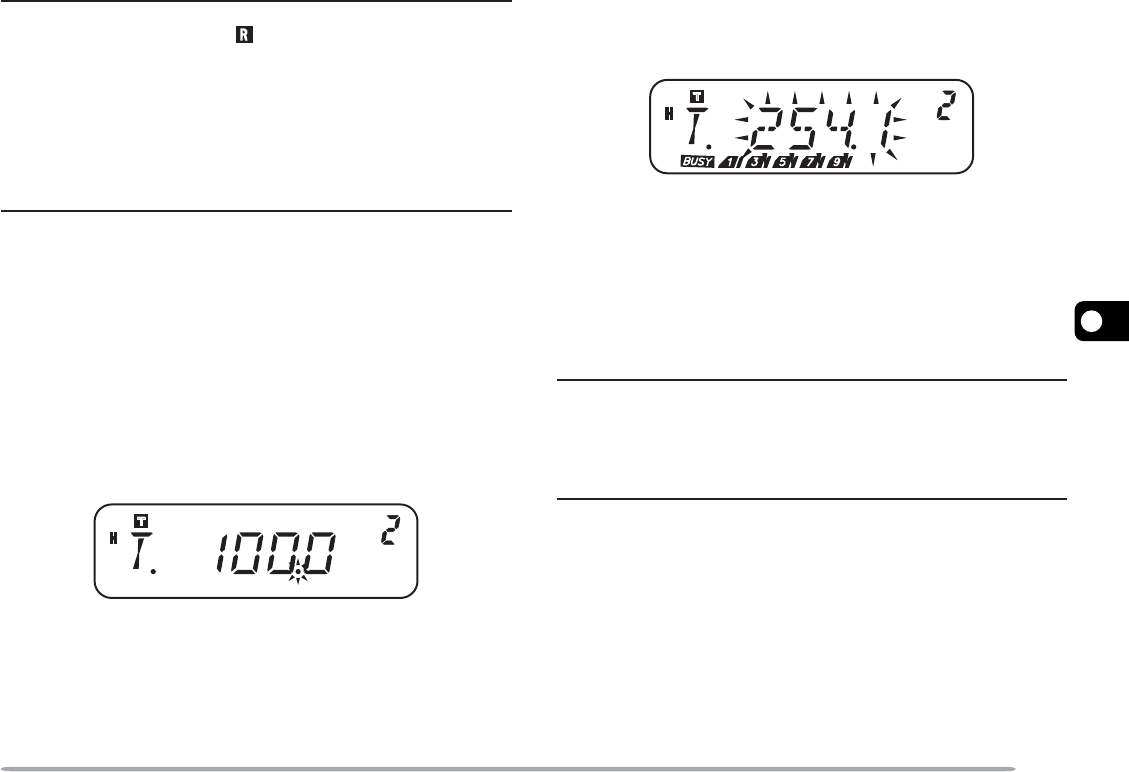
27
6
Note:
◆Pressing [PTT] causes the “ ” icon to quit blinking.
◆ASC can be activated while operating in Simplex mode. However,
it does not change the Transmission/Reception frequencies.
◆ASC does not function while scanning.
◆Activating ASC while using Reverse switches Reverse OFF.
◆If you recall a Memory Channel or the Call Channel that contains
a Reverse ON status, ASC is switched OFF.
◆ASC causes received audio to be momentarily intermitted every
3 seconds.
TONE FREQUENCY ID SCAN
This function scans through all tone frequencies to identify
the incoming tone frequency on a received signal. You
can use this function to determine which tone frequency is
required by accessing your local repeater.
1Press [F], [MENU] and turn the Tuning control to
select Menu No. 2 (T).
2Press [MENU] (1s) to start the Tone Frequency ID
Scan.
•When the transceiver receives a signal, scan starts.
The decimal point blinks during scan.
•While the transceiver is receiving a signal during Tone
Frequency ID Scan, the signal is emitted from the
speaker.
•To reverse the scan direction, turn the Tuning control.
•To quit the function, press any key.
•When the tone frequency is identified, a beep sounds
and the identified frequency blinks.
3Press [MENU] to program the identified tone
frequency in place of the current tone frequency or
press any other key to exit the Tone Frequency ID
Scan.
•Turn the Tuning control while the identified tone
frequency is blinking to resume scanning.
4Press any key other than [MENU] to exit Menu Mode.
Note:
◆Some repeaters do not re-transmit the access tone in the
download signal. In this case, check the other station’s uplink
signal to detect the repeater access tone.
◆The transceiver continues to check the Weather Alert Channel
and Priority Channel during Tone Frequency ID Scan.

28
7
MEMORY CHANNELS
In Memory Channels, you can store frequencies and
related data that you frequently use so that you do not
need to reprogram that data every time. You can quickly
recall a programmed channel through simple operation.
A total of 200 Memory Channels (100 when using the
Memory Name function) are available for storing
frequencies, modes, and other operating conditions.
NUMBER OF MEMORY CHANNELS
The transceiver must be configured to either 200
Memory Channels without using the Memory Name
function or 100 Memory Channels with the Memory
Name function (default).
To change the Memory Channel capacity:
1Press [F], [MENU] and turn the Tuning control to
select Menu No. 15 (M.CH).
2Press [MENU] and turn the Tuning control to select
either “100” (default) or “200”.
3Press [MENU].
•“SURE ?” appears.
4Press [MENU] to accept or press any other key to
cancel.
Note:
◆If you change the Memory Channel capacity from 200 channels to
100 channels after having stored data in channels 100 to 199, all
Memory Channel data in channels 100 to 199 will be erased.
◆If you change the Memory Channel capacity from 100 channels to
200 channels after storing Memory Names in those channels, the
Memory Name data will be erased.
SIMPLEX & REPEATER OR ODD-SPLIT MEMORY
CHANNEL?
You can use each Memory Channel as a simplex &
repeater channel or an odd-split channel. Store only one
frequency to use as a simplex & repeater channel or two
separate frequencies to use as an odd-split channel.
Select either application for each channel depending on
the operations you have in mind.
Simplex & repeater channels allow:
•Simplex frequency operation
•Repeater operation with a standard offset (if an offset
direction is stored)
Odd-split channels allow:
•Repeater operation with a non-standard offset
Note: Not only can you store data in Memory Channels, but you can
also overwrite existing data with new data.
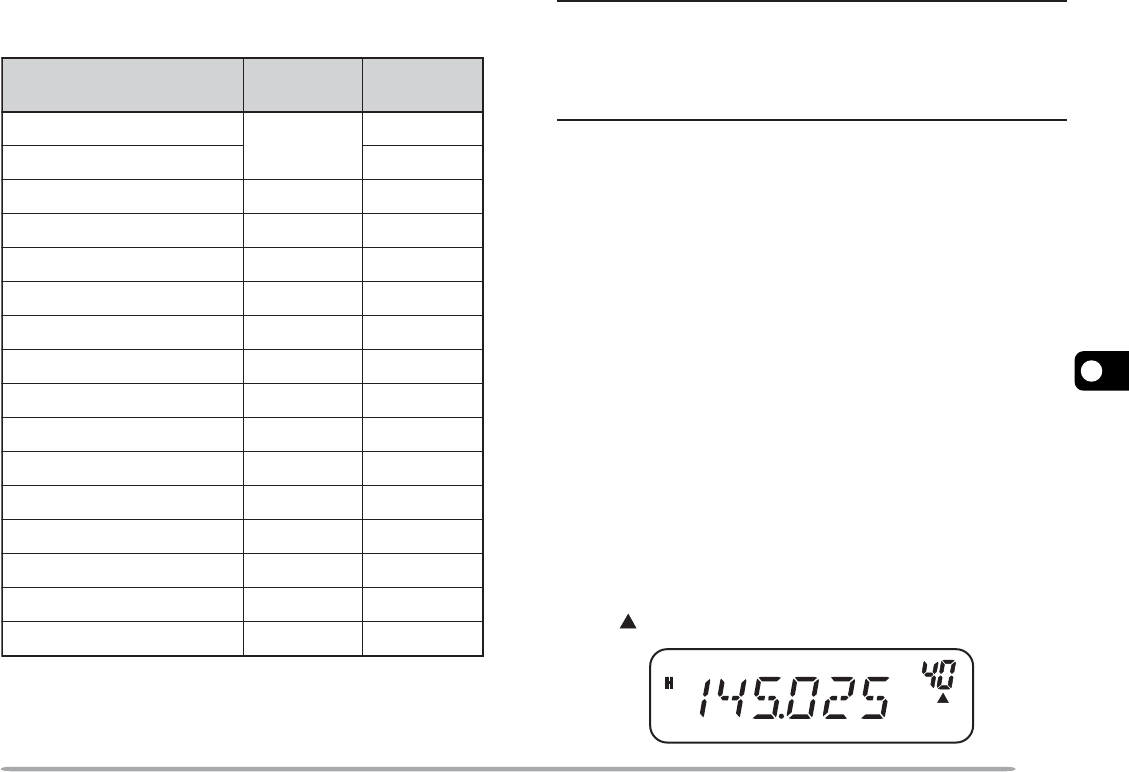
29
7
The data listed below can be stored in each Memory
Channel:
retemaraP &xelpmiS
retaepeR tilpS-ddO
ycneuqerfevieceR seY seY
ycneuqerftimsnarTseY
ycneuqerfenoTseYseY
NOenoTseYseY
ycneuqerfSSCTCseYseY
NOSSCTCseYseY
edocSCDseYseY
NOSCDseYseY
noitceridtesffOseYA/N
ycneuqerftesffOseYA/N
NOesreveRseYA/N
ezispetsycneuqerFseYseY
MFdnabworraNseYseY
tfihStaeBseYseY
tuokcollennahCyromeMseYseY
emanlennahCyromeMseYseY
Yes: Can be stored in memory.
N/A: Cannot be stored in memory.
Note:
◆Memory Channel Lockout cannot be set to the Program Scan
Memory (L0/U0 ~ L2/U2), the Priority Channel (Pr), or the
Weather Alert Channel (AL).
◆Tone, CTCSS, and DCS are automatically turned OFF when
setting up the Weather Alert Channel (AL).
STORING SIMPLEX FREQUENCIES OR STANDARD
REPEATER FREQUENCIES
1Press [VFO].
2Turn the Tuning control to select your desired
frequency.
•You can also directly enter a desired frequency using
the keypad {page 13}.
3If storing a standard repeater frequency, select the
following data:
•Offset direction {page 23}
•Tone function, if necessary {page 24}
•CTCSS/ DCS function, if necessary {pages 46, 48}
If storing a simplex frequency, you may select other
related data (CTCSS or DCS settings, etc.).
4Press [F].
•A Memory Channel number appears and blinks.
•“ ” appears if the channel contains data.

30
7
•Memory Channel numbers L0/U0 ~ L2/U2 {page 40}, Pr
{page 43}, and AL (Weather Alert) {page 36} (K market
models only) are reserved for other functions.
5Turn the Tuning control or press Mic [UP]/[DWN] to
select the Memory Channel in which you want to
store the data.
6Press [MR] to store the data to the channel.
STORING ODD-SPLIT REPEATER FREQUENCIES
Some repeaters use a pair of reception and transmission
frequencies with a non-standard offset. If you store two
separate frequencies in a Memory Channel, you can
operate on those repeaters without programming the
offset frequency and direction.
1Store the desired reception frequency and related
data by following steps 1 to 6 given for simplex or
standard repeater frequencies {page 29}.
2Turn the Tuning control or press Mic [UP]/[DWN] to
select your desired transmit frequency.
3Press [F].
4Turn the Tuning control or press Mic [UP]/[DWN] to
select the pre-programmed reception Memory
Channel in which you want to store the data.
5Press [MR] (1s).
•The transmission frequency is stored in the memory
channel.
Note:
◆When you recall an odd-split memory channel, “+” and “–” appear
on the display. To confirm the transmission frequency, press
[REV].
◆Transmit offset status and reverse status are not stored in
odd-split memory channels.
RECALLING A MEMORY CHANNEL
USING THE TUNING CONTROL
1Press [MR] to enter Memory Recall mode.
•The Memory Channel last used is recalled.
2Turn the Tuning control to select your desired
Memory Channel.
•You cannot recall an empty Memory Channel.
•To restore VFO mode, press [VFO].

31
7
USING THE MICROPHONE KEYPAD
You can also recall a Memory Channel by entering a
desired Memory Channel number with the microphone
keypad.
1Press [MR] to enter Memory Recall mode.
2Press the microphone key assigned the ENTER
function.
3Enter the channel number using the microphone
keypad.
•For single-digit channel numbers, enter “0” first or press
Mic [Enter] after entering the channel number.
•For two-digit channel numbers that begin with “1”, press
Mic [Enter] after entering the channel number.
Note:
◆You cannot recall an empty Memory Channel. An error beep
sounds.
◆You cannot recall the Program Scan Memory Channels
(L0/U0 ~ L2/U2), the Priority Channel (Pr), and the Weather Alert
Channel (AL) (K market models only) using the numeric keypad.
◆When you recall an odd-split memory channel, “+” and “–” appear
on the display. Press [REV] to display the transmission
frequency.
◆After recalling a Memory Channel, you may modify data such as
Narrow Band, Tone, or CTCSS. However, these settings are
cleared once you select another channel or the VFO Mode. To
permanently store the data, overwrite the channel contents.
CLEARING A MEMORY CHANNEL
To erase an individual Memory Channel:
1Recall the Memory Channel you want to erase.
2Press [ ] (Power) (1s) to switch the transceiver
OFF.
3Press [MR]+[ ] (Power).
•An erase confirmation message appears.
4Press [MR] to erase the channel data.
•The contents of the Memory Channel are erased.
•To quit clearing the Memory Channel, press any key
other than [MR].
Note:
◆You can also clear the Priority Channel, the AL Channel, and
L0/U0 ~ L2/U2 data. (The Call Channel cannot be cleared.)
◆To clear all Memory Channel contents at once, perform Full Reset
{page 67}.
◆You cannot clear channels while in Channel Display Mode.
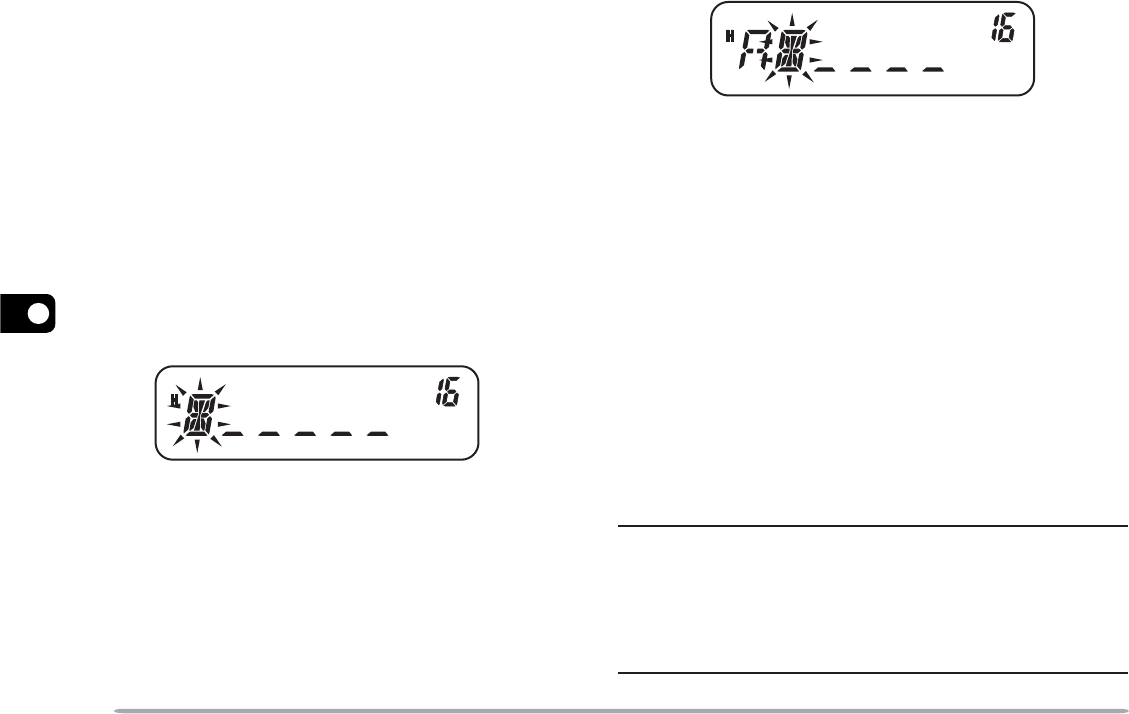
32
7
NAMING A MEMORY CHANNEL
You can name Memory Channels using up to 6
alphanumeric characters. When you recall a named
Memory Channel, its name appears on the display in
place of the stored frequency. Names can be call signs,
repeater names, cities, names of people, etc. In order to
use the Memory Name function, the Memory Channel
capacity must be set to 100 channels. To change the
Memory Channel capacity from 200 to 100, access
Menu No. 15 (M.CH) {page 28}.
1Press [MR] and turn the Tuning control to recall your
desired Memory Channel.
2Press [F], [MENU] and turn the Tuning control to
select Menu No. 16 (M.NAME).
3Press [MENU].
•A blinking cursor appears.
4Turn the Tuning control to select a desired
alphanumeric character.
•You can enter the following alphanumeric characters:
0 ~ 9, A ~ Z, – (hyphen), / (slash), and a space.
•Rather than using the Tuning control, you can use the
Mic keypad (keypad models only) to enter alphanumeric
characters {page 64}.
5Press [MR].
•The cursor moves to the next digit.
•To move to the previous digit, press [VFO]. To delete
the character at the current cursor position, press [F].
6Repeat steps 4 and 5 to enter up to 6 digits.
7Press [MENU] to complete the entry.
•Press any key other than [MR], [VFO], [F], and [MENU]
to cancel the entry.
•To complete an entry of less than 6 characters, press
[MENU] two times.
8Press any key other than [MENU] to exit Menu Mode.
After storing a Memory Name, the Memory Name
appears in place of the operating frequency. However,
you can still display the operating frequency, if desired.
To display the frequency rather than Memory Name,
access Menu No. 17 (MDF) and select “FRQ”. This
menu toggles the display mode between the Memory
Name (“MN”) and frequency display (“FRQ”).
Note:
◆You cannot name the Call Channel {page 35}.
◆You cannot assign a Memory Name to a channel that does not
contain data.
◆You can overwrite stored names by repeating steps 1 to 8.
◆The stored name is erased when you clear the Memory Channel
data.

33
7
MEMORY CHANNEL TRANSFER
MEMORY \ VFO TRANSFER
After retrieving frequencies and associated data from
Memory Recall Mode, you can copy the data to the VFO.
This function is useful, for example, when the frequency
you want to monitor is near the frequency stored in a
Memory Channel.
1Press [MR], then turn the Tuning control or press Mic
[UP]/[DWN] to recall the desired Memory Channel.
•Alternatively, press [CALL] to select the Call Channel.
2Press [F], [VFO] to copy the Memory Channel data to
the VFO.
Note:
◆To copy an odd-split channel data {page 30}, press [REV] before
performing the transfer.
◆You can also transfer the Program Scan memory channels
(L0/U0 ~ L2/U2), the Priority Channel (Pr), and the Weather Alert
Channel (AL) (K market models only) to the VFO.
◆Lockout status and Memory Names are not copied from a
Memory Channel to the VFO.
CHANNEL \ CHANNEL TRANSFER
You can copy channel information from one Memory
Channel to another. This function is useful when storing
frequencies and associated data that you temporarily
change in Memory Recall Mode.
1Press [MR], then turn the Tuning control or press Mic
[UP]/[DWN] to recall the desired Memory Channel.
2Press [F].
3Select the Memory Channel where you would like the
data copied by using the Tuning control or pressing
Mic [UP]/[DWN].
4Press [MR].

34
7
The tables below illustrate how data is transferred
between Memory Channels.
991~0lennahC a991~0lennahC
ycneuqerfevieceR aycneuqerfevieceR
ycneuqerftimsnarT aycneuqerftimsnarT
ycneuqerfenoT aycneuqerfenoT
noitceridtesffO anoitceridtesffO
ycneuqerfSSCTC aycneuqerfSSCTC
edocSCD aedocSCD
SCD/SSCTC/enoT
sutatsFFO/NO aSCD/SSCTC/enoT
sutatsFFO/NO
ycneuqerftesffO aycneuqerftesffO
NOesreveR aNOesreveR
ezispetsycneuqerF aezispetsycneuqerF
emanlennahCyromeM
1
aemanlennahCyromeM
1
lennahCyromeM
FFO/NOtuokcoL alennahCyromeM
FFO/NOtuokcoL
991~0lennahC aLA,rP,2U/2L~0U/0L
2
ycneuqerfevieceR aycneuqerfevieceR
ycneuqerftimsnarT aycneuqerftimsnarT
ycneuqerfenoT aycneuqerfenoT
noitceridtesffO anoitceridtesffO
ycneuqerfSSCTC aycneuqerfSSCTC
edocSCD aedocSCD
SCD/SSCTC/enoT
sutatsFFO/NO aSCD/SSCTC/enoT
sutatsFFO/NO
ycneuqerftesffO aycneuqerftesffO
NOesreveR aNOesreveR
ezispetsycneuqerF aezispetsycneuqerF
emanlennahCyromeM
1
aemanlennahCyromeM
1
lennahCyromeM
NOtuokcoL alennahCyromeM
FFOtuokcoL
1When “100” is selected in Menu No.15 (M.CH).
2The AL Channel is available for K market models only.
Note:
◆When transferring an odd-split channel, the Reverse status, Offset
direction, and Offset frequency are not transferred
{pages 23, 26}.
◆Tone, CTCSS, and DCS are automatically turned OFF when
transferring data to the Weather Alert Channel (AL).

35
7
CALL CHANNEL
The Call Channel can be recalled instantly no matter
what frequency the transceiver is operating on. For
instance, you may use the Call Channel as an
emergency channel within your group. In this case, Call
Scan {page 43} will be useful.
The default Call Channel frequency is 144.000 MHz.
Note: Unlike Memory Channels 0 to 199, the Call Channel cannot be
cleared.
RECALLING THE CALL CHANNEL
1Press [CALL] to recall the Call Channel.
•The Call Channel frequency and “C” appear.
•To return to the previous frequency, press [CALL] again.
REPROGRAMMING THE CALL CHANNEL
1Select your desired frequency and related data (Tone,
CTCSS, DCS, or offset direction, etc.).
•When you program the Call Channel as an odd-split
channel, select a reception frequency first.
2Press [F].
•A Memory Channel number appears and blinks.
3Turn the Tuning control or press Mic [UP]/[DWN] to
select the Call Channel (“C”).
4Press [MR].
•The selected frequency and related data are stored in
the Call Channel.
To also store a separate transmit frequency, continue with the
following steps:
5Select the desired transmission frequency.
6Press [F].
7Turn the Tuning control or press Mic [UP]/[DWN] to
select the Call Channel (“C”).
8Press [MR] (1s).
•The separate transmission frequency is stored in the
Call Channel.
Note:
◆When you recall an odd-split Call Channel, “+” and “–” appear on
the display.
◆Transmit offset status and Reverse status are not stored in an
odd-split Call Channel.

36
7
WEATHER ALERT (K MARKET MODELS ONLY)
Any of the NOAA Weather Radio channels can be
programmed to the AL memory channel of the
transceiver. The transceiver can be configured to check
the NOAA Weather Alert tone (1050 Hz) and will
automatically alert you by recalling and monitoring the
Weather Radio frequency when the Weather Alert tone
is broadcasted, and the “WX” icon will blink.
PROGRAMMING THE WEATHER RADIO FREQUENCY
The transceiver is preprogrammed to 162.550 MHz
(WX1). You can store a different frequency to the AL
channel to use this function. Refer to the NOAA channel
frequency directory for your local weather channel
frequency before you use the Weather Alert function.
The latest Weather Radio information can be obtained
from http://www.nws.noaa.gov/nwr/.
1Press [VFO].
2Select your local NOAA Weather Radio channel
frequency using the Tuning control or Mic [UP]/
[DWN].
3Press [F].
•A Memory Channel number appears and blinks.
4Turn the Tuning control or press Mic [UP]/[DWN] to
select the Alert Channel (“AL”).
5Press [MR].
)zHM(seicneuqerFoidaRrehtaeW
1XW 2XW 3XW 4XW 5XW 6XW 7XW
055.261004.261574.261524.261054.261005.261525.261
Note:
◆When you perform Full Reset {page 63}, the Weather Radio
frequency recovers the factory default frequency (162.550 MHz).
◆When you clear the Weather Radio (AL) Channel {page 31} (the
same as clearing a Memory Channel), the factory default
frequency (162.550 MHz) is recovered.
◆The Weather Radio (AL) Channel can be programmed with a
Channel Name {page 31}.
◆You can also transfer the AL Memory Channel data to the VFO or
another Memory Channel.
ENABLING A WEATHER ALERT
You can monitor the Weather Radio frequency
continuously or in the background while receiving on
another frequency.
To monitor the Weather Radio frequency continuously:
1Press [F], [MENU] and turn the Tuning control to
select Menu No. 42 (WXA).
2Press [MENU] and turn the Tuning control to select
“ON”.
3Press [MENU] to store the setting.
•“WX” appears on the display.
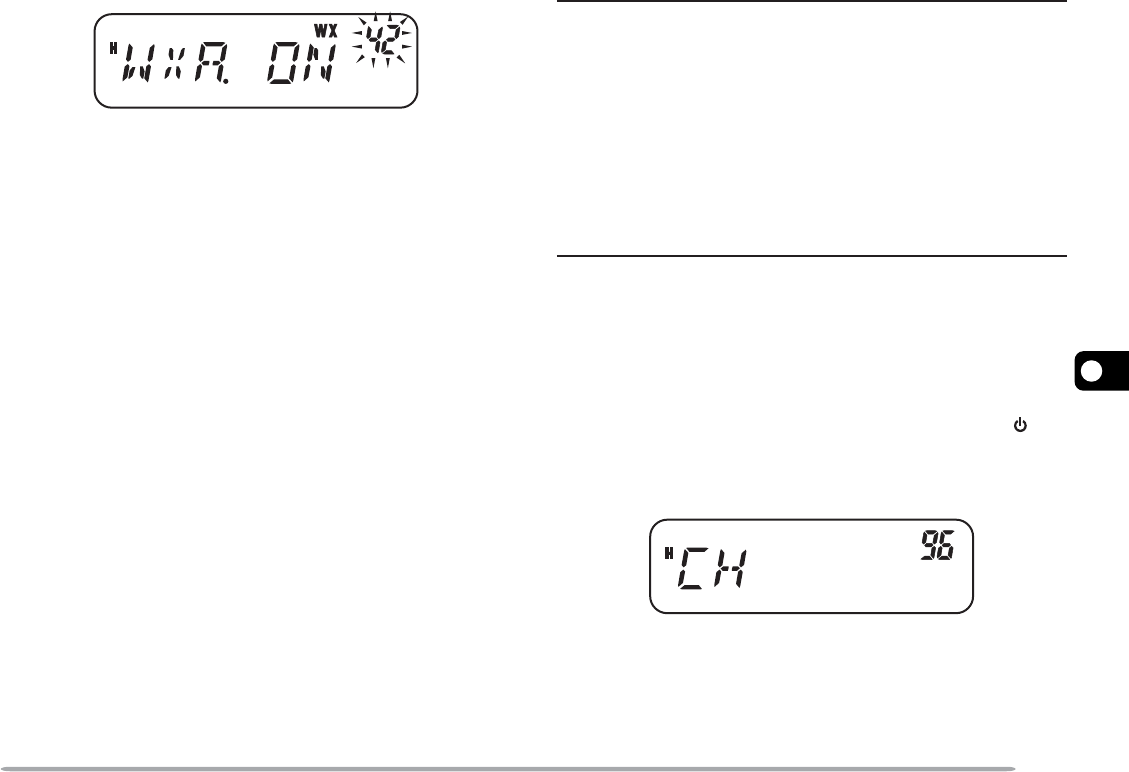
37
7
4Press any key other than [MENU] to exit Menu Mode.
•The transceiver automatically changes to the AL
channel.
•The Tone, CTCSS, and DCS functions cannot be
configured to the AL channel.
•Priority Scan is set to OFF automatically when the
Weather Alert function is turned ON.
5To exit Weather Alert Mode, press [MENU], select
Menu No. 42 (WXA), and set it to “OFF” (default).
To monitor another frequency while monitoring the
Weather Radio in the background:
1Perform step 1 ~ 4, above.
2Press [VFO] or [MR] and turn the Tuning control to
select another frequency or Memory Channel.
•“WX” remains on the LCD.
3When the Weather Alert tone is broadcasted, the
transceiver automatically switches to the AL channel.
•“WX” blinks.
4To exit Weather Alert Mode, press [MENU], select
Menu No. 42 (WXA), and set it to “OFF”.
Note:
◆The transceiver checks the weather alert tone once every second
while you are monitoring another frequency or channel.
◆When a 1050 Hz tone is detected, the display will change to the
AL channel, the Weather Alert tone sounds, and the “WX” icon
blinks. Squelch remains open until the frequency is changed or
the transceiver power is turned OFF.
◆If the transceiver is transmitting or receiving a signal on another
frequency, the Weather Alert function temporarily pauses.
◆Turning the Beep function “OFF” does not disable the Weather
Alert tone.
◆You cannot transmit on the AL channel while the Weather Alert
function is ON.
CHANNEL DISPLAY
While in this mode, the transceiver displays only Memory
Channel numbers (or Memory Names if they have been
stored), instead of frequencies.
1With the transceiver power OFF, press [REV]+[ ]
(Power) to turn the power ON.
•The transceiver displays the Memory Channel numbers
in place of the operating frequencies.
2Turn the Tuning control to select your desired
Memory Channel number.

38
7
While in Channel Display mode, you cannot activate the
following functions:
•VFO Mode
•VFO Scan
•Call/VFO Scan
•MHz Scan
•Scan Direction
•Memory Store
•Memory to VFO Transfer
•Memory to Memory Transfer
•Clear Memory Channel
•VFO Reset
•Full Reset
•1 MHz Step
•Selection for Tone and Selective Call
•Auto Simplex Checker
•Menu Mode
To recover normal operation, turn the transceiver power
OFF and press [REV]+[ ] again.
Note:
◆To enter the Channel Display Mode, you must have at least one
Memory Channel that contains data.
◆If the Memory Channel contains a Memory Name, the Memory
Name is displayed in place of “CH”.
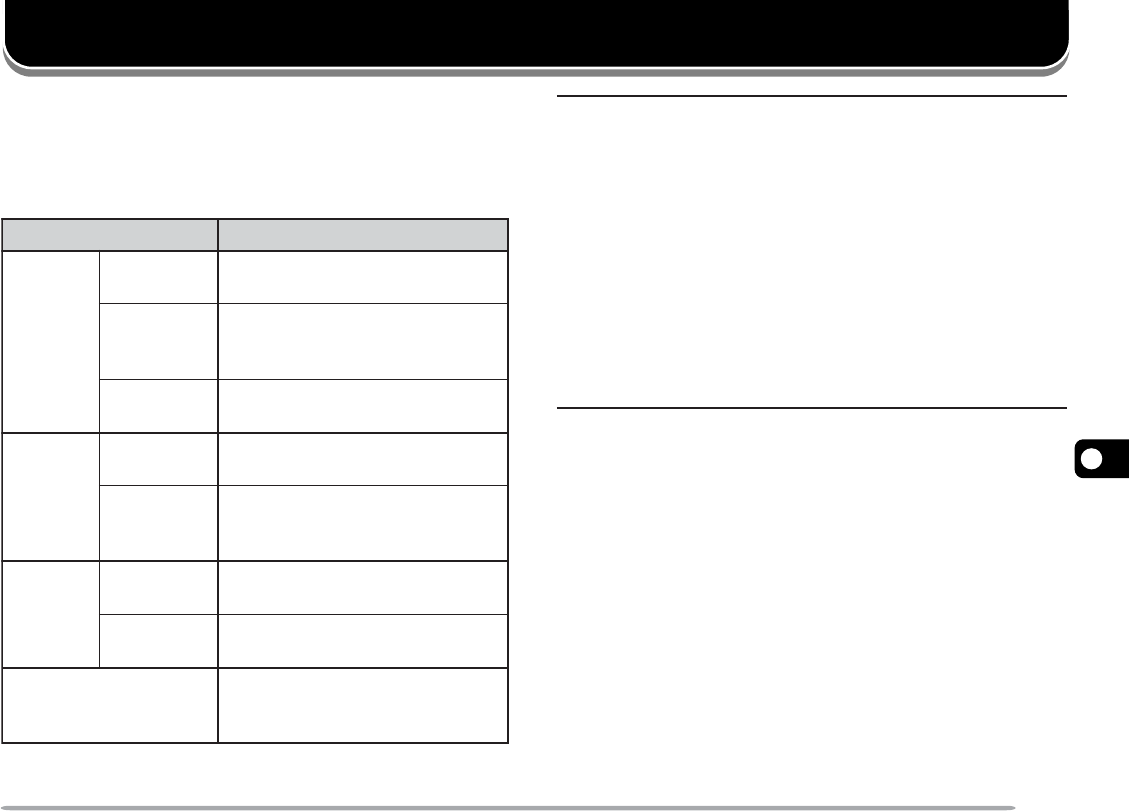
39
8
SCAN
Scan is a useful function for hands-off monitoring of your
favorite frequencies. By becoming comfortable with all
types of scan, you will increase your operating efficiency.
This transceiver provides the following types of scans.
epyTnacS esopruP
lamroN
nacS
nacSdnaB ehtfodnaberitneehtsnacS
detcelesuoyycneuqerf
margorP
nacS
ycneuqerfdeificepsehtsnacS
yromeMniderotssegnar
2U/2L~0U/0LslennahC
nacSzHM anihtiwseicneuqerfehtsnacS
egnarzHM1
yromeM
nacS
lennahC-llA
nacS
slennahCyromeMllasnacS
)99ot0morfro(991ot0morf
nacSpuorG
nislennahCyromeMsnacS
,91~0(slennahc02fospuorg
).cte,95~04,93~02
llaC
nacS
OFV dnalennahCllaCehtsnacS
ycneuqerfOFVtnerruceht
yromeM
lennahC
dnalennahCllaCehtsnacS
lennahCyromeMdetceleseht
nacSytiroirP
ehtnoseitivitcaehtskcehC
yreve)rP(lennahCytiroirP
sdnoces3
Note:
◆When the CTCSS or DCS function is activated, the transceiver
stops at a busy frequency and decodes the CTCSS tone or DCS
code. If the tone or code matches, the transceiver unmutes.
Otherwise, it resumes scanning.
◆Press and hold the Mic PF key programmed as MONI {page 59}
to pause scan in order to monitor the scanning frequency.
Release the key to resume scanning.
◆Pressing and holding Mic [PTT] causes scan to stop (excluding
Priority Scan).
◆While scanning, you can change the scan frequency direction by
turning the Tuning control or using the Mic [UP]/[DWN] keys.
◆Starting scan switches OFF the Automatic Simplex Check (ASC)
{page 26}.
◆Adjust the Squelch level before using Scan {page 14}. Selecting a
Squelch level too low could cause Scan to stop immediately.

40
8
NORMAL SCAN
When you are operating the transceiver in VFO Mode,
3 types of scanning are available: Band Scan, Program
Scan, and MHz Scan.
BAND SCAN
The transceiver scans the entire band of the frequency
you selected. For example, if you are operating and
receiving at 144.525 MHz, it scans all the frequencies
available for the VHF band. (Refer to receiver VFO
frequency range in the specifications {page 72}.) When
the current VFO receive frequency is outside the Program
Scan frequency range {below}, the transceiver scans the
entire frequency range available for the current VFO.
1Press [VFO] and turn the Tuning control or press Mic
[UP]/[DWN] to select a frequency outside of the
Program Scan frequency range.
2Press [VFO] (1s) to start Band Scan.
•Scan starts from the current frequency.
•The 1 MHz decimal blinks while scanning is in progress.
3Press any key other than [F] or [ ] (Power) to stop
Band Scan.
Note:
◆The transceiver scans the frequency range that is stored in Menu
No. 7 (P.VFO) {page 61}.
◆If you select a frequency within the L0/U0 ~ L2/U2 range in step 2,
Program Scan starts.
PROGRAM SCAN
You can limit the scanning frequency range. There are
3 memory channel pairs (L0/U0 ~ L2/U2) available for
specifying the start and end frequencies. Program Scan
monitors the range between the start and end
frequencies that you have stored in these Memory
Channels. Before performing Program Scan, store the
Program Scan frequency range to one of the Memory
Channel pairs (L0/U0 ~ L2/U2).
■Storing a Program Scan Frequency Range
1Press [VFO] and turn the Tuning control to select
your desired start frequency.
2Press [F].
•A Memory Channel number appears and blinks.
3Turn the Tuning control or press Mic [UP]/[DWN]
to select a Memory Channel from L0 ~ L2.
4Press [MR] to store the start frequency in the
Memory Channel.
5Turn the Tuning control to select your desired end
frequency.
6Press [F].

41
8
7Turn the Tuning control or press Mic [UP]/[DWN] to
select a matching Memory Channel from U0 ~ U2.
•For example, if you have selected “L0” in step 3,
select Memory Channel “U0”.
8Press [MR] to store the end frequency in the
Memory Channel.
■Performing Program Scan
1Press [VFO] and turn the Tuning control to select
a frequency within the frequency range of Memory
Channel L0/U0 ~ L2/U2.
2Press [VFO] (1s) to start Program Scan.
•Scan starts from the current frequency.
•The 1 MHz decimal blinks while scanning is in
progress.
3Press any key other than [F] or [ ] (Power) to
stop Program Scan.
Note:
◆The transceiver stops scanning when it detects a signal.
◆If more than 2 Program Scan channel pairs are stored and
overlaps the frequency range among the pairs, the smaller
Program Scan Memory Channel number has priority.
◆If the step size of the current VFO frequency is different from
that of the programmed frequencies, VFO Scan begins
instead of Program Scan.
◆To perform Program Scan, the “L” channel must be lower than
the “U” channel. Otherwise, Band Scan starts {page 40}.
MHZ SCAN
MHz Scan allows you to scan an entire 1 MHz frequency
range within the current VFO frequency.
1Press [VFO] and turn the Tuning control to select a
frequency in which to perform MHz Scan.
•If you want to scan the entire 145 MHz frequency, select
any frequency between 145.000 and 145.9975 MHz (for
example, select 145.650 MHz). Scan will operate
between 145.000 MHz and 145.9975 MHz. (The upper
frequency limit depends on the current frequency step
size.)
2Press [MENU] (1s) to start MHz Scan.
•Scan starts from the current frequency.
•The 1 MHz decimal blinks while scanning is in progress.
3Press any key other than [F] or [ ] (Power) to stop
MHz Scan.

42
8
MEMORY SCAN
Memory Scan monitors Memory Channels in which you
have stored frequencies.
ALL-CHANNEL SCAN
The transceiver scans all of the Memory Channels in
which you have stored frequencies.
1Press [MR] (1s).
•Scan starts from the last Memory Channel number and
ascends up through the channel numbers (default).
•To jump to a desired channel while scanning, quickly
turn the Tuning control.
•To reverse the scan direction, turn the Tuning control or
press Mic [UP]/[DWN].
2Press any key other than [F] or [ ] (Power) to stop
All-Channel Scan.
Note:
◆You must have 2 or more Memory Channels that contain data,
excluding special function Memory Channels.
◆You can perform Memory Scan while in CH Display Mode. While
Scan is paused, the Channel number blinks.
GROUP SCAN
The transceiver scans Memory Channels in groups of 20
channels. When Menu No. 15 (M.CH) is set to 100, the
transceiver uses 5 groups of 20 channels. When Menu
No. 15 (M.CH) is set to 200, the transceiver uses 10
groups of 20 channels.
1Press [MR] and turn the Tuning control to select a
Memory Channel in the range of the group you want
to scan.
2Press [MENU] (1s).
•Scan starts from the selected Memory Channel number
and ascends up through the channel numbers (default).
•To reverse the scan direction, turn the Tuning control or
press Mic [UP]/[DWN].
3Press any key other than [F] or [ ] (Power) to stop
Group Scan.
Note: You must have 2 or more Memory Channels in the selected
group that contain data.
slennahC001 slennahC002
:1puorG91~0 :1puorG91~0
:2puorG93~02
:2puorG93~02 :3puorG95~04
:4puorG97~06
:3puorG95~04 :5puorG99~08
:6puorG911~001
:4puorG97~06 :7puorG931~021
:8puorG951~041
:5puorG99~08 :9puorG971~061
:01puorG991~081

43
8
CALL SCAN
You can alternate between monitoring the Call Channel
and the current operating frequency.
1Select the frequency (in VFO or Memory Recall
Mode) you want to monitor.
•In VFO Mode, turn the Tuning control or press Mic [UP]/
[DWN] to select the desired frequency.
•In Memory Recall Mode, turn the Tuning control or
press Mic [UP]/[DWN] to select the Memory Channel
you want to monitor.
2Press [CALL] (1s) to start the Call Scan.
•The Call Channel and the selected VFO frequency or
memory channel are monitored.
•The 1 MHz decimal blinks while scanning is in progress.
3Press any key other than [F] or [ ] (Power) to stop
Call Scan.
Note:
◆You must configure the CALL key function to “CALL”
(Menu No. 19) prior to using Call Scan. Otherwise, a
1750 Hz tone will be transmitted.
◆You can perform Call Scan even if the recalled Memory Channel
has been locked out {page 44}.
PRIORITY SCAN
You may sometimes want to check your favorite
frequency activities while monitoring other frequencies.
In this case, use the Priority Scan function. Priority Scan
checks the activities of the Priority Channel every
3 seconds. If the transceiver detects a signal on the
Priority Channel, it recalls the frequency to the VFO.
PROGRAMMING A PRIORITY CHANNEL
1Press [VFO] and turn the Tuning control or press Mic
[UP]/[DWN] to select your desired Priority Channel
frequency.
2Select selective call functions, if necessary.
3Press [F].
•The Memory Channel number appears and blinks.
4Turn the Tuning control or press Mic [UP]/[DWN] to
select the Priority Channel (“Pr”).
5Press [MR] to store the data on the Priority Channel.
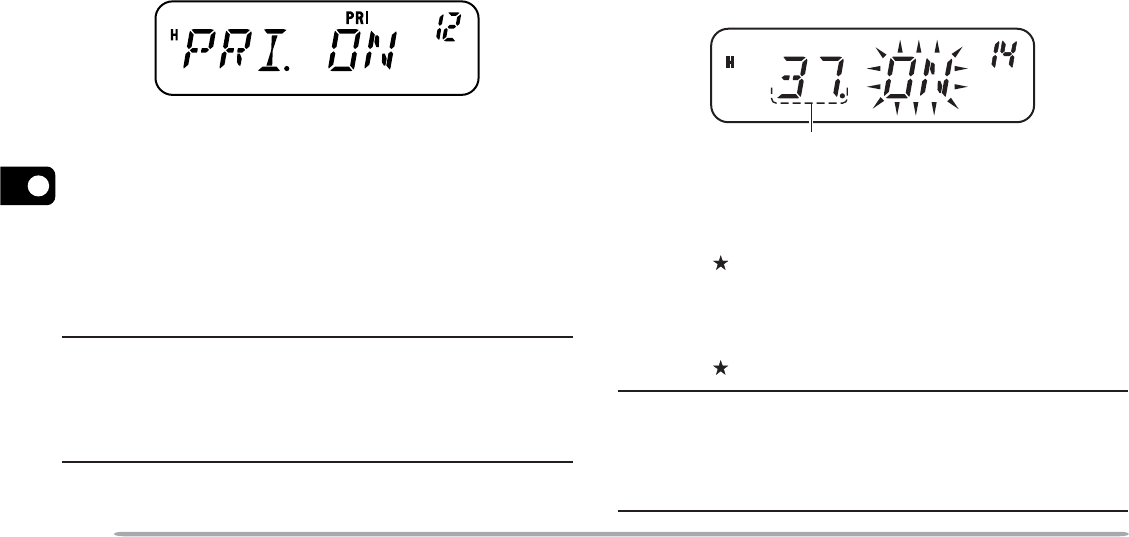
44
8
USING PRIORITY SCAN
1Press [F], [MENU] and turn the Tuning control to
select Menu No. 12 (PRI).
2Press [MENU] and turn the Tuning control to select
“ON”.
3Press [MENU] to store the setting or any other key to
cancel.
•“PRI” appears.
4Press any key other than [MENU] to exit Menu Mode.
•The transceiver checks for a signal on the Priority
Channel every 3 seconds.
•When the transceiver detects a signal on the Priority
Channel, “Pr” blinks and the frequency changes to the
Priority Channel.
•If you do not operate any control or key for 3 seconds
after the signal drops, the transceiver returns to the
original frequency and resumes Priority Scan.
Note:
◆If you clear the Priority Channel {page 31}, Priority Scan stops.
◆Priority Scan temporarily stops while the transceiver is
transmitting.
◆If Program Scan is set to ON, the Weather Alert function is
automatically turned OFF.
MEMORY CHANNEL LOCKOUT
You can lock out Memory Channels that you prefer not to
monitor during Memory Scan {page 42}.
1Press [MR] and turn the Tuning control to select the
Memory Channel to be locked out.
2Press [F], [MENU] and turn the Tuning control to
select Menu No. 14 (L.OUT).
3Press [MENU] and turn the Tuning control to select
“ON”.
Memory Channel Number
4Press [MENU] to store the setting or any other key to
cancel.
5Press any key other than [MENU] to exit Menu Mode.
•The “ ” icon appears below the Memory Channel
number, indicating the channel is locked out.
6To unlock the Memory Channel, repeat steps 1 ~ 5,
selecting “OFF” in step 3.
•The “ ” icon disappears.
Note:
◆The Program Scan channels (L0/U0 ~ L2/U2), Call Channel,
Priority Channel (Pr), and Weather Radio Channel (AL) (K market
only) cannot be locked out.
◆Even if a Memory Channel is locked out, you can perform Call
Scan {page 43} between the Call Channel and Memory Channel.

45
8
SCAN RESUME METHOD
The transceiver stops scanning at the frequency (or
Memory Channel) where a signal is detected. It then
continues or stops scanning according to which Resume
Mode you have selected.
•Time-Operated Mode (default)
The transceiver remains on a busy frequency (or
Memory Channel) for approximately 5 seconds, then
continues to scan even if the signal is still present.
•Carrier-Operated Mode
The transceiver remains on a busy frequency (or
Memory Channel) until the signal drops out. There is
a 2-second delay between signal dropout and scan
resumption.
•Seek Mode
The transceiver moves to a frequency or Memory
Channel where a signal is present and stops.
To change the scan resume method:
1Press [F], [MENU] and turn the Tuning control to
select Menu No. 13 (SCAN).
2Press [MENU] and turn the Tuning control to select
“TO” (Time-Operated; default), “CO” (Carrier-
Operated), or “SE” (Seek) Mode.
3Press [MENU] to store the new setting or any other
key to cancel.
4Press any key other than [MENU] to exit Menu Mode.
Note: To temporarily stop scanning and monitor weak signals, press
the Mic PF key assigned the MONI function {page 59}. Press the
MONI key again to resume scanning.
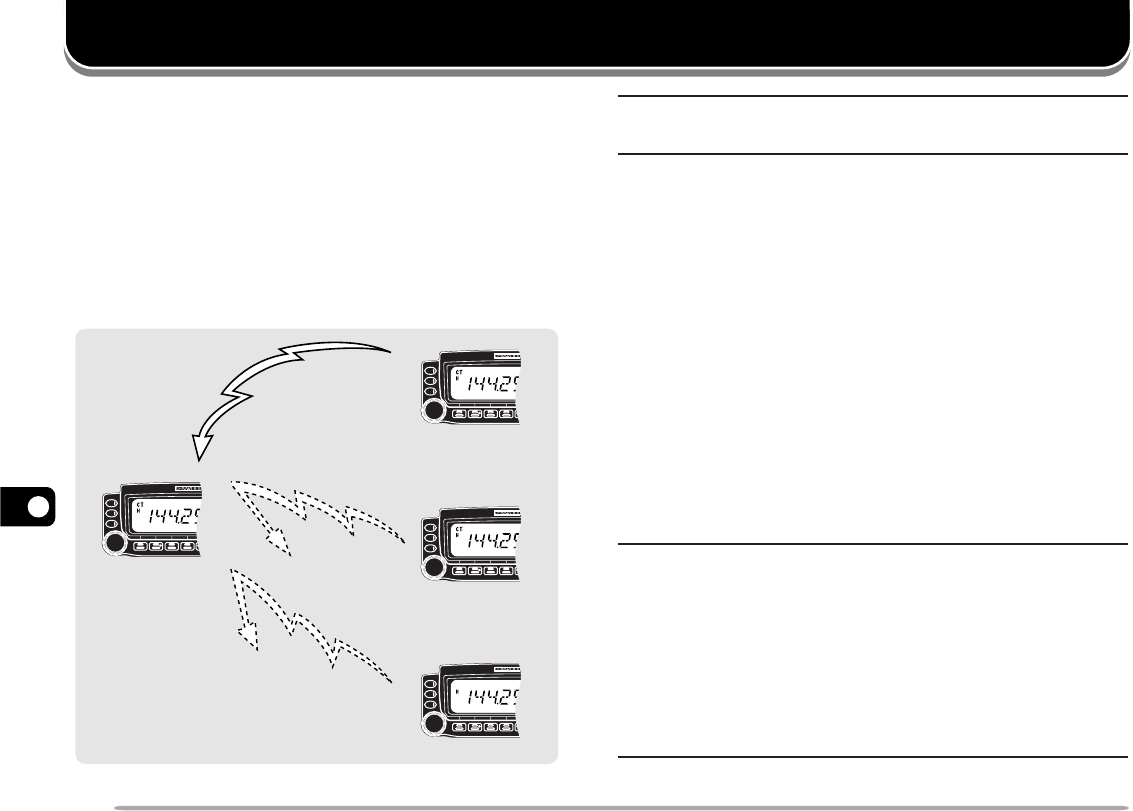
46
9
SELECTIVE CALL
CTCSS AND DCS
You may sometimes want to hear calls from only specific
persons or groups. In this case, use Selective Call. This
transceiver is equipped with CTCSS (Continuous Tone
Coded Squelch System) and DCS (Digital Coded Squelch).
These Selective Calls allow you to ignore (not hear)
unwanted calls from other persons who are using the same
frequency. The transceiver unmutes only when it receives
a signal having the same CTCSS tone or DCS code.
Received
Rejected
Rejected
CTCSS freq.:
82.5 Hz
CTCSS freq.:
82.5 Hz
CTCSS OFF
CTCSS freq.:
100 Hz
Note: CTCSS and DCS do not cause your conversation to be private
or scrambled. It only relieves you from listening to unwanted
conversations.
CTCSS
A CTCSS tone is a sub-audible tone and is selectable
from among the 42 tone frequencies listed in the table
on page 47. The list includes 37 EIA standard tones and
5 non-standard tones.
To activate CTCSS, press [F], [CALL].
•As you press [F], [CALL], the selection cycles as follows:
“OFF” ➞ “TONE” ➞ “CTCSS” ➞ “DCS” ➞ “OFF”.
•“CT” appears on the upper part of display, indicating that
the CTCSS function is activated.
When CTCSS is ON, you will hear calls only when the
selected CTCSS tone is received. To answer the call, press
and hold Mic [PTT], then speak into the microphone.
Note:
◆You cannot use the CTCSS and Tone/ DCS functions
simultaneously. Switching the CTCSS function ON after having
activated the Tone/ DCS functions deactivates the Tone/ DCS
functions.
◆If you select a high CTCSS frequency, receiving audio or noise
that contains the same frequency portions may cause CTCSS to
function incorrectly. To prevent noise from causing this problem,
select an appropriate squelch level {page 14}.
◆While transmitting the 1750 Hz tone by pressing [CALL]
{page 25}, the transceiver does not transmit the CTCSS tone.
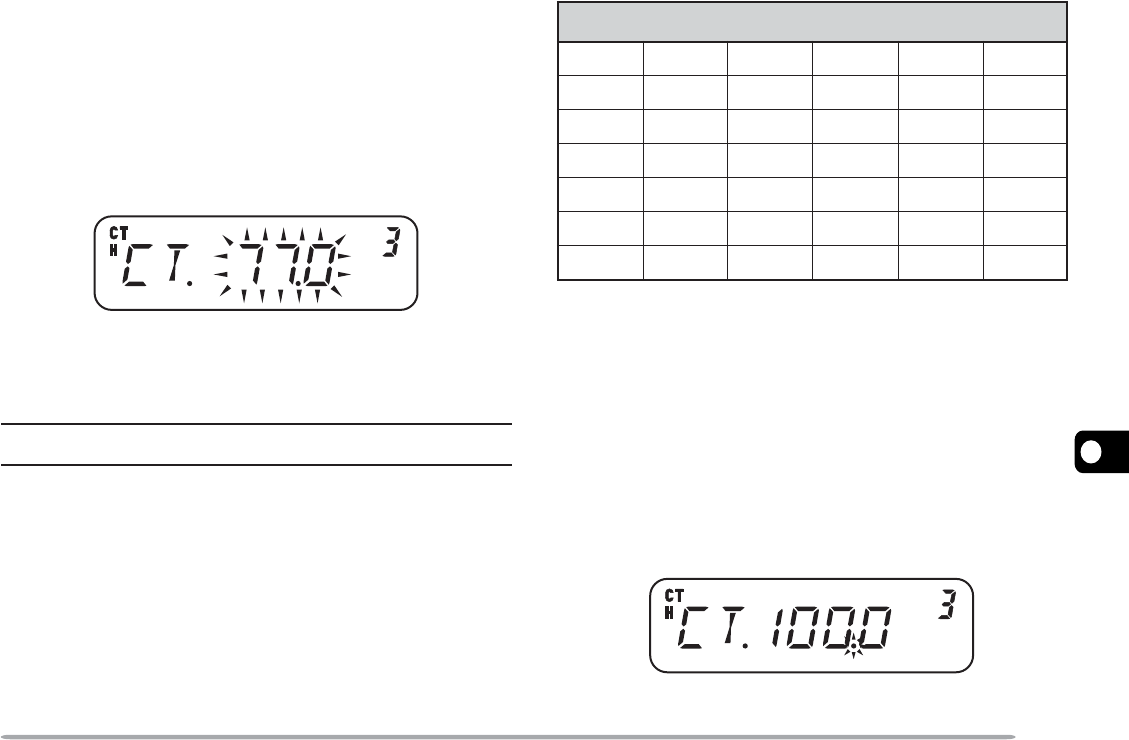
47
9
SELECTING A CTCSS FREQUENCY
1Press [F], [MENU] and turn the Tuning control or
press Mic [UP]/[DWN] to select Menu No. 3 (CT).
•The current CTCSS frequency appears.
2Press [MENU] and turn the Tuning control to select
your desired CTCSS frequency.
•The selectable CTCSS frequencies are the same as
those for the Tone frequency. Refer to the table on the
following page for the available CTCSS frequencies.
3Press [MENU] to store the new setting or any other
key to cancel.
4Press any key other than [MENU] to exit Menu Mode.
Note: To use the selected CTCSS tone, you must first turn the
CTCSS function ON.
Available CTCSS Tone Frequencies
)zH(seicneuqerFenoT24
0.764.582.7015.6318.3711.812
3.965.889.0113.1419.9717.522
9.175.198.4112.6412.6811.922
4.478.498.8114.1518.2916.332
0.774.790.3217.6515.3028.142
7.970.0013.7212.2615.6023.052
5.285.3018.1319.7617.0121.452
CTCSS FREQUENCY ID SCAN
This function scans through all CTCSS frequencies to
identify the incoming CTCSS frequency on the received
signal. You may find this useful when you cannot recall
the CTCSS frequency that the other persons in your
group are using.
1Press [F], [MENU] and turn the Tuning control to
select Menu No. 3 (CT).
2Press [MENU] (1s) to start the CTCSS Frequency ID
Scan.

48
9
•While scanning, the decimal point of the CTCSS
frequency blinks.
•To reverse the scan direction, turn the Tuning control or
press Mic [UP]/[DWN].
•To quit the function, press any key.
•When a CTCSS frequency is identified, the identified
frequency appears and blinks.
3Press [MENU] to program the identified frequency in
place of the current CTCSS frequency or press any
other key to exit the CTCSS Frequency ID Scan.
•Turn the Tuning control or press Mic [UP]/[DWN] while
the identified frequency is blinking to resume scanning.
4Press any key other than [MENU] to exit Menu Mode.
Note:
◆CTCSS turns ON automatically when performing CTCSS
Frequency ID Scan, even if the current frequency is not set with
CTCSS.
◆Received signals are monitored through the speaker while
scanning is in progress.
◆The transceiver continues to check the Weather Alert Channel
and Priority Channel during CTCSS scanning.
◆CTCSS Frequency ID Scan does not scan the tone if a signal is
not detected.
DCS
DCS is similar to CTCSS. However, instead of using an
analog audio tone, it uses a continuous sub-audible
digital waveform that represents a 3-digit octal number.
You can select a DCS code from among the 104 DCS
codes listed in the table below.
To activate DCS, press [F], [CALL].
•As you press [F], [CALL], the selection cycles as follows:
“OFF” ➞ “TONE” ➞ “CTCSS” ➞ “DCS” ➞ “OFF”.
•“DCS” appears on the upper part of display, indicating that
the DCS function is activated.
When DCS is ON, you will hear calls only when the
selected DCS code is received. To answer the call, press
and hold Mic [PTT], then speak into the microphone.
Note: You cannot use the DCS function and CTCSS/ Tone functions
simultaneously. Switching the DCS function ON after having activated
the CTCSS/ Tone functions deactivates the CTCSS/ Tone functions.
SELECTING A DCS CODE
1Press [F], [MENU] and turn the Tuning control to
select Menu No. 4 (DCS).
•The current DCS code appears.
2Press [MENU] and turn the Tuning control to select
your desired DCS code.
•The current DCS code appears and blinks.
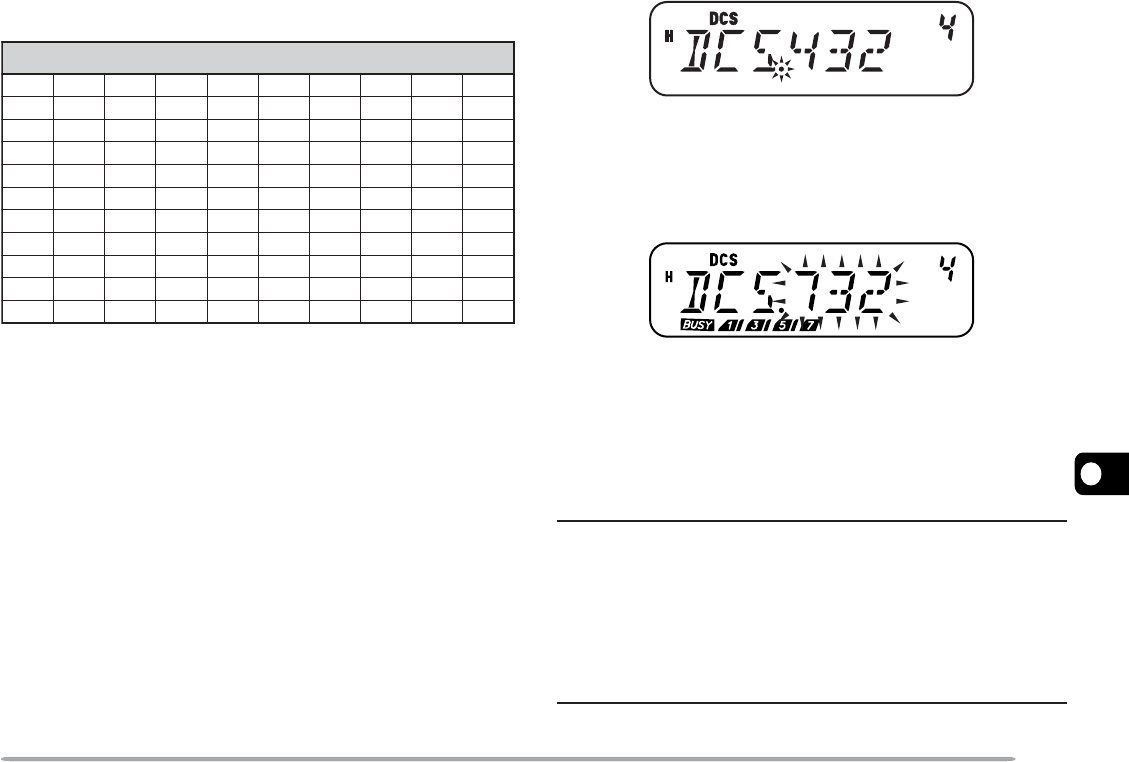
49
9
•The available DCS codes are shown in the following
table.
sedoCSCD401
320560231502552133314564216137
520170431212162233324664426237
620270341322362343134305726437
130370541522562643234605136347
230470251622662153544615236457
630411551342172653644325456
340511651442472463254625266
740611261542603563454235466
150221561642113173554645307
350521271152513114264565217
450131471252523214464606327
3Press [MENU] to store the new code or any other key
to cancel.
4Press any key other than [MENU] to exit Menu Mode.
DCS CODE ID SCAN
This function scans through all DCS codes to identify the
incoming DCS code on the received signal. You may
find this useful when you cannot recall the DCS code
that the other persons in your group are using.
1Press [F], [MENU] and turn the Tuning control to
select Menu No. 4 (DCS).
2Press [MENU] (1s) to start the DCS Code ID Scan
function.
•While scanning, the decimal point between “DCS” and
the DCS code blinks.
•To quit the function, press any key.
•When a DCS code is identified, the identified DCS code
appears and blinks.
3Press [MENU] to program the identified DCS code in
place of the current DCS code or press any other key
to exit the DCS Code ID Scan.
•Turn the Tuning control or press Mic [UP]/[DWN] while
the identified DCS code is blinking to resume scanning.
4Press any key other than [MENU] to exit Menu Mode.
Note:
◆DCS turns ON automatically when performing DCS Code ID
Scan, even if the current frequency is not set with DCS.
◆Received signals are monitored through the speaker while
scanning is in progress.
◆The transceiver continues to check the Weather Alert Channel
and Priority Channel during DCS scanning.
◆DCS Code ID Scan does not scan the code if a signal is not
detected.
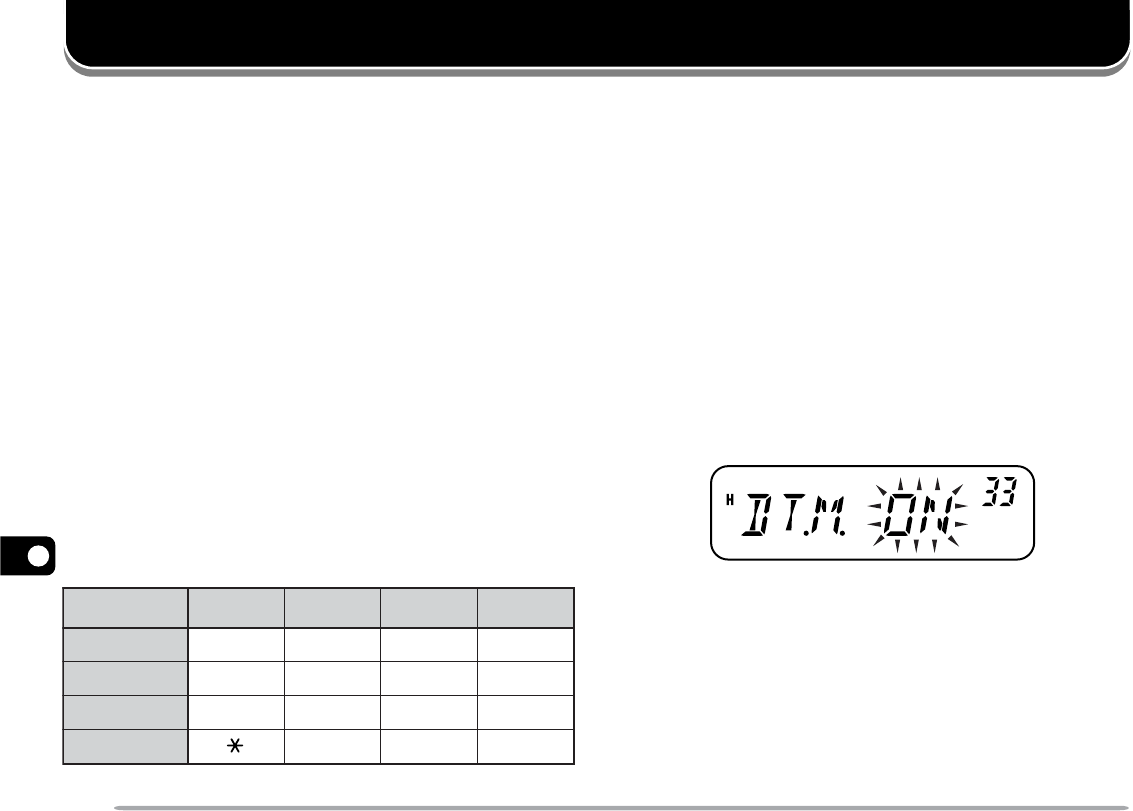
50
10
DUAL TONE MULTI-FREQUENCY (DTMF) FUNCTIONS
This transceiver provides you with 10 dedicated DTMF
Memory Channels. You can store a DTMF number (16
digits max.) in each of these channels to recall later for
speed dialing.
Many repeaters in the U.S.A. and Canada offer a service
called Autopatch. You can access the public telephone
network via such a repeater by sending DTMF tones. For
further information, consult your local repeater reference.
MANUAL DIALING
The keys on the Mic keypad function as DTMF keys; the
12 keys found on a push-button telephone plus 4
additional keys (A, B, C, D).
To perform Manual Dialing, follow the steps below.
1Press and hold Mic [PTT] to transmit.
2While transmitting, press the keys in sequence on the
keypad, to send the DTMF tones.
•The corresponding DTMF tones are transmitted.
)zH(.qerF 9021 6331 7741 3361
796 123A
077 456B
258 789C
149 0#D
•When DTMF TX Hold is activated {below}, you do not
need to continuously press Mic [PTT] to remain in
transmission mode. However, transmission mode is
retained for only 2 seconds after pressing a key, so if the
next key is not pressed within this time limit, the
transceiver stops transmitting.
DTMF MONITOR
When pressing the Mic DTMF keys, you will not hear
DTMF tones emitted from the speaker. However, you
can monitor the DTMF tones if desired.
1Press [F], [MENU] and turn the Tuning control to
select Menu No. 33 (DT.M).
2Press [MENU] and turn the Tuning control to select
“ON” or “OFF” (default).
3Press [MENU] to store the setting or any other key to
cancel.
4Press any key other than [MENU] to exit Menu Mode.
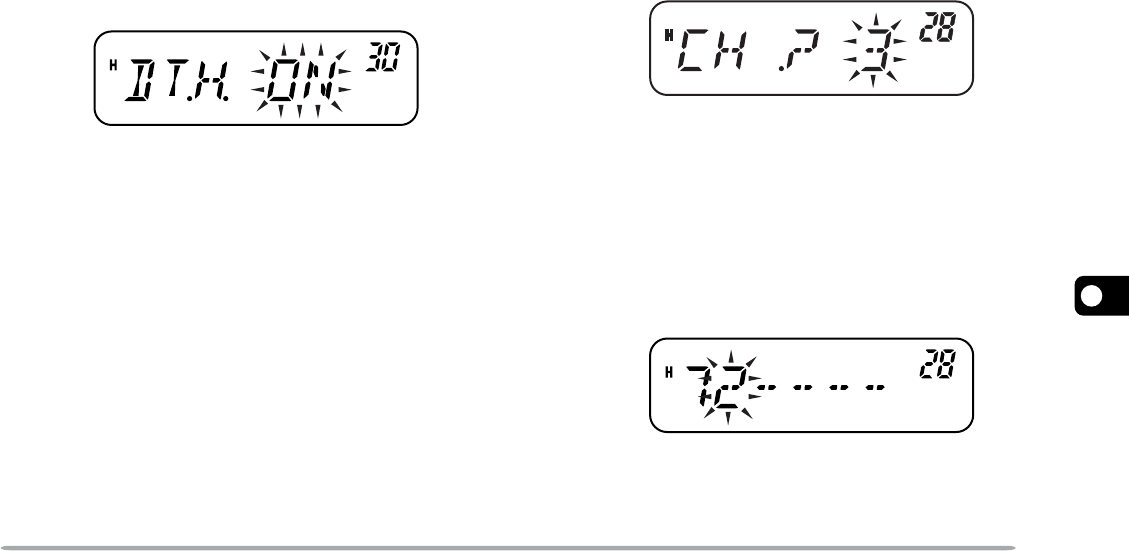
51
10
DTMF TX HOLD
This function causes the transceiver to remain in
transmission mode for 2 seconds after you release each
key. So, you can release Mic [PTT] while sending DTMF
tones.
1Press [F], [MENU] and turn the Tuning control to
select Menu No. 30 (DT.H).
2Press [MENU] and turn the Tuning control to select
“ON”.
3Press [MENU] to store the setting or any other key to
cancel.
4Press any key other than [MENU] to exit Menu Mode.
AUTOMATIC DIALER
If you use the 10 dedicated DTMF Memory Channels to
store DTMF numbers, you do not need to remember a
long string of digits.
STORING A DTMF NUMBER IN MEMORY
1Press [F], [MENU] and turn the Tuning control to
select Menu No. 28 (DTMF.MR).
2Press [MENU] and turn the Tuning control to select
your desired DTMF Memory Channel number from 0
to 9.
•You can also select a DTMF Memory Channel by using
Mic [UP]/[DWN].
3Press [MENU].
•The DTMF code entry display appears and the first digit
blinks.
4Turn the Tuning control to select a DTMF code.
•You can also enter a DTMF code using the Mic keypad.
Simply press your desired DTMF codes on the keypad.
5Press [MR] to select the DTMF code and move the
cursor to the next digit.
•To move to the previous digit, press [VFO]. To delete
the character at the current cursor position, press [F].

52
10
6Repeat steps 4 and 5 to enter up to 16 digits.
7Press [MENU] to complete the entry.
•Press any key other than [MR], [VFO], [F], and [MENU]
to cancel the entry.
•To complete an entry of less than 16 digits, press
[MENU] two times.
8Press any key other than [MENU] to exit Menu Mode.
CONFIRMING STORED DTMF NUMBERS
1Press [F], [MENU] and turn the Tuning control to
select Menu No. 28 (DTMF.MR).
2Press [MENU] and turn the Tuning control to select
your desired DTMF Memory Channel number from 0
to 9.
•You can also select a DTMF Memory Channel by using
Mic [UP]/[DWN].
3Press [REV].
•The numbers scroll across the display and the DTMF
tones emit from the speaker.
4Press any key other than [REV] or [MENU] to exit.
TRANSMITTING A STORED DTMF NUMBER
1Press Mic [PTT] + Mic [PF].
2Release Mic [PF] (continue pressing Mic [PTT]), then
press a key from 0 to 9 to transmit the desired DTMF
Memory Channel number.
•To transmit tone “D”, press Mic [PF] again.
•The number stored in the channel scrolls across the
display, accompanied by DTMF tones from the speaker.
(DTMF tones are not emitted if Menu No. 33 (DT.M) is
set to “OFF”.)
•After transmission, the frequency display is restored.
3Release Mic [PTT].
Note:
◆If you select an empty DTMF Memory Channel and press
[MENU], the frequency display is restored.
◆In step 2, above, you can preview the DTMF Memory Channels
first by turning the Tuning control or pressing Mic [UP]/[DWN].
ADJUSTING THE DTMF TONE TRANSMISSION SPEED
This transceiver allows you to configure the DTMF
number transmission speed between Fast (default) and
Slow. If a repeater cannot respond to the fast speed,
adjust this parameter.
1Press [F], [MENU] and turn the Tuning control to
select Menu No. 29 (SPD).
2Press [MENU] and turn the Tuning control to select
“FA” (Fast) or “SL” (Slow).
•The tone duration of Fast is 50 ms and Slow is 100 ms.
3Press [MENU] to store the setting or any other key to
cancel.
4Press any key other than [MENU] to exit Menu Mode.

53
10
ADJUSTING THE PAUSE DURATION
You can change the pause duration (a space digit)
stored in Memory Channels. The default setting is
500 milliseconds.
1Press [F], [MENU] and turn the Tuning control to
select Menu No. 31 (PA).
2Press [MENU] and turn the Tuning control to select
100/ 250/ 500 (default)/ 750/ 1000/ 1500/ 2000 ms.
3Press [MENU] to store the setting or any other key to
cancel.
4Press any key other than [MENU] to exit Menu Mode.
DTMF LOCK
You sometimes may want to disable the keypad to avoid
accidental DTMF transmission. In this case, turn the
DTMF Lock function ON.
1Press [F], [MENU] and turn the Tuning control to
select Menu No. 32 (DT.L).
2Press [MENU] and turn the Tuning control to select
“ON”.
3Press [MENU] to store the setting or any other key to
cancel.
4Press any key other than [MENU] to exit Menu Mode.
When this function is activated, you cannot send DTMF
tones using the Mic keypad. DTMF memory
transmission is also inhibited.
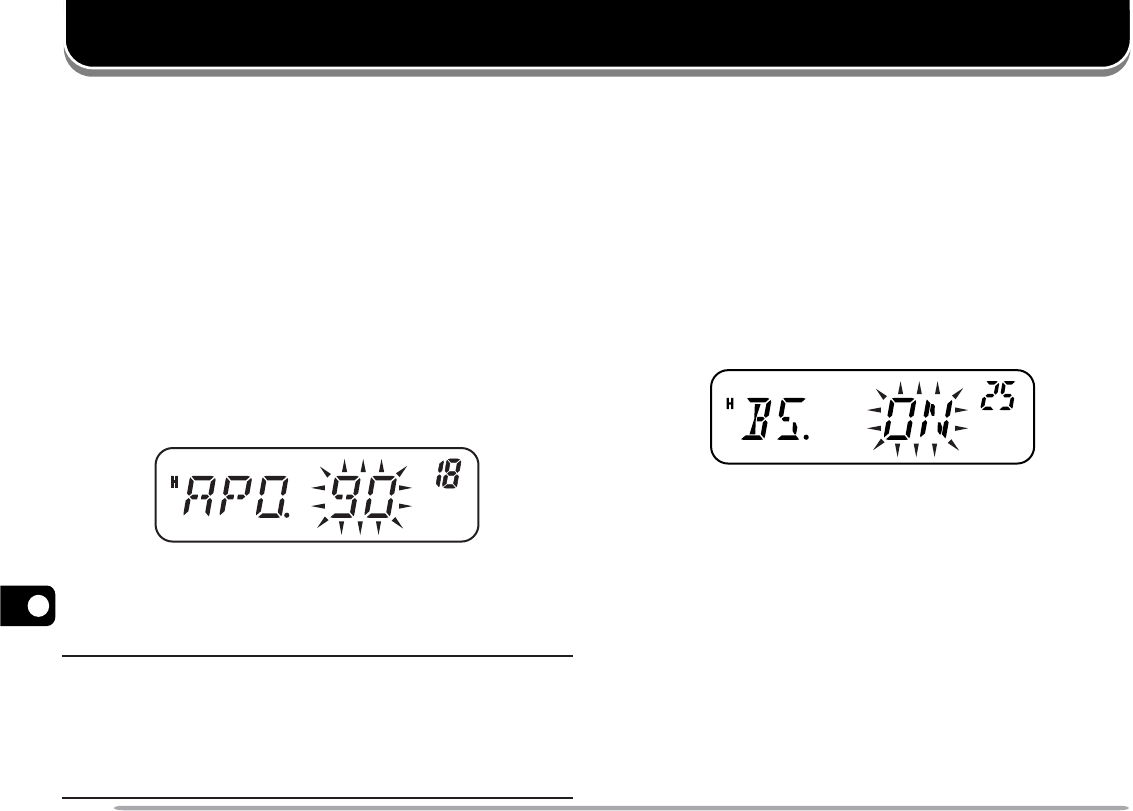
54
11
AUXILIARY FUNCTIONS
APO (AUTO POWER OFF)
The transceiver switches OFF automatically if no keys or
controls are pressed or adjusted for the selected
duration. One minute before the transceiver switches
OFF, warning beeps sound for a few seconds and “APO”
blinks.
You can select the APO time from OFF (disable), 30, 60,
90, 120, or 180 minutes.
1Press [F], [MENU] and turn the Tuning control to
select Menu No. 18 (APO).
2Press [MENU] and turn the Tuning control to select
the APO time from OFF (default), 30, 60, 90, 120, or
180 minutes.
3Press [MENU] to store the setting or any other key to
cancel.
4Press any key other than [MENU] to exit Menu Mode.
Note:
◆APO continues to count even while the transceiver is scanning.
◆The APO timer starts counting down the time when no key
presses, no control adjustments, and no PC control command
sequences are detected.
◆The APO warning beep sounds even if Menu No. 24 (BP)
{page 55} is set to “OFF” or the volume level is 0.
BEAT SHIFT
Since the transceiver uses a microprocessor to control
various functions of the transceiver, the CPU clock
oscillator’s harmonics or image may appear on some
spots of the reception frequencies. In this case, turn the
Beat Shift function ON.
1Press [F], [MENU] and turn the Tuning control to
select Menu No. 25 (BS).
2Press [MENU] and turn the Tuning control to select
“ON” or “OFF” (default).
3Press [MENU] to store the setting or any other key to
cancel.
4Press any key other than [MENU] to exit Menu Mode.
S-METER SQUELCH
S-meter Squelch causes the squelch to open only when
a signal with a strength greater than or the same as the
S-meter setting is received. This function relieves you
from constantly resetting the squelch when receiving
weak stations you have no interest in.
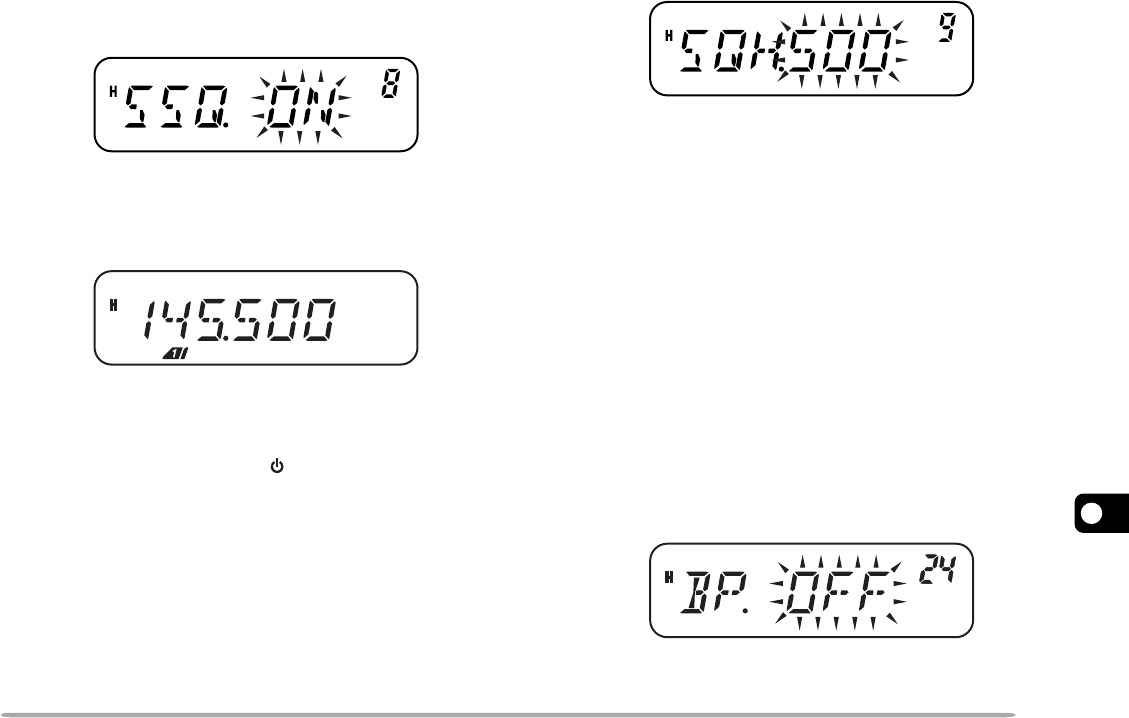
55
11
1Press [F], [MENU] and turn the Tuning control to
select Menu No. 8 (SSQ).
2Press [MENU] and turn the Tuning control to select
“ON” or “OFF” (default).
3Press [MENU] to store the setting.
•The S-meter setting segments appear.
4Press any key other than [MENU] to exit Menu Mode.
5Press [F], [REV] to enter S-Meter Level Select Mode.
6Turn the Tuning control to select your desired level.
7Press any key other than [ ] (Power) to store the
setting and exit S-Meter Level Select Mode.
SQUELCH HANG TIME
When using S-meter Squelch, you may want to adjust
the time interval between when the received signals drop
and when the squelch closes.
1Press [F], [MENU] and turn the Tuning control to
select Menu No. 9 (SQH).
2Press [MENU] and turn the Tuning control to select
from OFF (default), 125, 250, and 500 ms.
3Press [MENU] to store the setting or any other key to
cancel.
4Press any key other than [MENU] to exit Menu Mode.
BEEP FUNCTION
The Beep function provides confirmation of entry, error
status, and malfunctions of the transceiver. We
recommend you leave this function ON in order to detect
erroneous operations and malfunctions.
However, to turn the beep function OFF:
1Press [F], [MENU] and turn the Tuning control to
select Menu No. 24 (BP).
2Press [MENU] and turn the Tuning control to select
“OFF”.
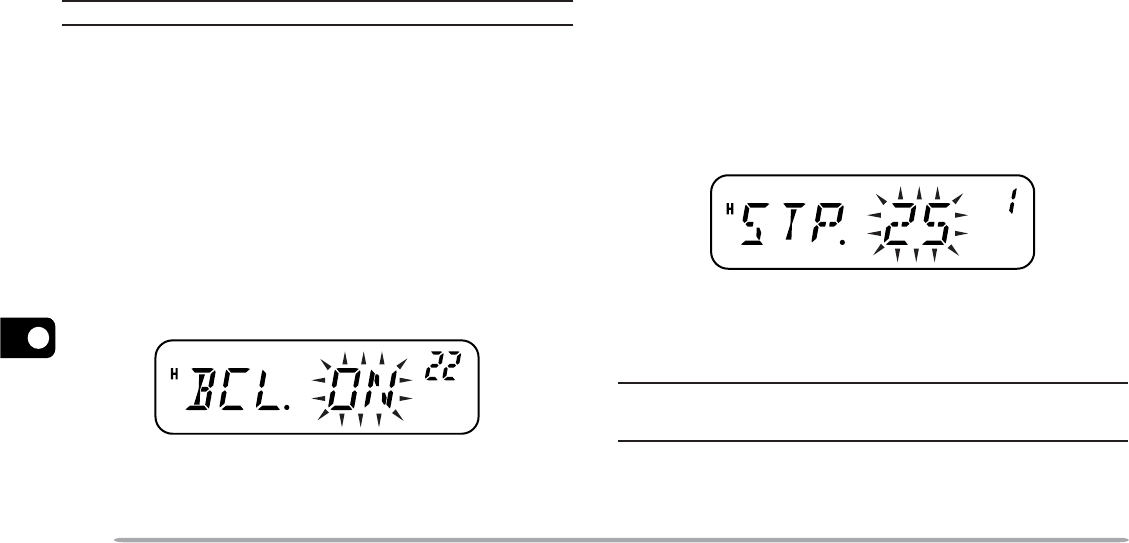
56
11
3Press [MENU] to store the setting or any other key to
cancel.
4Press any key other than [MENU] to exit Menu Mode.
The transceiver generates the following warning beeps
even if the Beep function is turned OFF.
•APO warning beeps {page 54}
•Weather Alert beep {page 36}
•Time-out Timer warning beep {page 62}
Note: The beep output level is linked to the VOL control position.
BUSY CHANNEL LOCKOUT
This function is used to prevent transmitting on a
channel or frequency that somebody else is currently
using. When turned ON, an error beep sounds and you
cannot transmit even if you press Mic [PTT] while
another party is using the channel or frequency.
1Press [F], [MENU] and turn the Tuning control to
select Menu No. 22 (BCL).
2Press [MENU] and turn the Tuning control to select
“ON” or “OFF” (default).
3Press [MENU] to store the setting or any other key to
cancel.
4Press any key other than [MENU] to exit Menu Mode.
FREQUENCY STEP SIZE
Choosing the correct frequency step size is essential in
selecting your exact receive frequency using the Tuning
control or Mic [UP]/[DWN]. You can select your desired
frequency step size from:
2.5 kHz, 5 kHz, 6.25 kHz, 10 kHz, 12.5 kHz, 15 kHz, 20
kHz, 25 kHz, 30 kHz, 50 kHz, 100 kHz.
To change the frequency step size:
1While in VFO Mode, press [F], [MENU] and turn the
Tuning control to select Menu No. 1 (STP).
2Press [MENU] and turn the Tuning control to select
your desired frequency step size.
3Press [MENU] to store the setting or any other key to
cancel.
4Press any key other than [MENU] to exit Menu Mode.
Note: If you change to a frequency step size that does not match the
current operating frequency, the transceiver automatically adjusts the
frequency to match the new frequency step size.
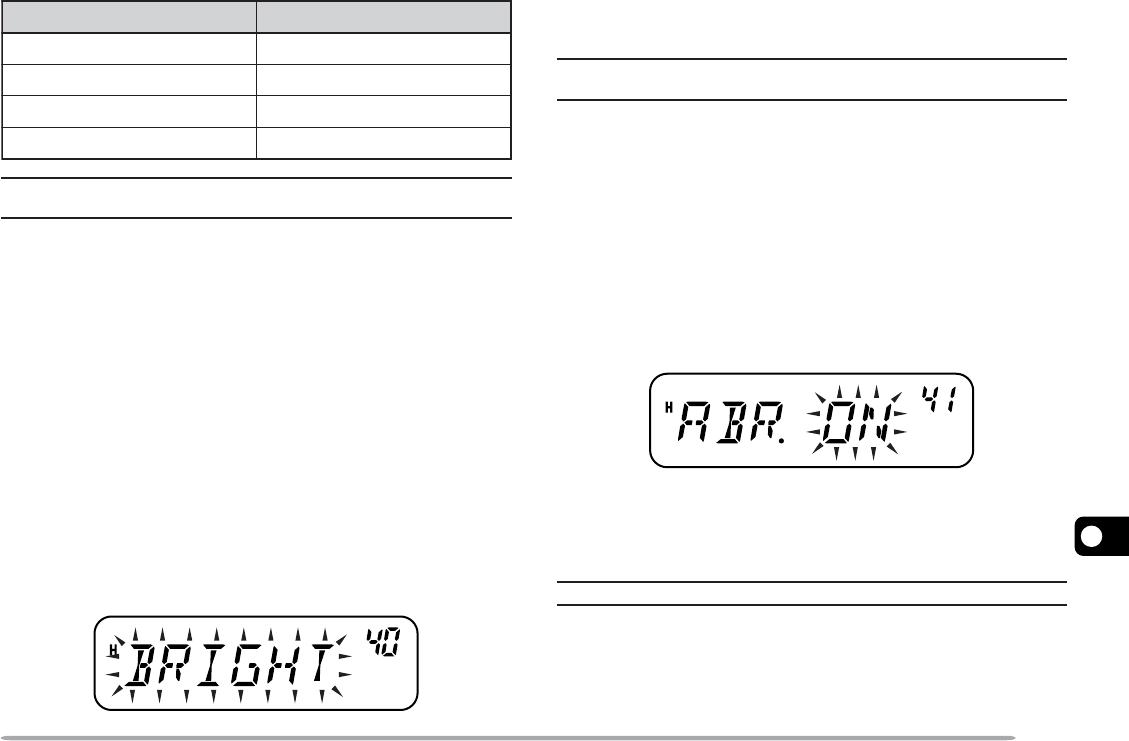
57
11
The default step size for each model is as follows:
edoCtekraM eziSpetSycneuqerFtluafeD
KzHk5
EzHk5.21
2MzHk5.21
3MzHk5.21
Note: The market code is printed on the barcode label of the carton
box.
DISPLAY BACKLIGHT
You can manually change the display brightness to
match the lighting conditions where you are operating
the transceiver. This setting can be permanent or the
display can light up only when keys are pressed.
PERMANENT BACKLIGHT
When a permanent setting is selected, the backlight will
remain at that setting until it is changed again.
1Press [F], [MENU] and turn the Tuning control to
select Menu No. 40 (BRIGHT).
2Press [MENU] and turn the Tuning control to adjust
the display brightness.
3Press [MENU] to store the setting or any other key to
cancel.
4Press any key other than [MENU] to exit Menu Mode.
Note: Setting the brightness to OFF (minimum level 1) will turn the
front panel key backlight OFF.
AUTOMATIC BACKLIGHT
When using automatic backlight, the display backlight
will illuminate every time a front panel or microphone key
is pressed. The backlight remains on for 5 seconds
before it turns off again.
1Press [F], [MENU] and turn the Tuning control to
select Menu No. 41 (ABR).
2Press [MENU] and turn the Tuning control to select
“ON” or “OFF” (default).
3Press [MENU] to store the setting or any other key to
cancel.
4Press any key other than [MENU] to exit Menu Mode.
Note: No change occurs if the brightness is set to the highest level.

58
11
LOCK FUNCTION
The lock function disables most of the keys to prevent
you from accidentally activating a function. Transceiver
Lock is suitable for a typical mobile installation where
you select most operations using the microphone.
1Press [F] (1s).
•“ ” appears when this function is ON.
•The following keys cannot be locked:
[ ] (Power), [ ] (Power) + [Key], [F] (1s), [F]+[REV],
Volume control, [PTT], and the Mic keypad.
2Press [F] (1s) again to unlock the keys.
Note:
◆The Tuning control is also locked. To retain use of the Tuning
control while the Lock function is ON, access Menu No. 27 (ENC)
{below} and select “ON”.
◆You cannot reset the transceiver {page 67} while the Lock function
is ON.
◆Microphone PF keys {page 59} operate normally even if the Lock
function is ON.
DATA COMMUNICATION SPEED
When the transceiver is connected to a TNC {page 7},
you can adjust the communication speed between
1200 bps and 9600 bps.
1Press [F], [MENU] and turn the Tuning control to
select Menu No. 39 (DT).
2Press [MENU] and turn the Tuning control to select
“1200” (default) or “9600”.
3Press [MENU] to store the setting or any other key to
cancel.
4Press any key other than [MENU] to exit Menu Mode.
TUNE ENABLE
While the Lock function is ON, you sometimes may want
to turn the Tuning control to change the frequency. In
this case, turn the Tune Enable function ON.
1Press [F], [MENU] and turn the Tuning control to
select Menu No. 27 (ENC).
2Press [MENU] and turn the Tuning control to select
“OFF” (default) or “ON”.

59
11
3Press [MENU] to store the setting or any other key to
cancel.
4Press any key other than [MENU] to exit Menu Mode.
MICROPHONE PF KEYS (KEYPAD MODELS ONLY)
You can access many transceiver settings without using
transceiver keys or controls. Microphone keys PF/D,
MR/C, VFO/B, and CALL/A are programmable with
transceiver functions.
The microphone key default assignments are as follows:
Mic PF1 key [PF/D]:1 MHz step
Mic PF2 key [MR/C]:Memory Recall
Mic PF3 key [VFO/B]:VFO Select
Mic PF4 key [CALL/A]:Call Channel Select
1750 Hz tone (E models only)
Note:
◆Turn the transceiver OFF before connecting the speaker/
microphone.
◆Menu No. 34 (MCL) must be configured to “OFF” in order to
program the microphone keys.
1Press [F], [MENU] and turn the Tuning control to
select one of Menu No. 35 to Menu No. 38
(PF 1 ~ PF 4).
2Press [MENU] and turn the Tuning control to select
the programmable function from the list provided
below.
3Press [MENU] to store the setting or any other key to
cancel.
4Press any key other than [MENU] to exit Menu Mode.
Programmable Functions
•MONI: Monitor function ON/OFF
•ENTER: Used to enter a frequency or memory channel
number with the keypad
•1750: Transmit 1750 Hz
•VFO: Enter VFO Mode
•MR: Enter MR Mode
•CALL: Select the Call Channel
•MHZ: Enter 1 MHz Step Mode
•REV: Reverse function ON/OFF (momentary press) and
Auto Simplex Checker function ON/OFF (must be held
down for 1 second to activate)
•SQL: Enter Squelch Mode
•M--V: Memory to VFO transfer
•M.IN: Store a Memory Channel
•C.IN: Store the Call Channel
•MENU: Enter Menu Mode

60
11
•SHIFT: Shift function ON/OFF
•LOW: Select transmission power
•BRIGHT: Adjust display backlight
•LOCK: Transceiver Lock function ON/OFF (must be held
down for 1 second to activate)
•TONE: Selection for Tone/ Selective Call
•STEP: Select the frequency step size
Note: Rather than entering Menu Mode and selecting PF1 ~ PF4,
you can simply press and hold the PF key you want to program, then
turn the transceiver power ON. When programming the PF keys in
this manner, select the function by turning the Tuning control or
pressing Mic [UP]/[DWN], press [MENU] to store the setting, then
press any key other than [MENU] to exit Menu Mode.
NARROW BAND FM OPERATION
By default, the transceiver operates in normal FM
(±5 kHz) mode for both transmission and reception. You
can also operate the transceiver in narrow band FM
(±2.5 kHz).
To operate the transceiver in narrow band FM:
1Press [F], [MENU] and turn the Tuning control to
select Menu No. 26 (FMN).
2Press [MENU] and turn the Tuning control to select
“ON” or “OFF” (default).
3Press [MENU] to store the setting or any other key to
cancel.
4Press any key other than [MENU] to exit Menu Mode.
When narrow band FM operation is ON, “N” appears in
the top right of the LCD.
Note: You can store the narrow band FM operation status to the
Memory Channels {page 29}.
POWER-ON MESSAGE
You can change the Power-on message (a maximum of
6 characters) when the transceiver is turned ON.
1Press [F], [MENU] and turn the Tuning control to
select Menu No. 23 (P.ON.MSG).
2Press [MENU].
•The current message and entry cursor appear.

61
11
3Turn the Tuning control to select a character.
•You can enter the following alphanumeric characters:
0 ~ 9, A ~ Z, – (hyphen), / (slash), and a space.
•Rather than using the Tuning control, you can use the
Mic keypad (keypad models only) to enter alphanumeric
characters {page 64}.
4Press [MR] to move to the next digit.
•To move to the previous digit, press [VFO]. To delete
the character at the current cursor position, press [F].
5Repeat steps 3 and 4 to enter up to 6 digits.
6Press [MENU] to complete the setting and store the
Power-on message.
7Press any key other than [MENU] to exit Menu Mode.
Note: If a Power-on message is not set, the transceiver model name
appears when the transceiver power is turned ON.
PROGRAMMABLE VFO
To limit the operating frequencies within a certain range,
program the upper and lower frequency limits to the
program VFO parameters. For example, if you select
144 MHz for the lower limit and 145 MHz for the upper
limit, the tunable range will be limited from 144.000 MHz
to 145.9975 MHz.
1Press [F], [MENU] and turn the Tuning control to
select Menu No. 7 (P.VFO).
•The current programmable frequency range for the band
appears.
2Press [MENU] and turn the Tuning control to select
the lower limit frequency (in MHz).
3Press [MENU] and turn the Tuning control to select
the upper limit frequency (in MHz).
4Press [MENU] to store the setting or any other key to
cancel.
5Press any key other than [MENU] to exit Menu Mode.
Note:
◆You cannot program the 100 kHz or lower digits.
◆The upper limit frequency cannot be set lower than the selected
lower limit frequency.

62
11
TIME-OUT TIMER
The Time-out Timer limits the time of each transmission
to a maximum of 3, 5, or 10 (default) minutes. Just
before the transceiver stops the transmission, a warning
beep sounds. This function is necessary to protect the
transceiver from thermal damage and can therefore not
be turned OFF.
1Press [F], [MENU] and turn the Tuning control to
select Menu No. 21 (TOT).
2Press [MENU] and turn the Tuning control to select
“3”, “5” or “10” (default) minutes.
3Press [MENU] to store the setting or any other key to
cancel.
4Press any key other than [MENU] to exit Menu Mode.
Note: A warning beep sounds even if you set Menu No. 24 (BP) to
OFF {page 55}.
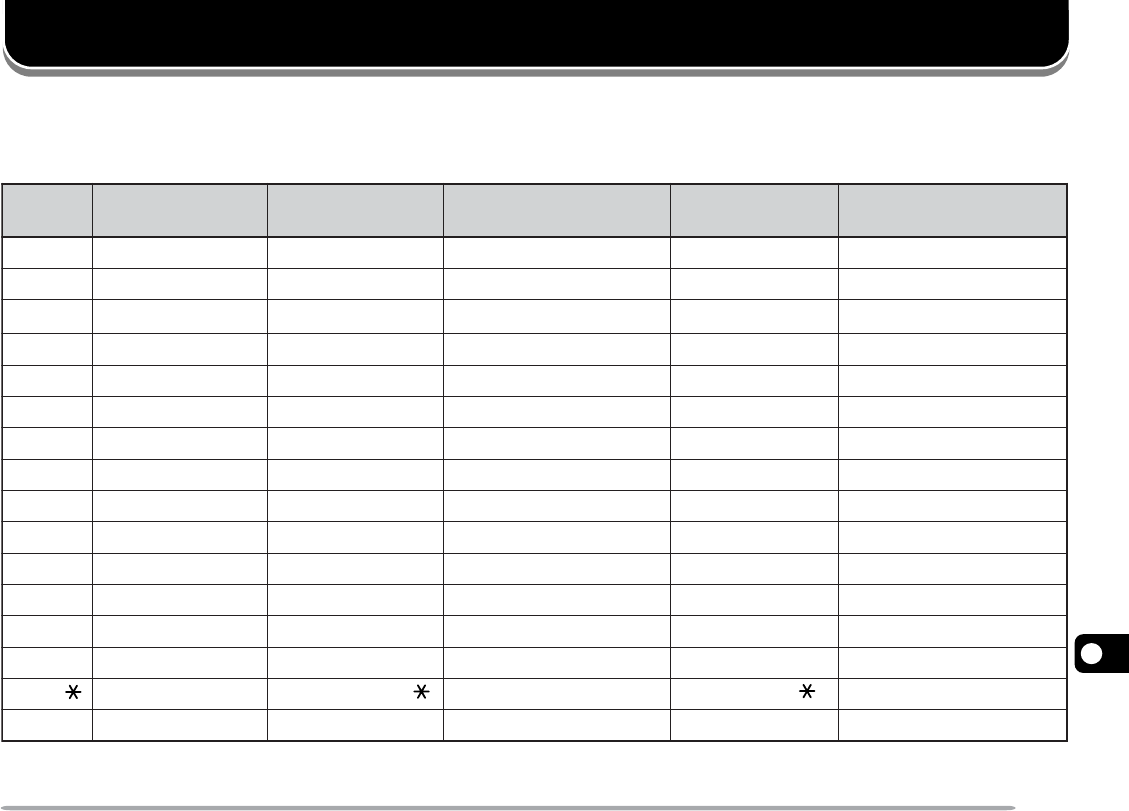
63
12
MICROPHONE CONTROL
You can change numerous transceiver settings by operating the Mic DTMF keys.
The following table shows what function is switched ON and OFF or which setting is changed by pressing the DTMF
keys in the appropriate mode of operation.
yeK edoMXR edoMXT
1
emaNyromeMgnirotS FMTDgnirotS
yromeM
no-rewoPgnirotS
egasseM
1A/N1enoTtimsnarTwoleb,etoneeS1edoCtupnIwoleb,etoneeS
2A/N2enoTtimsnarTwoleb,etoneeS2edoCtupnIwoleb,etoneeS
3A/N3enoTtimsnarTwoleb,etoneeS3edoCtupnIwoleb,etoneeS
4A/N4enoTtimsnarTwoleb,etoneeS4edoCtupnIwoleb,etoneeS
5A/N5enoTtimsnarTwoleb,etoneeS5edoCtupnIwoleb,etoneeS
6A/N6enoTtimsnarTwoleb,etoneeS6edoCtupnIwoleb,etoneeS
7A/N7enoTtimsnarTwoleb,etoneeS7edoCtupnIwoleb,etoneeS
8A/N8enoTtimsnarTwoleb,etoneeS8edoCtupnIwoleb,etoneeS
9A/N9enoTtimsnarTwoleb,etoneeS9edoCtupnIwoleb,etoneeS
0A/N0enoTtimsnarTwoleb,etoneeS0edoCtupnIwoleb,etoneeS
A/LLACnoitcnufdengissAAenoTtimsnarTretcarahctnerruceteleDAedoCtupnIretcarahctnerruceteleD
B/OFVnoitcnufdengissABenoTtimsnarT
tigidsuoiverpotrosrucevoM
BedoCtupnI
tigidsuoiverpotrosrucevoM
C/RMnoitcnufdengissACenoTtimsnarTtigidtxenotrosrucevoMCedoCtupnItigidtxenotrosrucevoM
D/FPnoitcnufdengissADenoTtimsnarT
2
emaNyromeMmrifnoCDedoCtupnI
egasseMno-rewoPmrifnoC
/NWD __ nwoDenoTtimsnarT _nwodretcarahcevoMedoCtupnI _nwodretcarahcevoM
#/PUpU#enoTtimsnarTpuretcarahcevoM#edoCtupnIpuretcarahcevoM
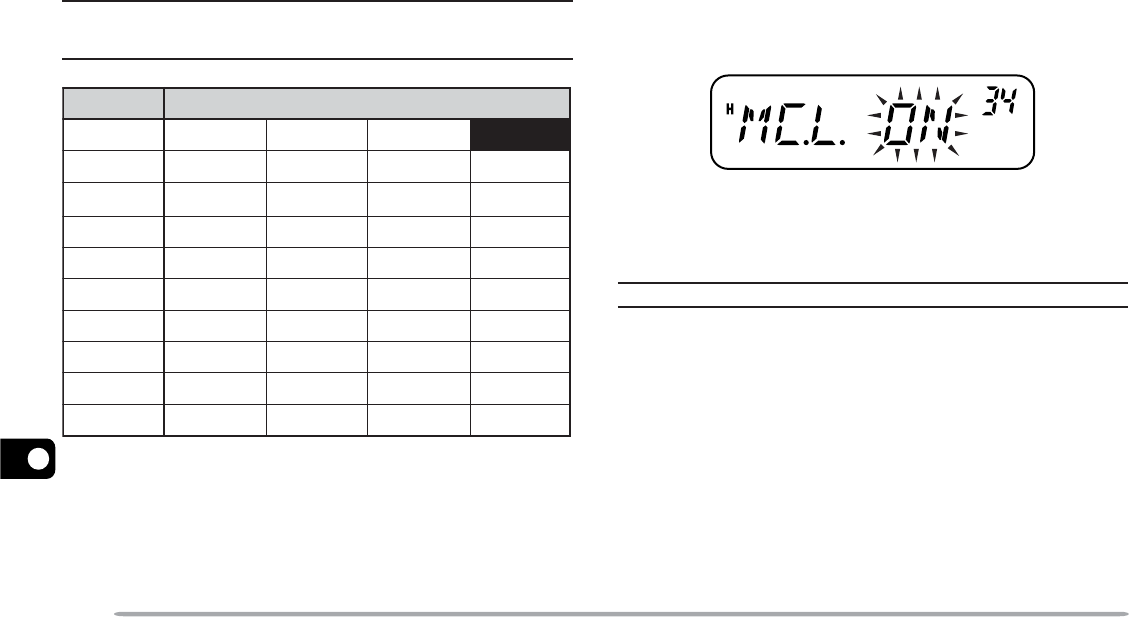
64
12
1DTMF tones are not transmitted in TX Mode if the
DTMF Lock function is ON.
2When transmitting a stored DTMF number, press Mic
[PTT] + Mic [PF], release Mic [PF], then press a
Memory Channel number from 0 to 9. To transmit the
“D” tone, press Mic [PF] again.
Note: When storing a Memory Name or Power-on message, the
DTMF keys can be used. Each time a key is pressed, the displayed
character will change, according to the table below.
yeK sretcarahCdeyalpsiD
1QZ1
2ABC2
3DEF3
4GH I 4
5JKL5
6MNO6
7PRS7
8TUV8
9WX Y 9
0]ecaps[0—/
MIC LOCK
The Mic Lock function disables the Mic PF keys to
prevent you from accidentally changing the transceiver
operation.
1Press [F], [MENU] and turn the Tuning control to
select Menu No. 34 (MC.L).
2Press [MENU] and turn the Tuning control to select
“ON” or “OFF” (default).
3Press [MENU] to store the setting or any other key to
cancel.
4Press any key other than [MENU] to exit Menu Mode.
Note: The Mic Lock function will not lock the DTMF keys.
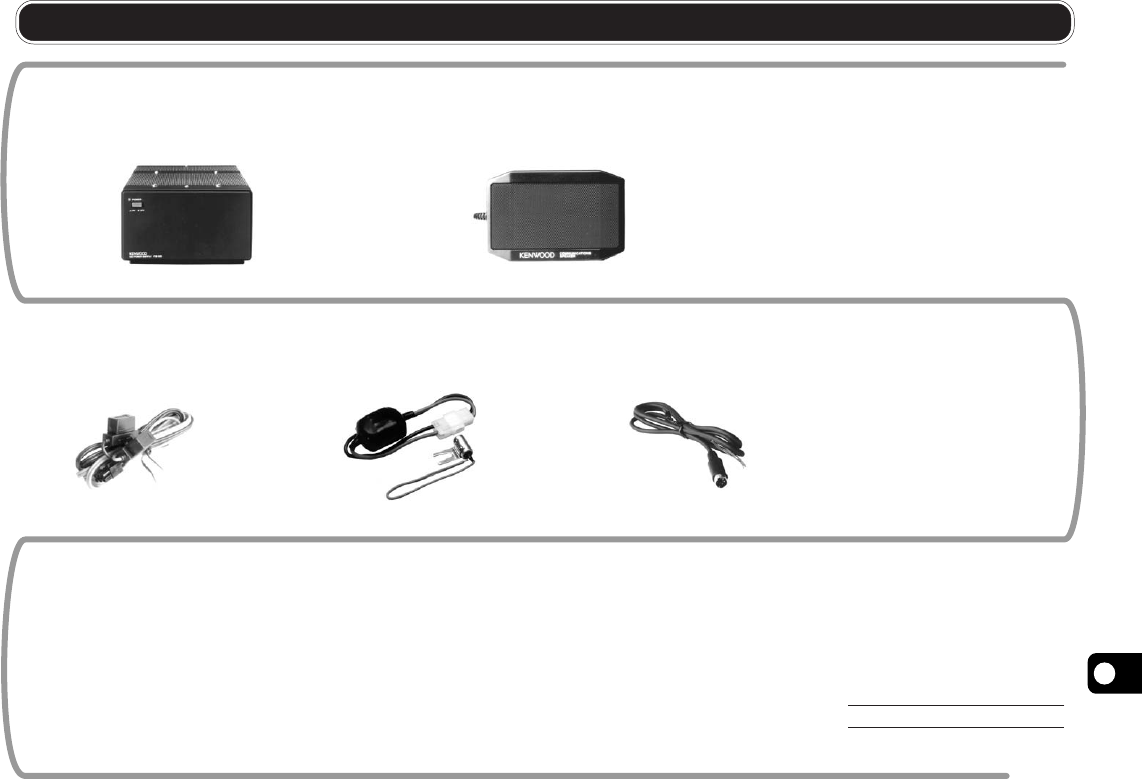
65
13
OPTIONAL ACCESSORIES
MC-60A
Stand Microphone
PG-2N
DC Power Cable
KPG-46
Programming Cable
SP-50B
Communications Speaker
MJ-88
Modular to 8-pin
Microphone Plug
PG-3B
DC Line Noise Filter
MCP-1A
Memory Control Program
(Free Software)
The MCP-1A can be
downloaded at:
http://www.kenwood.com/i/
products/info/amateur.html
KMC-30
Speaker/Microphone
KMC-32
DTMF Speaker/Microphone
PG-5A
Data Cable
(E market only)
PS-33/53
Regulated DC
Power Supply

66
14
TROUBLESHOOTING
MAINTENANCE
GENERAL INFORMATION
This product has been factory aligned and tested to
specification before shipment. Under normal
circumstances, the transceiver will operate in
accordance with these instructions. All adjustable
trimmers, coils, and resistors in the transceiver were
preset at the factory. They should only be readjusted by
a qualified technician who is familiar with this transceiver
and has the necessary test equipment. Attempting
service or alignment without factory authorization can
void the transceiver warranty.
When operated properly, the transceiver will provide
years of service and enjoyment without requiring further
realignment. The information in this section gives some
general service procedures requiring little or no test
equipment.
SERVICE
If it is ever necessary to return this equipment to your
dealer or service center for repair, pack it in its original
box and packing material. Include a full description of
the problems experienced. Include your telephone
number, fax number, and e-mail address (if available)
along with your name and address in case the service
technician needs to call you for further information while
investigating your problem. Do not return accessory
items unless you feel they are directly related to the
service problem.
You may return this product for service to the authorized
KENWOOD dealer from whom you purchased it, or any
authorized KENWOOD service center. A copy of the
service report will be returned with the transceiver.
Please do not send subassemblies or printed circuit
boards; send the complete transceiver.
Tag all returned items with your name and call sign for
identification. Please mention the model and serial
number of the transceiver in any communication
regarding the problem.
SERVICE NOTE
If you desire to correspond on a technical or operational
problem, please make your note short, complete, and to
the point. Help us help you by providing the following:
•Model and serial number of equipment
•Question or problem you are having
•Other equipment in your station pertaining to the problem
•Meter readings
•Other related information (menu setup, mode, frequency,
key sequence to induce malfunction, etc.)
Do not pack the equipment in crushed newspapers for shipment!
Extensive damage may result during rough handling or shipping.

67
14
Note:
◆Record the date of purchase, serial number and dealer from
whom this product was purchased.
◆For your own information, retain a written record of any
maintenance performed on this product.
◆When claiming warranty service, please include a photocopy of
the bill of sale, or other proof-of-purchase showing the date of
sale.
CLEANING
The keys, controls, and case of the transceiver are likely
to become soiled after extended use. Remove the
controls from the transceiver and clean them with a
neutral detergent and warm water. Use a neutral
detergent (no strong chemicals) and a damp cloth to
clean the case.
RESETTING THE TRANSCEIVER
If your transceiver seems to be malfunctioning, resetting
the microprocessor may solve the problem. The
following 2 reset modes are available. When performing
the reset, you may lose memory data and stored
information. Back up or write down important data
before performing the reset.
INITIAL SETTINGS
The factory defaults for the operating frequencies are as
follows.
•Transceiver: 144.000 MHz
•Weather Alert Channel (K market only): 162.550 MHz
The Memory Channels have no data stored. Refer to
pages 25 and 56 for the Call Channel and frequency
step size default values.
Note: When in Channel Display Mode, you cannot perform VFO
reset or Full reset.
FULL RESET
This resets all transceiver parameters to the factory
default values. There are two methods available for
resetting the transceiver.
Full Reset Method 1:
1With the transceiver power OFF, press [F]+[ ]
(Power).
•All indicators light momentarily, followed by the full reset
confirmation message.
2Press [F].
•“SURE ?” appears.
3Press [F] again to reset the transceiver.
•“WAIT” appears momentarily.
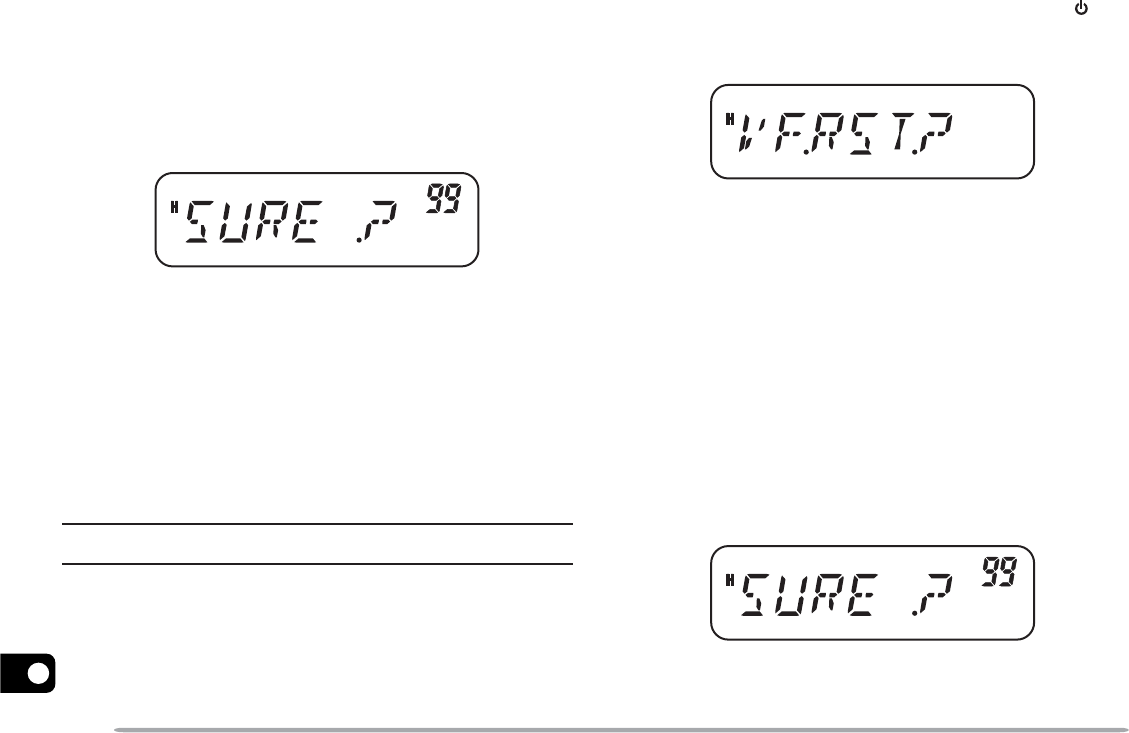
68
14
Full Reset Method 2:
1Press [F], [MENU] and turn the Tuning control to
select Menu No. 99 (RESET).
2Press [MENU] and turn the Tuning control to select
“FULL”.
3Press [MENU].
•“SURE ?” appears.
4Press [MENU] to reset the transceiver or any other
key to cancel.
•“WAIT” appears momentarily.
VFO RESET
This resets the transceiver parameters excluding the
DTMF Memory, the Memory channel contents, and the
Call channel contents. There are two methods available
for resetting the transceiver.
Note: Menu No. 7 (P.VFO) and Menu No. 10 (OFFSET) return to the
factory default values.
VFO Reset Method 1:
1With the transceiver power OFF, press [VFO]+[ ]
(Power).
•The VFO reset confirmation message appears.
2Press [VFO].
•“SURE ?” appears.
3Press [VFO] again to reset the transceiver.
•“WAIT” appears momentarily.
VFO Reset Method 2:
1Press [F], [MENU] and turn the Tuning control to
select Menu No. 99 (RESET).
2Press [MENU] and turn the Tuning control to select
“VFO”.
3Press [MENU].
•“SURE ?” appears.
4Press [MENU] to reset the transceiver or any other
key to cancel.

69
14
TROUBLESHOOTING
The problems described in the following tables are commonly encountered operational malfunctions. These types of
difficulties are usually caused by improper hook-up, accidental incorrect control settings, or operator error due to
incomplete programming. These problems are usually not caused by circuit failure. Please review these tables and the
appropriate section(s) of this instruction manual before assuming your transceiver is defective.
melborP esuaCelbaborP noitcAevitcerroC .feRegaP
tonlliwreviecsnartehT
gnitcennocretfapurewop
ylppusrewopCDV8.31a
ehtgnisserpdna ][
)rewoP(gnihtoN.hctiws
.yalpsidehtnosraeppa
1sawelbacrewopehT
.sdrawkcabdetcennoc
1elbacrewopCDdeilppusehttcennoC
:yltcerroc
deR →kcalB;)+( →.)–(
3
2rewopehtfoeromroenO
.nepoerasesufelbac
2.)s(esufnwolbehtfoesuacehtrofkooL
ynagnitcerrocdnagnitcepsniretfA
ehthtiw)s(esufwenallatsni,smelborp
.sgnitaremas
5
,midootsiyalpsidehT
detcelesuoyhguohtneve
.levelssenthgirbhgiha
.wolootsiegatlovylppusehTsitnemeriuqeregatlovylppusehT
CDV8.31 ±.)CDV8.51otV7.11(%51
,egnarsihtedistuosiegatlovtupniehtfI
ro/dnaylppusrewopdetalugerruoytsujda
.snoitcennocelbacrewopllakcehc
4,3
ebtonnacycneuqerfehT
ehtgninrutybdetceles
gninuT ybrolortnoc
ciMgnisserp ]PU[ /]NWD[ .
.detcelessawllaceRyromeMsserP ]OFV[ .51,03
ehtdnasyek/snottubtsoM
gninuT tonodlortnoc
.noitcnuf
.NOsisnoitcnufkcoLehtfoenO.snoitcnufkcoLehtfollakcolnU,85,35
46

70
14
melborP esuaCelbaborP noitcAevitcerroC .feRegaP
tonnacslennahCyromeM
ehtgninrutybdetceleseb
gninuT ybrolortnoc
ciMgnisserp ]PU[ /]NWD[ .
ynaniderotsneebsahatadoN
.slennahCyromeM
.slennahCyromeMemosniataderotS92
nevetimsnarttonnacuoY
ciMsserpuoyhguoht
]TTP[ .
1tonsawgulpenohporcimehT
ehtotniyletelpmocdetresni
.rotcennoclenaptnorf
1ehttresnineht,rewopehtFFOhctiwS
batgnikcolehtlitnugulpenohporcim
.ecalpniskcilc
6
2tesffotimsnartadetcelesuoY
timsnartehtsecalptaht
ehtedistuoycneuqerf
ycneuqerftimsnartelbawolla
.egnar
2sserP ]F[ ,]UNEM[ ehtnrutdna gninuT
.)TFS(5.oNuneMtcelesotlortnoc
sserP ]UNEM[ ehtnrutdna gninuT
sserP.”FFO“tcelesotlortnoc ]UNEM[
yekynasserpneht,gnittesehterotsot
nahtrehto ]UNEM[ .edoMuneMtixeot
32
3siCNTlanretxeehT
.gnittimsnart
3ciMsserP ]TTP[ sahCNTehtretfa
.gnittimsnartdehsinif
—
